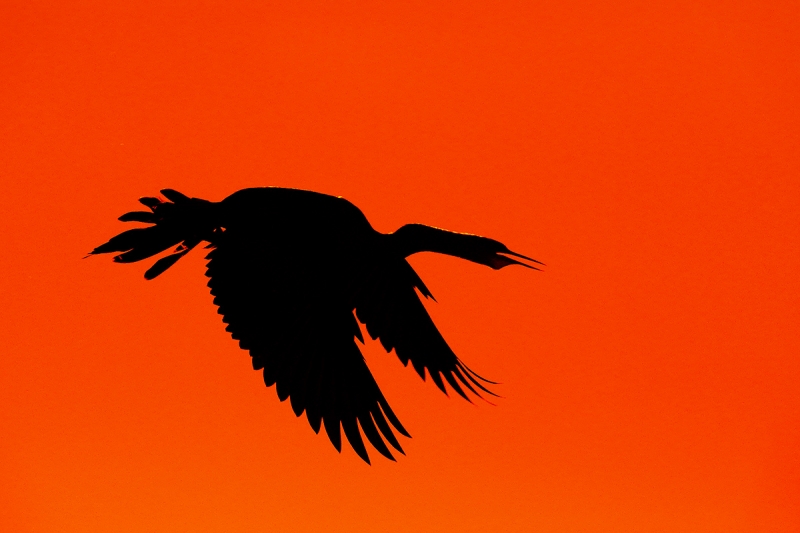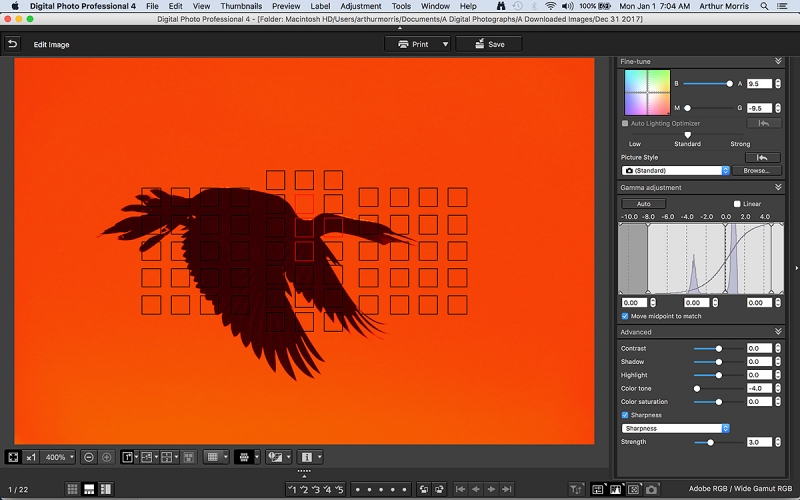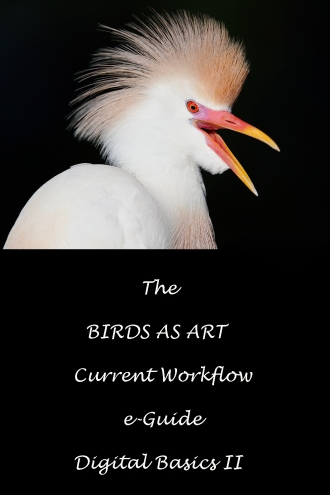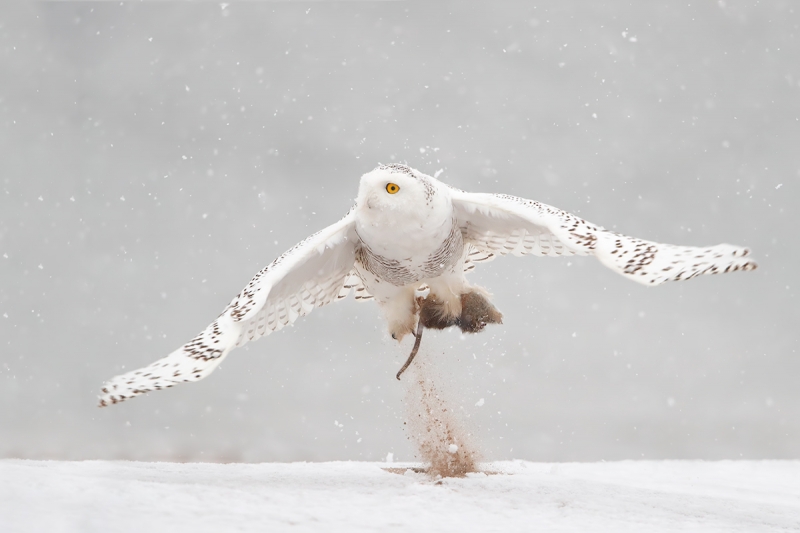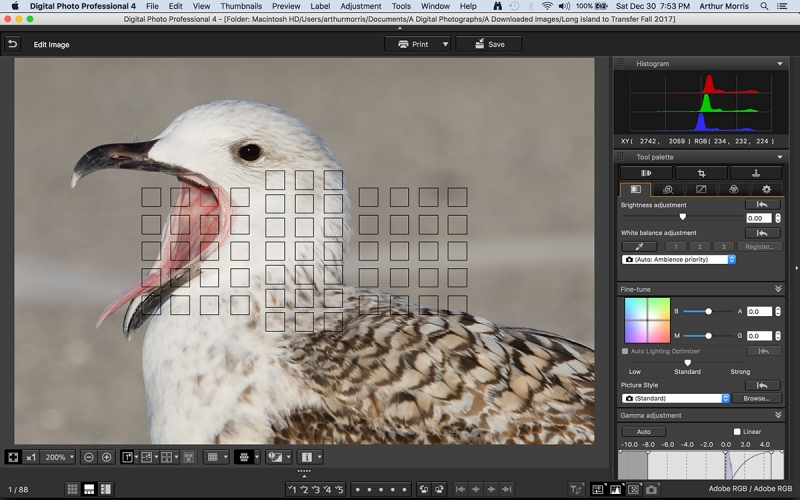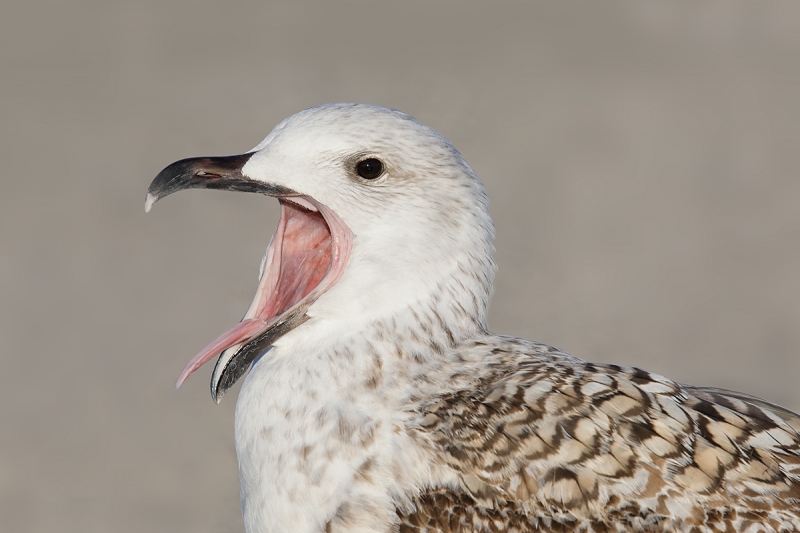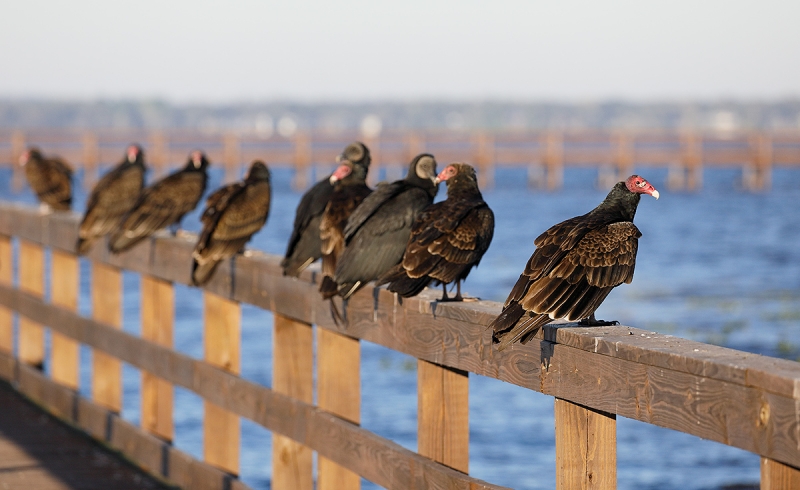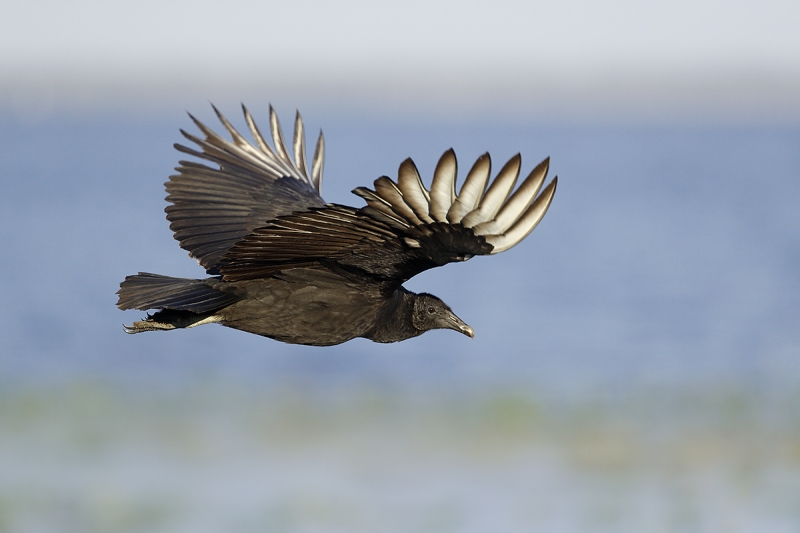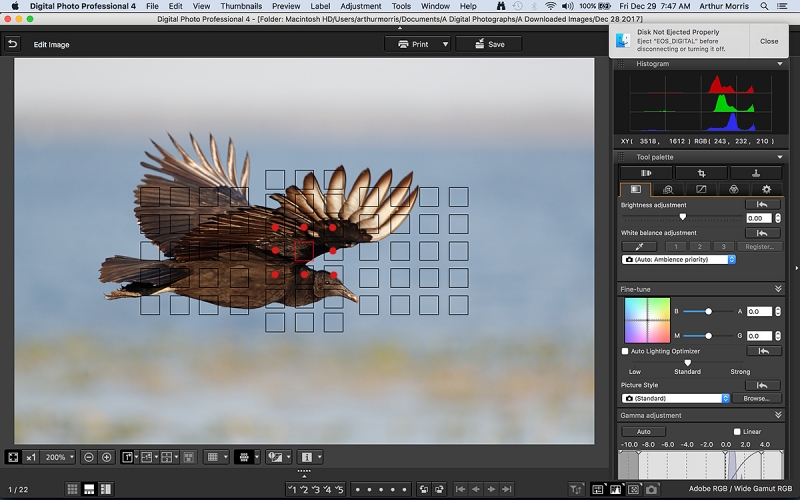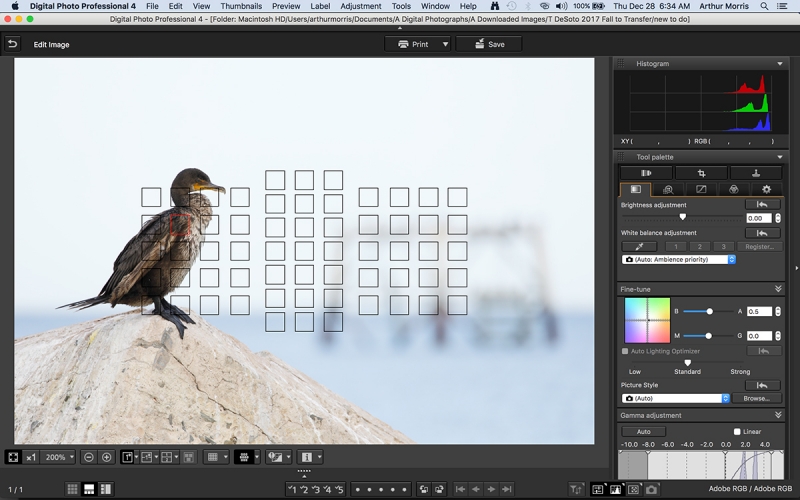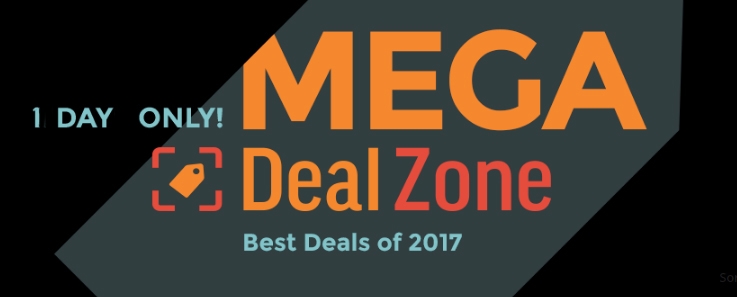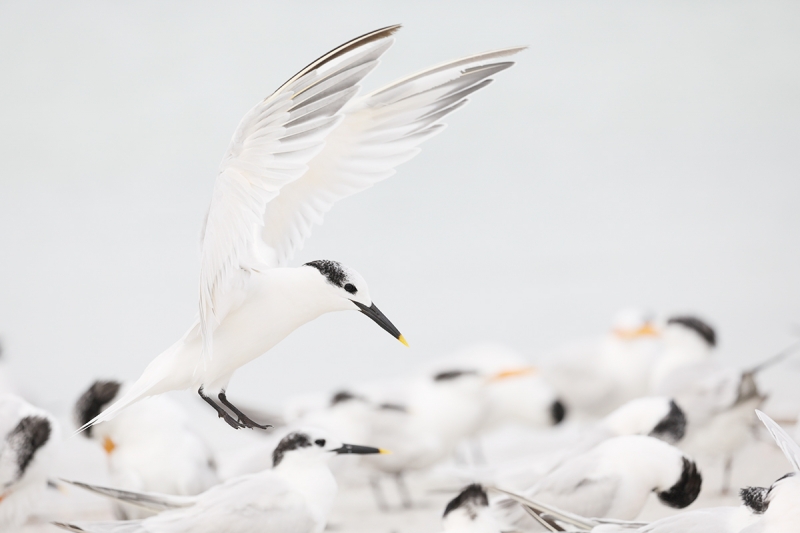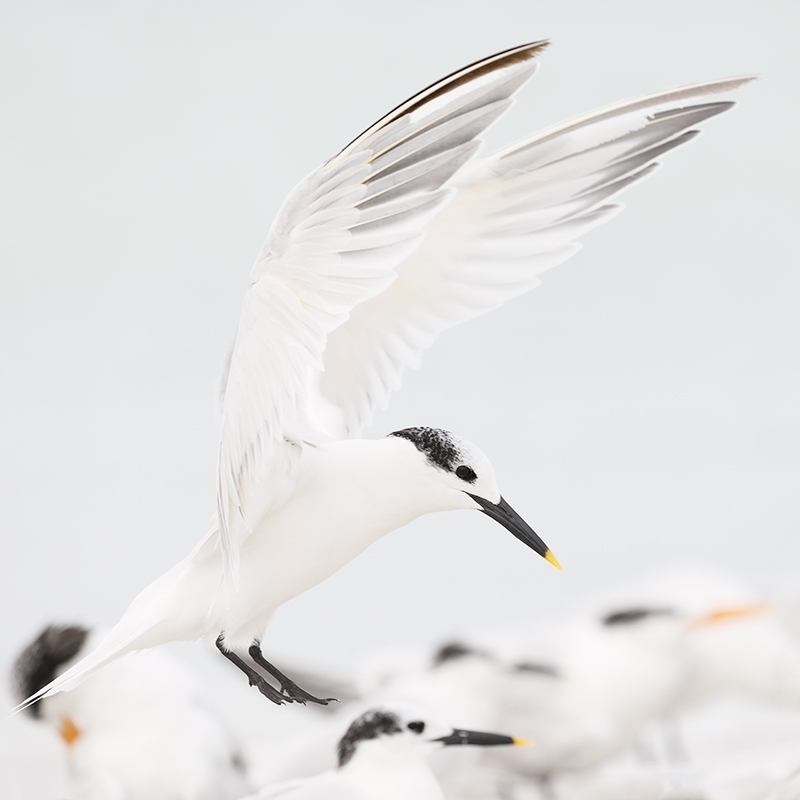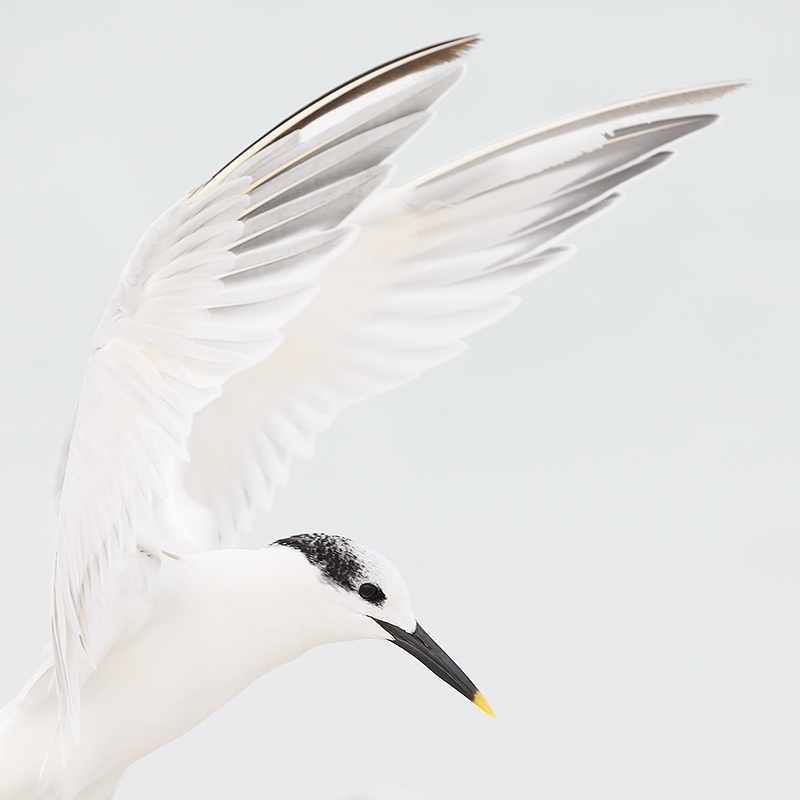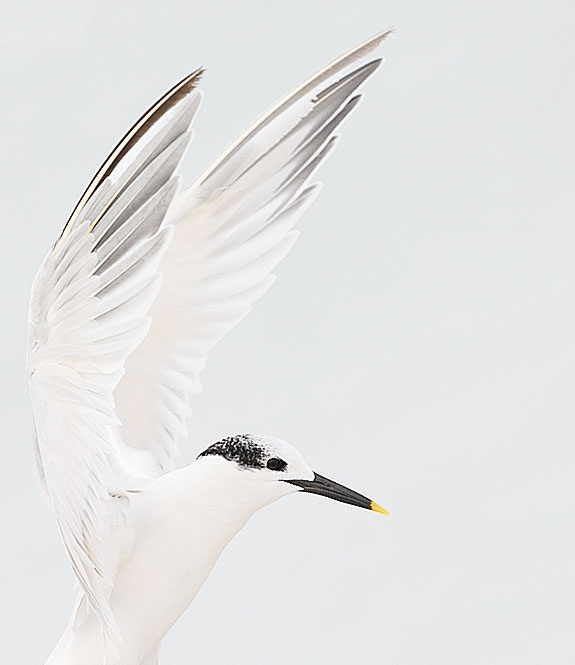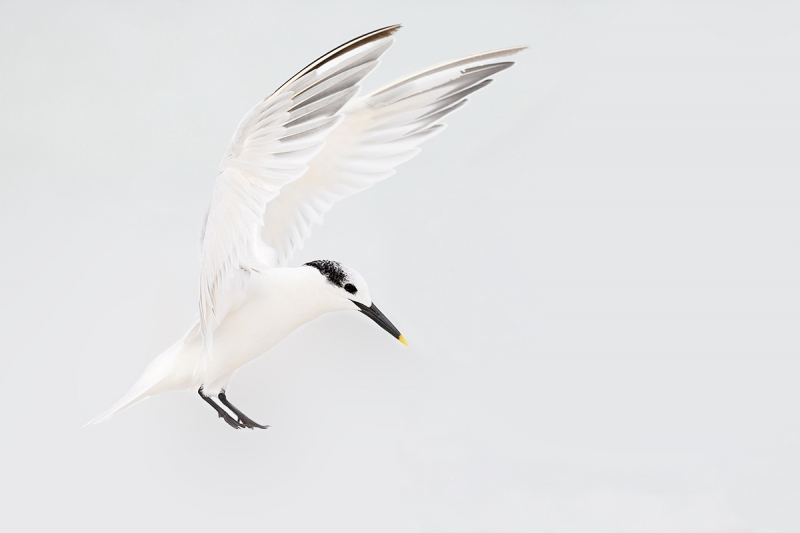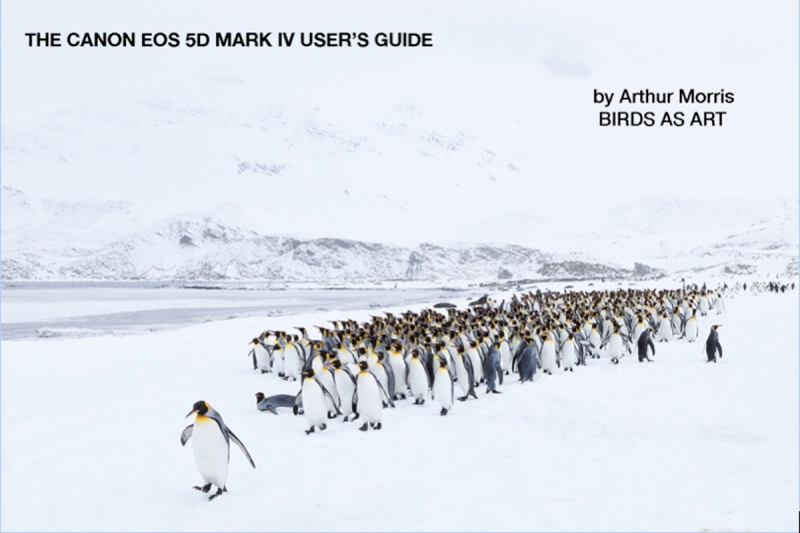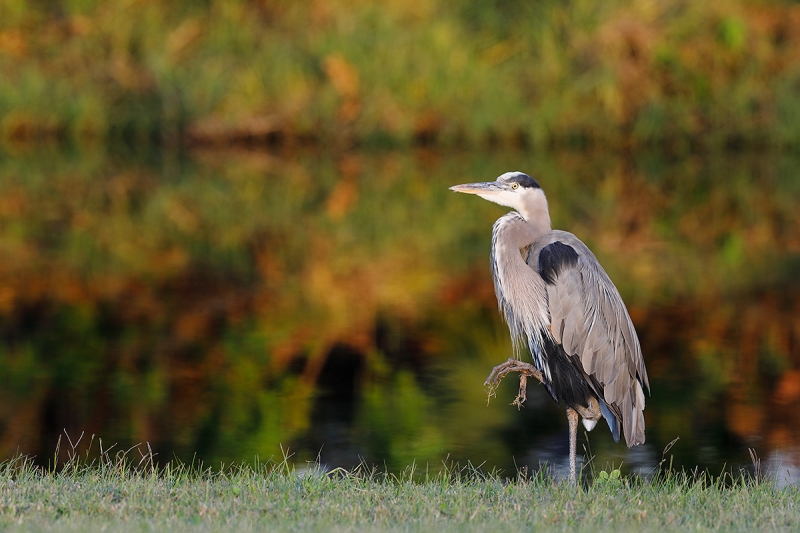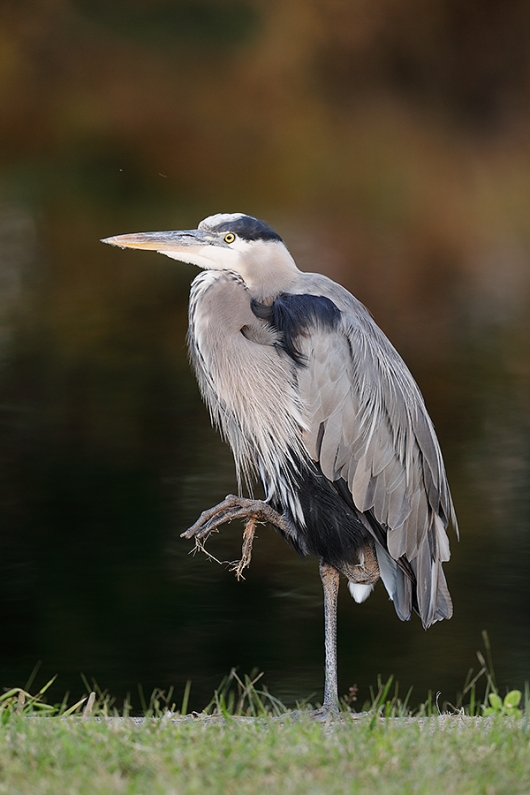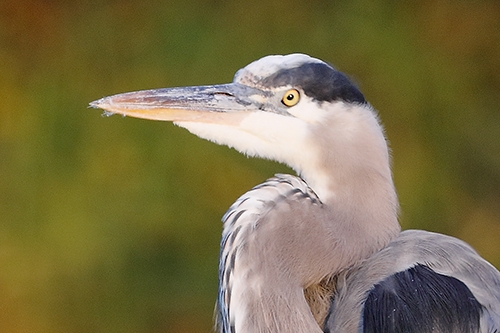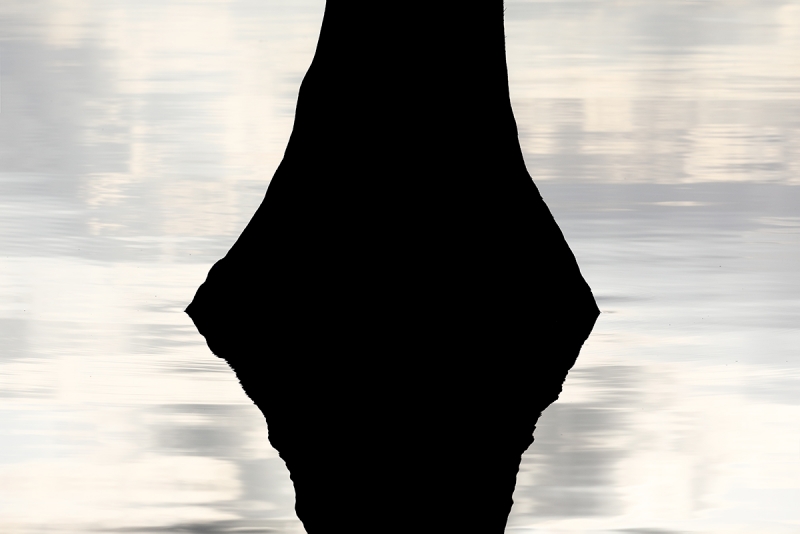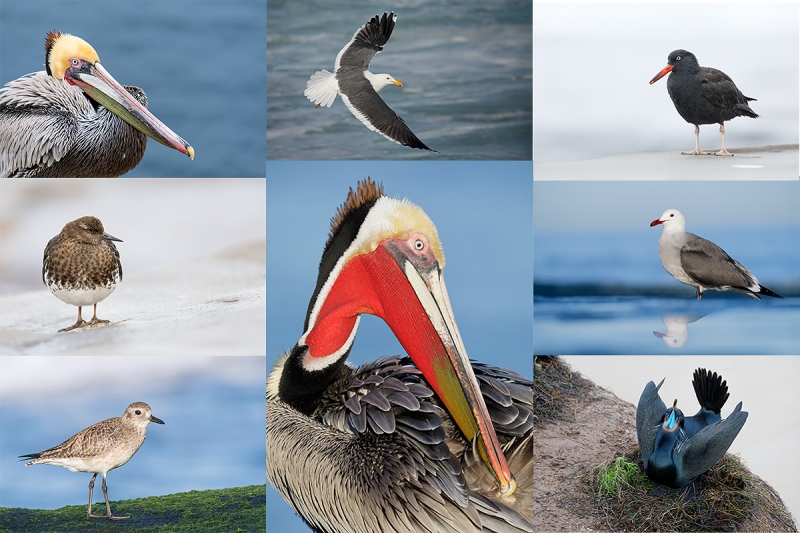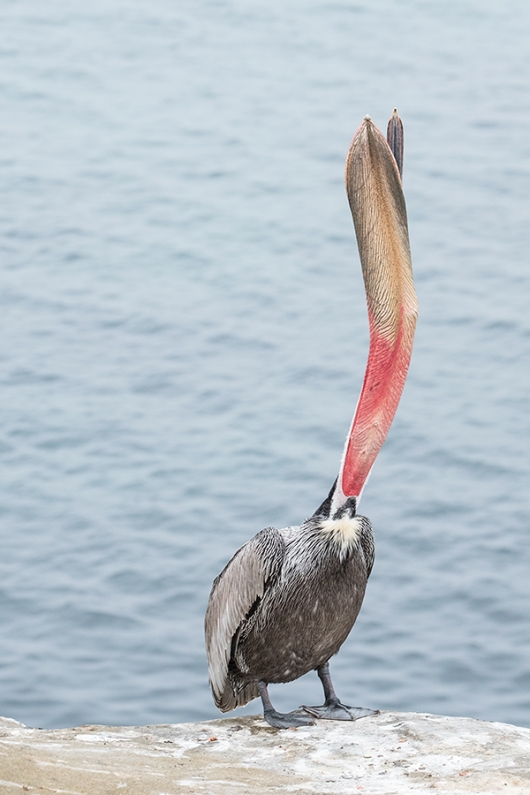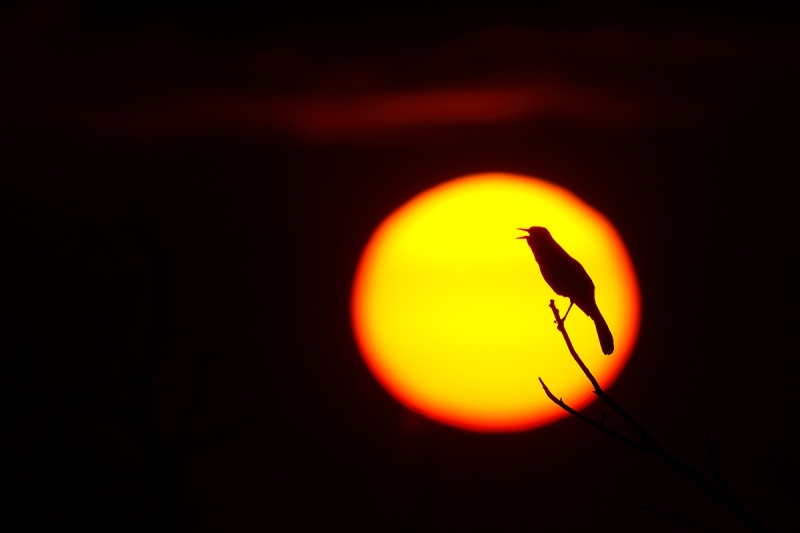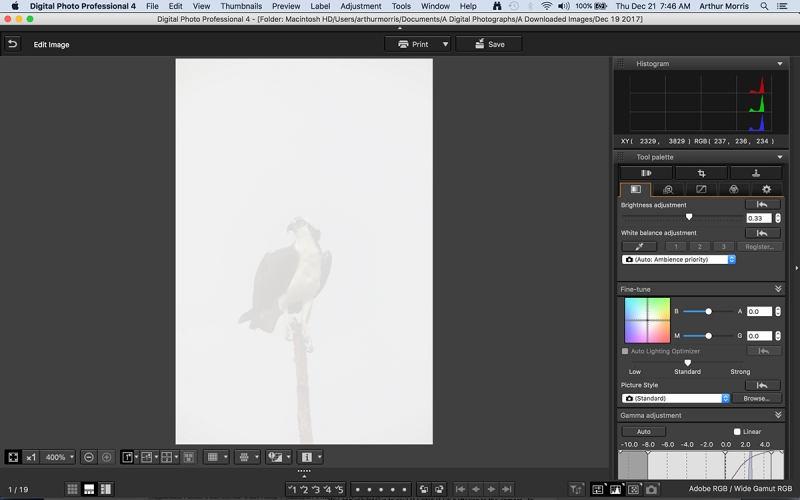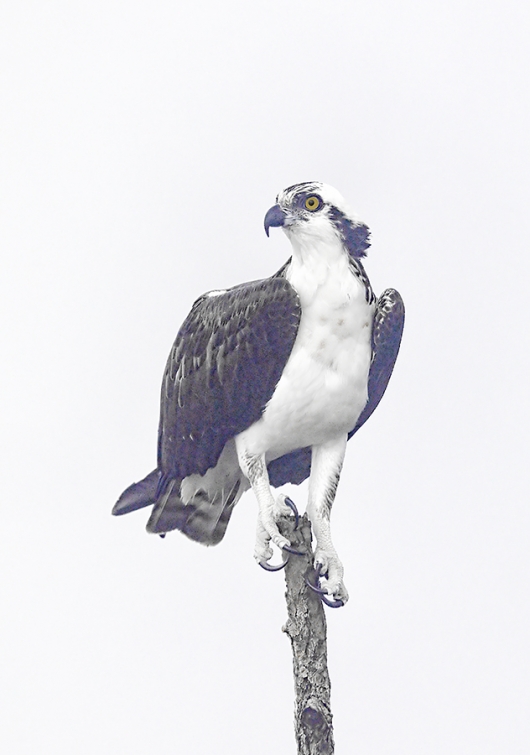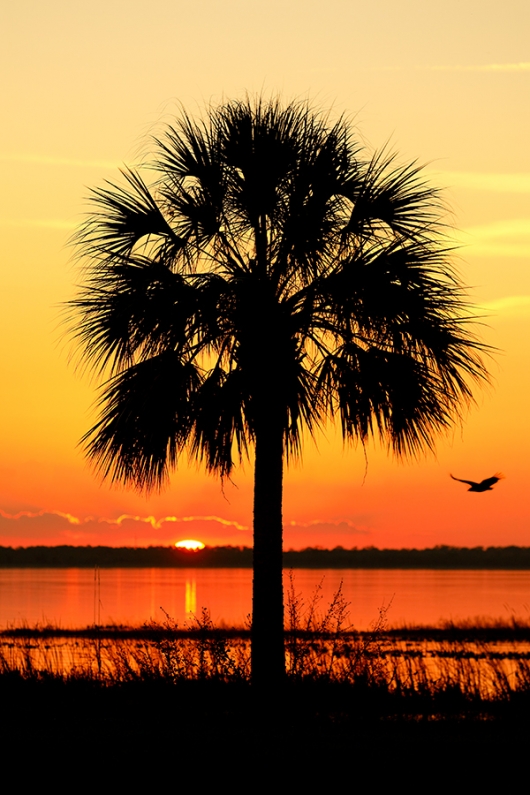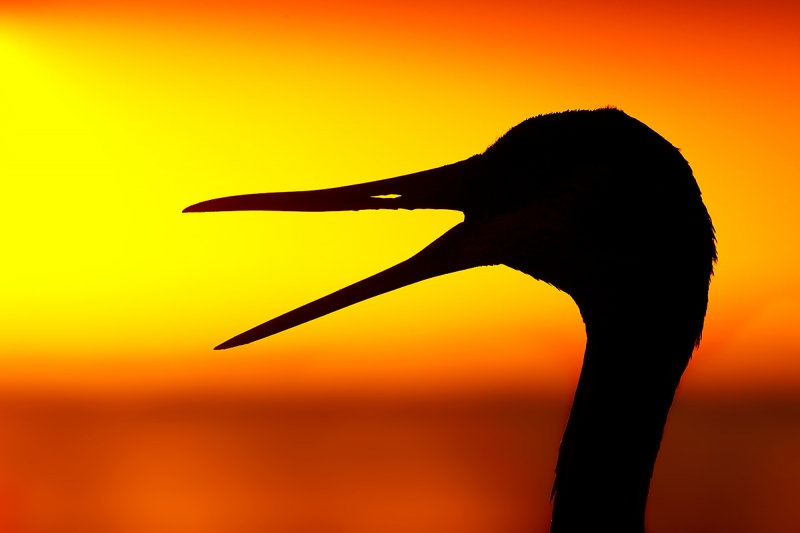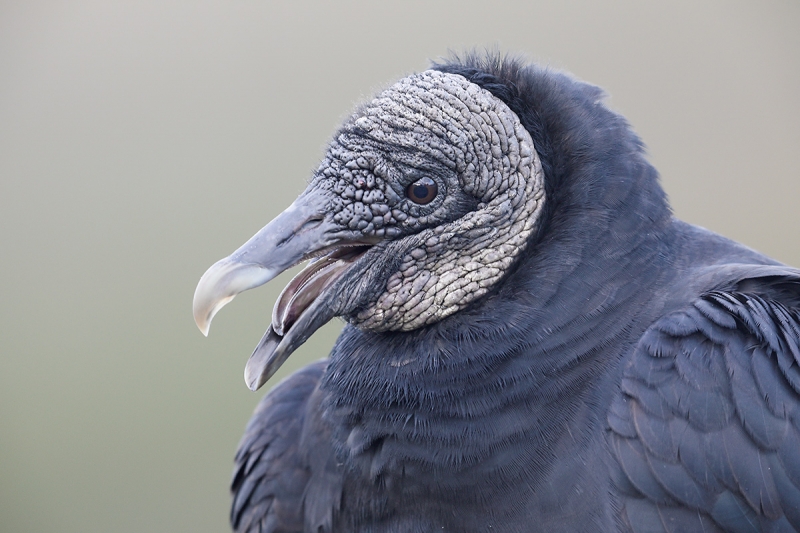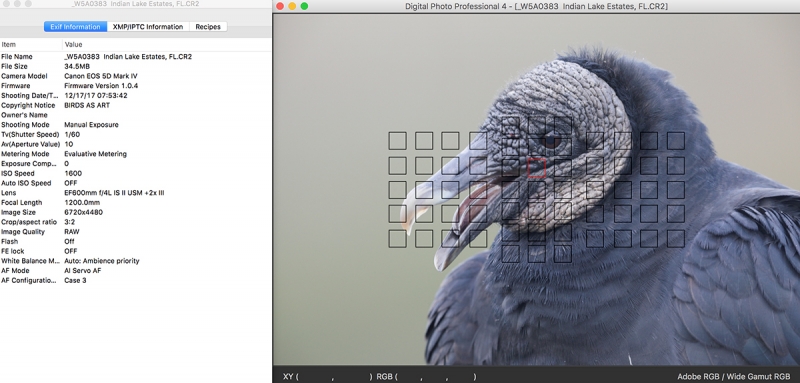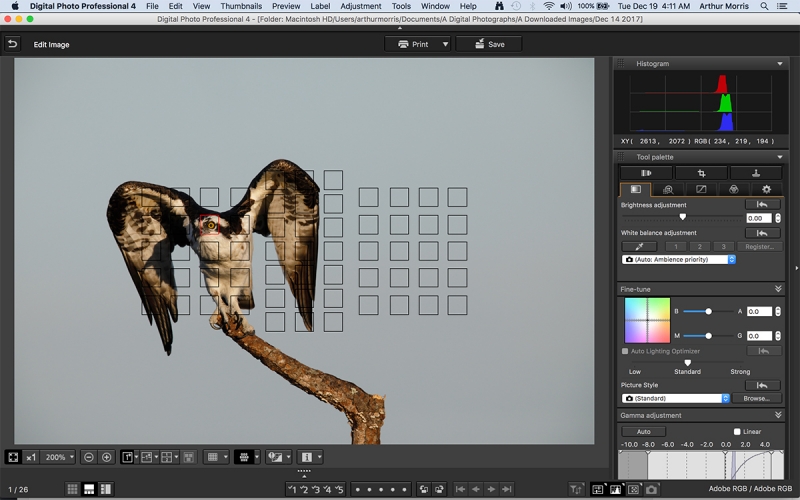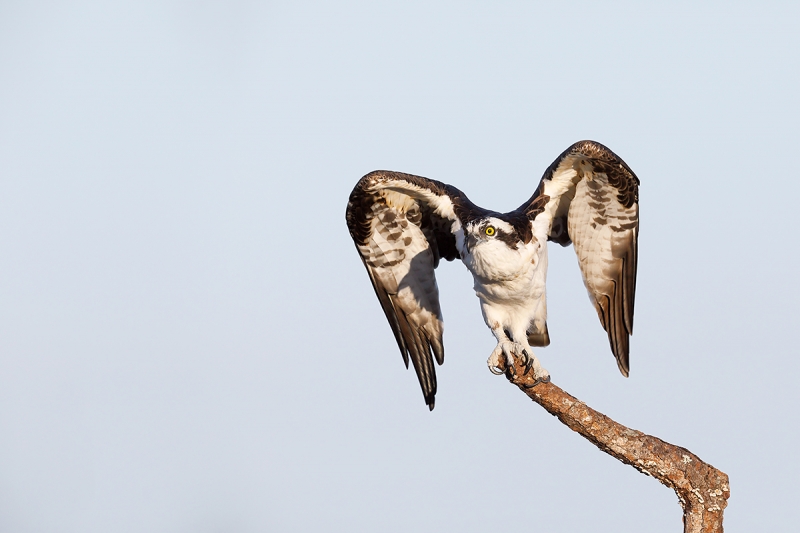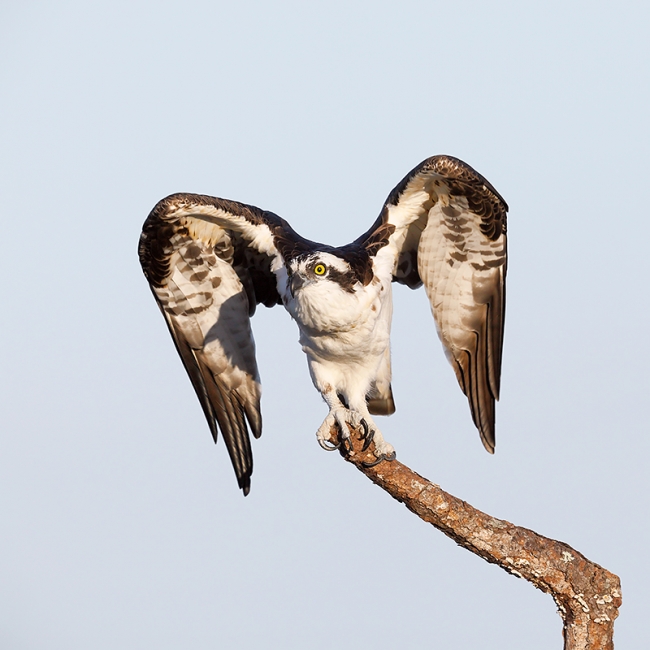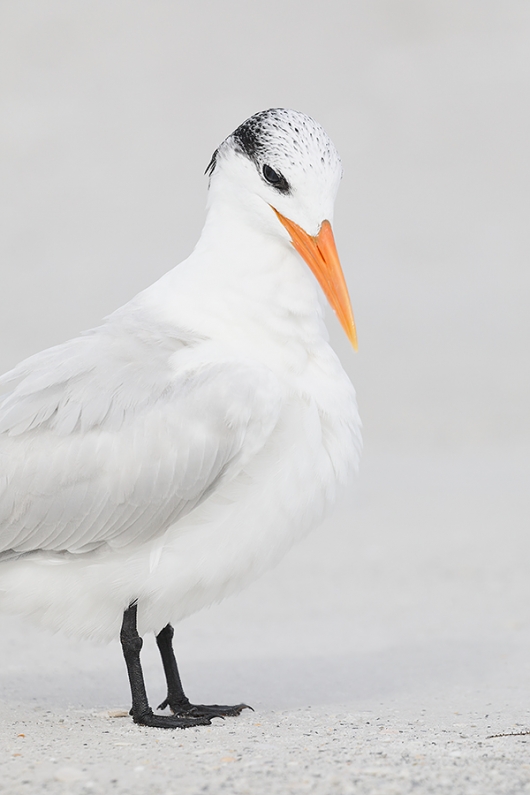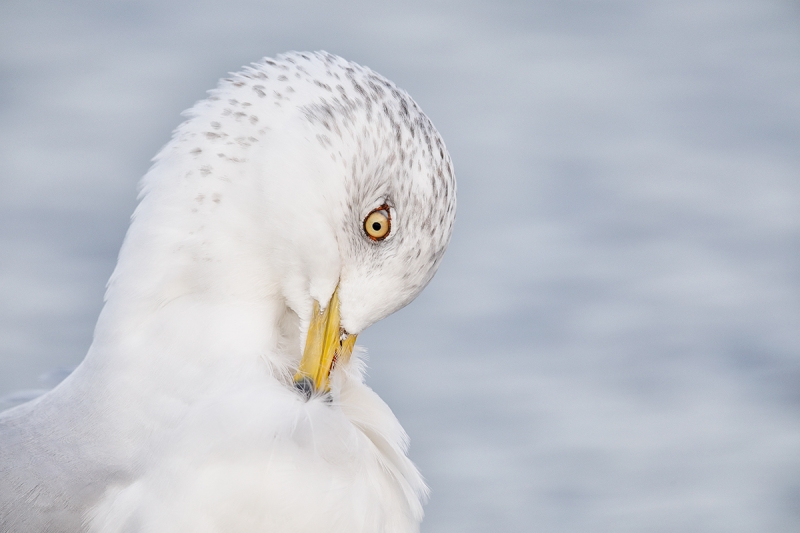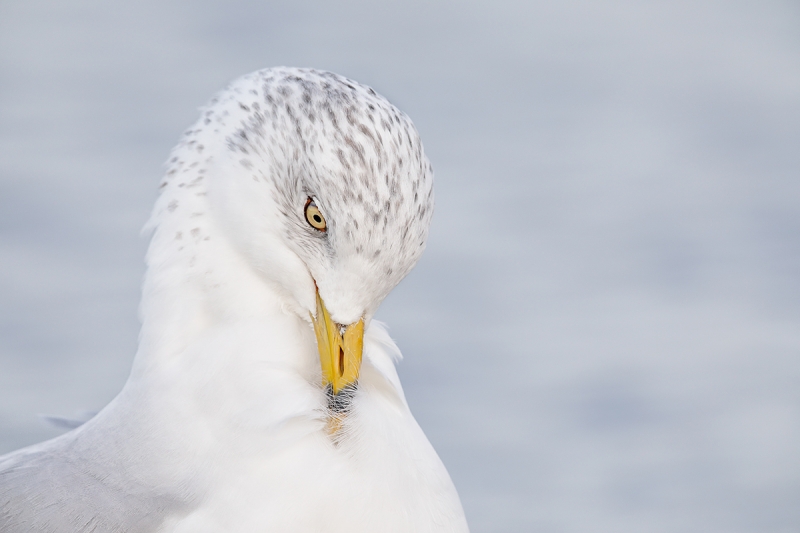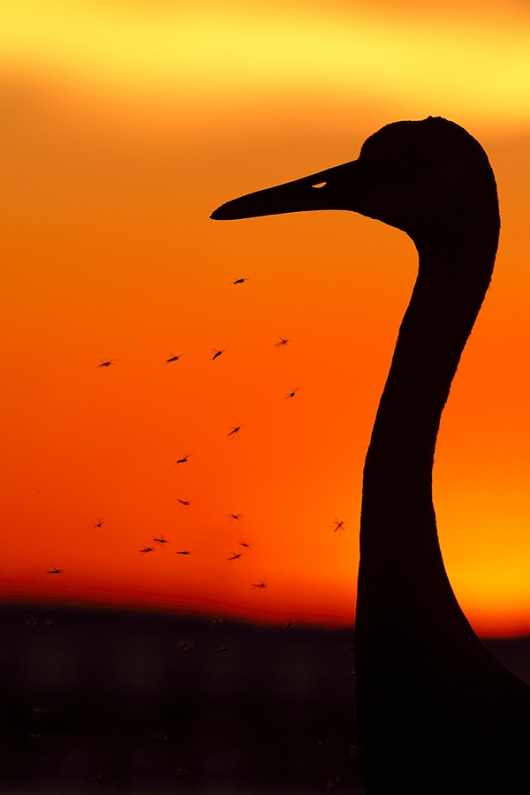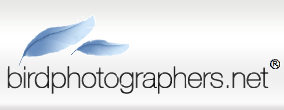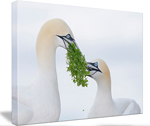January 2nd, 2018 Stuff
I was hoping for clouds so that I could finish my micro-adjusting; with long effective focal lengths I work outdoors with the lights. It was very cloudy to start but in the middle of the two and one-half hour session the sun was peeking in and out so I set up a tripod with an Umbrella Clamp Rig and used my large Canon golf umbrella to shade the front of the 600 II. It worked perfectly. By 11am it was cold and raining hard. I packed up a big box of lenses that Jim will ship to San Diego for the two IPTs.
Mazel tov to UCF (University of Central Florida) for their great victory over heavily favored Auburn in the Peach Bowl. By 4pm it was cold and windy and raining so I got into the 75.6 degree water and swam 3/4 mile. It felt great. And the pool lights turned on and off perfectly.
I fly to Phoenix late today, Tuesday January 2, 2018.
Click on the logo-link above for great holiday savings!
$300 off on the Canon 100-400 II!
The Streak
Today makes one hundred fifty-six days in a row with a new educational blog post! This one took less than an hour to prepare including the time spent optimizing the image. With all of my upcoming free time (or not …), the plan right now is to break the current record streak of 480 … Good health and good internet connections and my continuing insanity willing.
Booking.Com
Booking.Com came through for me twice again recently with both the DeSoto Fall IPT and next July’s UK Puffins, Gannets, and Bempton Pre-trip room reservations. And all the rates were great. If you’d like to give Booking.Com a shot, click here and you will earn a $25 reward. Thanks to the many who have already tried and used this great service.
Gear Questions and Advice
Too many folks attending BAA IPTs and dozens of folks whom I see in the field, and on BPN, are–out of ignorance–using the wrong gear especially when it comes to tripods and more especially, tripod heads… Please know that I am always glad to answer your gear questions via e-mail. Those questions might deal with systems, camera bodies, accessories, and/or lens choices and decisions.
|
|
|
This image was created down by the lake near my home at Indian Lake Estates, FL on the evening of Sunday, December 31, 2017. I used the Induro GIT304L Grand Series 3 Stealth Carbon Fiber Tripod/Mongoose M3.6-mounted Canon EF 600mm f/4L IS II USM lens, the Canon Extender EF 2X III, and my favorite silhouette photography camera body, the Canon EOS 5D Mark IV. ISO 800. Evaluative metering +1/3 stop in Av mode: 1/2500 sec. at f/9 was a bit of an under-exposure. WB: K7500 at 5:40pm on a dead clear sunset.
LensAlign/FocusTune micro-adjustment: -10.
Center Large Zone/AI Servo/Shutter button AF was active at the moment of exposure. The system performed perfectly as seen in the DPP 4 screen capture below. Click on the image for a larger version.
Anhinga: sunset take-off, headed for 2018
|
Anhinga, headed for 2018
This bird has been becoming more and more dependable for the past week; it sits on The Perch almost every night. For the most part it does nothing but just before it is gonna fly it does a really neat head down wing stretch. I got a few images of that last night but in the best ones the bill merged with the perch … I immediately rotated the lens in the barrel and went to horizontal format for the take-off. I had been concentrating so hard on not missing the action that I was getting a headache. And every five minutes I had to move the tripod to my left in the deep muck to stay on the brightest part of the sky as the sun moved down and west, to my right. If the bird had flown when I was re-locating in the mud I would have come up empty, again. I was quite happy when I saw this one on the rear LCD and even happier when I saw it on my Macbook Pro.
|
|
DPP 4 screen capture for today’s featured image
|
DPP 4 Screen Capture for Today’s Featured Image
I have been preaching the benefits of using Large Zone AF here on the blog and in the 5D Mark IV User’s Guide as well. Last night it performed perfectly when the Anhinga jumped off its perch. (The bird always flies to the northwest regardless of the direction of the wind.) Note the three AF points illuminated in red, one on the neck and two on the base of the far wing. As I said, perfection.
I probably made more adjustments to this image in DPP 4 than I have made to any image that I have ever converted. You can see that I juiced up the color by moving the Color fine-tune dot all the way to the RED corner. For the first time ever I experimented with the Color tone slider and wound up liking it set all the way to the left. What you cannot see is that I did a lot of work on the Adjust image colors tab; for both the RED and ORANGE I moved the Saturation slider to +10 and the Luminance slider to -10.
A Great New DDP 4 Noise Reduction Technique!
I have been noticing on these sunset silhouettes that luminance noise with the dark RED and the dark ORANGE background tones can be problematic so I tried a brand new approach: after using the Noise Reduction recipe for ISO 1600 (instead of the recipe for ISO 800 because of the underexposure), I enlarged the image to 400% to check the background noise. Then, working on the Adjust image detail tab, I moved the slider for Luminance noise all the way up to 12 at which point the luminance noise disappeared completely. Live and learn.
Once I brought the TIFF file in Photoshop I tweaked the color a bit more and deepened the BLACKs with a Levels Adjustment. I even added CYAN to the BLACKs in Selective Color to take the RED out.
The Big Question Is!
The big question: “In your humble opinion is the background color too garish?
From Merriam-Webster: excessively or disturbingly vivid; offensively or distressingly bright : glaring.
From Dictionary.com: crudely or tastelessly colorful, showy, or elaborate, as clothes or decoration.
Coming Soon
February 2018 Spoonbill Boat IPT (definite!)
Two Fort DeSoto IPTs (April and May, 2018)
Three Gatorland IPTs (March, April, and May, 2018 — including early entry and late stay — tentative)
Three Sandhill Crane chicks and colts Master Classes at Indian Lake Estates (March)
The Master Classes will be small groups — strictly limited to four photographers — with the first folks who register staying at my home and the others staying at a chain motel in Lake Wales. Live, think, and breathe photography from Friday afternoon through lunch on Monday morning; all meals included. We will enjoy three morning photography sessions with the main subjects being tame Sandhill Cranes almost surely with chicks or colts. Also vultures and Cattle Egrets and more. Limpkins possible. There will be three afternoon photo sessions with hopefully glorious sunsets like the ones you have been seeing on the blog recently. I will micro-adjust one of your lenses during a group instructional session and all will be welcome to practice what they have learned during the breaks. We will sit together around my dining room table and pick everyone’s keepers, enjoy guided Photoshop sessions, and, on Monday before lunch, folks can make a single large print of their favorite image.
Folks who would like advance notice on any of the above are welcome to shoot me an e-mail.
Folks who would like advance notice on any of the above are welcome to shoot me an e-mail.
|
|
|
The BIRDS AS ART Current Workflow e-Guide (Digital Basics II) will teach you an efficient Mac or PC/Photo Mechanic/Photoshop workflow that will make it easy for you to make your images better in Photoshop (rather than worse). That true whether you convert your images in DPP 4 or ACR. See the blog post here to learn lots more and to read a free excerpt.
You can order your copy from the BAA Online Store here, by sending a Paypal for $40 here, or by calling Jim or Jennifer weekdays at 863-692-0906 with your credit card in hand.
|
The BIRDS AS ART Current Workflow e-Guide (Digital Basics II)
Your guessed it, everything mentioned above (and tons more) is covered in detail in the BIRDS AS ART Current Workflow e-Guide (Digital Basics II), an instructional PDF that is sent via e-mail. Learn more and check out the free excerpt in the blog post here. While the new e-Guide reflects my Macbook Pro/Photo Mechanic/DPP 4/Photoshop workflow, folks using a PC and/or BreezeBrowser will also benefit greatly by studying the material on DB II. Do note that you will find the RGB Curves Adjustment Color Balancing tutorial only in the new e-guide. Note: folks working on a PC and/or those who do not want to miss anything Photoshop may wish to purchase the original Digital Basics along with DB II while saving $15 by clicking here to buy the DB Bundle.
The two most recent and many of the older MP4 Photoshop Tutorial videos releases go hand and hand with the information in DB II):
- The Wingtip Repairs MP4 Video here.
- The MP4 Crow Cleanup Video here.
Folks who learn well by following along rather than by reading can check out the complete collection of MP 4 Photoshop Tutorial Videos by clicking here.
You can learn how and why I and other discerning Canon shooters convert nearly all of their Canon digital RAW files in DPP 4 using Canon Digital Photo Professional in the DPP 4 RAW conversion Guide here. And you can learn advanced Quick Masking and advanced Layer Masking techniques in APTATS I & II. You can save $15 by purchasing the pair. Folks can learn sophisticated sharpening and (NeatImage) Noise Reduction techniques in the The Professional Post Processing Guide by Arash Hazeghi and yours truly.
Support the Blog
Please help support my (stupendous) efforts here on the blog by remembering to click on the logo link above each time that you shop Amazon. That would be greatly appreciated. There is no problem using your Prime account; just click on the link and log into your Prime account. With love, artie
If In Doubt …
If in doubt about using the BAA B&H affiliate link correctly, you can always start your search by clicking here. Please note that the tracking is invisible. Web orders only. Please, however, remember to shoot me your receipt via e-mail.




Please Remember to use my Affiliate Links and to Visit the New BAA Online Store 🙂
To show your appreciation for my continuing efforts here, we ask, as always, that you get in the habit of using my B&H affiliate links on the right side of the blog for all of your photo and electronics purchases. Please check the availability of all photographic accessories in the New BIRDS AS ART Online Store, especially the Mongoose M3.6 tripod head, Wimberley lens plates, Delkin flash cards and accessories, and LensCoat stuff.
As always, we sell only what I have used, have tested, and can depend on. We will not sell you junk. We know what you need to make creating great images easy and fun. And please remember that I am always glad to answer your gear questions via e-mail.
I would of course appreciate your using our B&H affiliate links for all of your major gear, video, and electronic purchases. For the photographic stuff mentioned in the paragraph above, and for everything else in the new store, we, meaning BAA, would of course greatly appreciate your business. Here is a huge thank you to the many who have been using our links on a regular basis and those who will be visiting the New BIRDS AS ART Online Store as well.
Facebook
Be sure to like and follow BAA on Facebook by clicking on the logo link upper right. Tanks a stack.
Typos
In all blog posts and Bulletins, feel free to e-mail or to leave a comment regarding any typos or errors. Just be right :).
January 1st, 2018 Happy 2018
Jim Litzenberg, Jennifer Morris, and I hope that each and every one of you and your friends and family you has a great 2018 filled with peace, love, accomplishment, success, travel, wonderful images, and good health. We thank you from the bottom of our hearts for a great 2017; without the support we receive from each of you, BIRDS AS ART would not exist; I would be working as a greeter in Walmart.
Stuff
When I woke Sunday morning I was concerned about the fact that my 600II/2XII/5DIV would not focus the previous evening. Was it the lens, the TC, or the camera body? I had lots of ideas as to how to find a solution. Turns out the the AF switch was on M. Duh! Can you say “operator error”? All of course is fine.
Sunday morning — cold and still — was, with a northwest breeze developing, fair to lousy for photography with only a few vulture flight shot keepers. The evening was much better. I am really getting into rhythm with the Anhinga that sits on The Perch most late afternoons: showing rare patience I managed one spectacular take-off image. Coming soon.
I spent a good part of the morning micro-adjusting my new (still oil spattering) Canon EOS-1DX II with my 100-400 II and my 1.4X III ii at both the long and short ends. The system extrapolates the correct micro-adjustment for focal lengths between 100 and 400mms and between 140 and 560mms with the TC. I also micro-adjusted the 1DX II with the 600 alone. On Monday morning, in about 90 minutes, I will finish up by MA-ing the 1DX II with the 600 II, the 1,4X III i, and the 2X III i. The last chore with be the 1DX II with the 400 DO II and the 2X III ii.
The pool temps continued to drop so I used my new snorkeling vest and kept myself fairly warm for another easy mile. It was the first time that I had done a mile four days in a row. Soon I will be one month without swimming.
Click on the logo-link above for great holiday savings!
$300 off on the Canon 100-400 II!
The Streak
Today makes one hundred fifty-five days in a row with a new educational blog post! This one took less than an hour to prepare including the time spent optimizing the image. With all of my upcoming free time (or not …), the plan right now is to break the current record streak of 480 … Good health and good internet connections and my continuing insanity willing.
Brand New Listings
Canon EF 600mm f/4L IS II USM Lens
BAA Record-Low, Shock-the-world priced
Walt Anderson is offering a barely used EF 600mm f/4L IS II USM lens in mint to like-new condition with extras for the BAA record low price of $9395.00. The sale includes the LensCoat that has protected his 600 since day one, a RRS stuff foot (installed), the original foot, the lens trunk, the original box and everything that came in it: front cover, rear cap, manuals, & the rest, and insured ground shipping via major courier to US addresses only. Your item will not ship until your personal of certified check clears unless other arrangements are made.
Please contact Walt via e-mail or by phone at 1-847-721-8319 (Central time).
WMD: Weapon of Mass Destruction!
Walt, a long time BAA friend and an IPT veteran as well, is the inventor of the Better Beamer Flash Extender, the very first BAA mail order item. When it comes to taking care of his gear, Walt is fastidious.
The 600 II is the state of the art super-telephoto for birds, nature, wildlife, and sports. If I can get it to a location, it is my go-to weapon. It is fast and sharp and deadly alone or with either TC. With a new one going for $11,499, you can save a cool $2,104.00 by grabbing Walt’s might-as-well-be-new lens right now. artie
Canon EF 11-24mm f/4L USM Lens
The Landscape Photographer’s Dream Lens
Walt Anderson is also offering a Canon EF 11-24mm f/4L USM lens in like-new condition for $1799.00 — tied for the record-low BAA price. The sale includes the lens hood, the suede lens pouch, the front and rear lens caps, the original box, and insured ground shipping via major courier to US addresses only. Your item will not ship until your personal of certified check clears unless other arrangements are made.
Please contact Walt via e-mail or by phone at 1-847-721-8319 (Central time).
I own and use this truly versatile, astoundingly sharp super wide angle zoom; it is perfect for scenic, landscape, and architectural photography. The 11-24 currently sells new for $2,699.00; save a cool $900.00 by grabbing Walt’s lens. artie
Canon EF 70-200mm f/2.8L IS II USM Lens
Fast & Versatile: BAA Record-Low, Shock-the-world priced
Walt Anderson is offering a Canon EF 70-200mm f/2.8L IS II USM lens in like-new condition with for the BAA record low price of $1299.00. It was recently cleaned and checked by Canon. The sale includes the tripod ring (collar), the original box and everything that came in it including the tough fabric case, the front and rear lens caps, all the rest, and insured ground shipping via major courier to US addresses only. Your item will not ship until your personal of certified check clears unless other arrangements are made.
Please contact Walt via e-mail or by phone at 1-847-721-8319 (Central time).
The 70-200mm f/2.8L IS II lens is amazingly versatile and at f/2.8, fast. I still own one and have made zillions of great images with it. It works well with both the 1.4X III and the 2X III TCs, even with the 7D II! It is easily hand holdable. It is great for tame birds, landscapes, urbex, indoor stuff likes concerts and recitals, and just about anything you want to photograph. A new 70-200 II currently sells for $1,899 so you can save an even $600 by grabbing Walt’s like-new copy asap. artie
Nikon SB-5000 AF Speedlight
The Latest/Greatest Nikon Flash: Brand News in the Box!
Walt Anderson is offering a Nikon SB-5000 AF Speedlight in new condition with for the BAA record low price of $499.00. Walt purchased it to Bought to check the fit for Better Beamers; it has never had batteries in it.
The sale includes insured ground shipping via major courier to US addresses only. Your item will not ship until your personal of certified check clears unless other arrangements are made.
Please contact Walt via e-mail or by phone at 1-847-721-8319 (Central time).
This flash sell new for $596.95 so you can save nearly 100 bucks and wind up with a brand new one anyway! artie
Click here for Amazing 5D Mark IV Bundles and Deals
Here is the best news: those who have used a BAA B&H affiliate link to purchase a 5D Mark IV (or other items totaling $3200 or more) are invited to send us a copy of their B&H receipt via e-mail and receive a free copy of the guide. If you would like to review the document before it is published, please send your receipt now. This offer is also valid for future purchases.
Booking.Com
Booking.Com came through for me twice again recently with both the DeSoto Fall IPT and next July’s UK Puffins, Gannets, and Bempton Pre-trip room reservations. And all the rates were great. If you’d like to give Booking.Com a shot, click here and you will earn a $25 reward. Thanks to the many who have already tried and used this great service.
Gear Questions and Advice
Too many folks attending BAA IPTs and dozens of folks whom I see in the field, and on BPN, are–out of ignorance–using the wrong gear especially when it comes to tripods and more especially, tripod heads… Please know that I am always glad to answer your gear questions via e-mail. Those questions might deal with systems, camera bodies, accessories, and/or lens choices and decisions.
|
|
|
This image was created by BPN member Isaac Grant at Great Kills Park on Staten Island, NY with the Induro GIT304L Grand Series 3 Stealth Carbon Fiber Tripod/Mongoose M3.6-mounted Canon EF 500mm f/4L IS II USM lens, the Canon Extender EF 1.4X III, and the blazingly fast Canon EOS-1D X Mark II. ISO 4000. Evaluative metering plus about 1 2/3 stops as framed: 1/2000 sec. at f/5.6 in in Manual mode in cloudy conditions.
One AF point down from the center AF point/AI Servo/Surround shutter button AF was active at the moment of exposure. The selected AF point was on the rat. It is likely that one of the upper assist point fell on the bird’s upper breast and helped maintain sharp AF tracking.
Snowy Owl with rat
Image courtesy of and copyright 2017: Isaac Grant
Be sure to click on the image to enjoy the larger version.
|
What Makes This One So Special?
A very great majority of the Snowy Owl images in flight either incoming or with prey are created in situations where the birds are attracted to the photographer with live pet store mice or even furry little fishing lures that are cast at the bird and then retrieved. What makes this one so special is that the owl caught the big rat all by itself with no help from anyone. Not to mention that it is a spectacular image. I personally have nothing against the use of live bait though I understand that many folks find this practice repulsive or immoral or both. It is not, however, against the law and it does not hurt the birds. It might even help them. I am not a big fan of such images being honored in prestigious international contests in which live baiting is prohibited … In any case, mazel tov to Isaac on this amazing image, one to be very proud of.
Isaac is a skilled and dedicated bird photographer who is very active in BPN’s Avian Forum, home to many great bird photographs where honest critiques are done gently.
Adapted from the BPN post here:
My plan for the day was to photograph this Snowy Owl in the snow. Previously I posted a shot of this bird on the ground with the rat. In the field we did not know that the rat was in its talons but thought it was odd that it was sitting with its wings down a bit. Turns out it was defending its dinner. When it was flushed by two people running up the beach in the snow (!!!) we saw that it was holding a rat. This image is the 3rd frame of the series and was created just as it became airborne. So my plan worked out perfectly. Snowy Owl in the snow with naturally caught (not baited) prey. Happy New Year everyone. Isaac.
Adapted from Isaac’s Response to My Comment in the Same Thread
Thanks Artie. The camera was tripod-mounted. A group of 5 of us were watching the snowy for about 45 minutes while it just sat there. I watched it earlier in the morning get flushed by a jogger and fly into the woods. It did not return for a long time and I had given up looking. I was not happy about not being able to photograph it in the snow. A friend called me and said that he just saw it fly back to the exact spot where it had been so I quickly got back to where it was and then watched it for a long time. We were wondering if it was hurt because it had its wings down a bit as if it were in pain or struggling. I know now that it was more of a territorial gesture while it protected its yummy rat. I was set up completely differently to shoot the owl as it just sat still on the beach in the snow. It was sitting on the low side of a little hill near where the beach bends north, just on the other side of a jetty. At almost the last second I saw the 2 people approaching. As fast as I could I upped the ISO and shutter speed to capture the action as I knew it would take off to my left; the people were coming from my right. At the same time I moved the camera left a little to give the bird room to fly into and to get the bird as it took off. This is full frame. Have a few shots where I clipped the wings as it took off. I probably had less than 2 seconds to make the changes and get the shot before the bird was gone. This was one case where I was more than happy to have set up the camera the way I did to make changes on the fly. Also where the 14 frames per second of the 1dx ii really pay off. Isaac
Support the Blog
Please help support my (stupendous) efforts here on the blog by remembering to click on the logo link above each time that you shop Amazon. That would be greatly appreciated. There is no problem using your Prime account; just click on the link and log into your Prime account. With love, artie
If In Doubt …
If in doubt about using the BAA B&H affiliate link correctly, you can always start your search by clicking here. Please note that the tracking is invisible. Web orders only. Please, however, remember to shoot me your receipt via e-mail.




Please Remember to use my Affiliate Links and to Visit the New BAA Online Store 🙂
To show your appreciation for my continuing efforts here, we ask, as always, that you get in the habit of using my B&H affiliate links on the right side of the blog for all of your photo and electronics purchases. Please check the availability of all photographic accessories in the New BIRDS AS ART Online Store, especially the Mongoose M3.6 tripod head, Wimberley lens plates, Delkin flash cards and accessories, and LensCoat stuff.
As always, we sell only what I have used, have tested, and can depend on. We will not sell you junk. We know what you need to make creating great images easy and fun. And please remember that I am always glad to answer your gear questions via e-mail.
I would of course appreciate your using our B&H affiliate links for all of your major gear, video, and electronic purchases. For the photographic stuff mentioned in the paragraph above, and for everything else in the new store, we, meaning BAA, would of course greatly appreciate your business. Here is a huge thank you to the many who have been using our links on a regular basis and those who will be visiting the New BIRDS AS ART Online Store as well.
Facebook
Be sure to like and follow BAA on Facebook by clicking on the logo link upper right. Tanks a stack.
Typos
In all blog posts and Bulletins, feel free to e-mail or to leave a comment regarding any typos or errors. Just be right :).
December 31st, 2017 Stuff
Saturday started out looking like another gray day but before I knew it the sun was out. I headed to the lake at 8:30am. About a dozen times I had a vulture doing a perfect full double wing stretch taking in the morning sun. And a dozen times I screwed up by taking too long. I came away with nothing. There’s always next time. In the evening the sunset was very clear so I came up with a new strategy: I quit trying to get the Anhinga against the ball of the sun and photographed it against the bright sky. Why? When it does its elaborate stretching it does not completely fit inside the disc of the sun. I missed the dependable head-down stretch while moving the tripod but got a few good ones of the takeoff. There’s always next time.
I was having a problem autofocusing with the 600 II and the 2X III TC last night — AF simply did not work. I will try to figure things out this morning; is the problem is with the lens, the camera, or the TC. Depending on what I learn, I might be doing lots of micro-adjusting today …
Again I spent much of the day doing second and third edits on various folders to make more room on my laptop. The pool temps continue to drop so I tried out my new snorkeling vest and kept myself fairly warm for another mile. It was the first time that I had done a mile three days in a row. Soon I will be one month without swimming.
How I Got Lucky
While multiple IPT veteran Jake Levin of Montreal, Canada, left a near-perfect answer to the “In what ways did I get lucky with the Black Vulture flight image in yesterday’s blog post here, not a single person attempted to answer the quality of light question. Revisits are welcome. Well done Jake. I will see Jake again on the San Diego #1 IPT; there are still 3 spots open on San Diego #2.
Jake Levin
December 30, 2017 at 1:03 pm · Reply · Edit
How I think you got lucky:
1) The bird started flying away, but looked back towards you, creating a good head angle.
2) The selected focus point caught a piece of the wing on the same plane as the bird’s head and eye.
3) The vulture was captured entirely within the blue area created by the background water, meaning you didn’t get any lines cutting through it.
4) The wing position at the time of exposure didn’t create any shadows on the body.
To that I would add that had the wings been down I would not have even seen the bird’s face …
Click on the logo-link above for great holiday savings!
$300 off on the Canon 100-400 II!
The Streak
Today makes one hundred fifty-four days in a row with a new educational blog post! This blog post took about an hour to prepare including the time spent optimizing the image. With all of my upcoming free time (or not …), the plan right now is to break the current record streak of 480 … Good health and good internet connections and my continuing insanity willing.
New Listing
Canon EOS 5D Mark III digital camera body
Gerald Barrack is offering a Canon EOS 5D Mark III digital camera body (with extras) in excellent to near-mint condition for $1,349.00. The sale includes the front cap, the Canon camera strap, one Canon battery, the battery charger, the Really Right Stuff camera body plate (B 5D3 A, a $55.00 value), a Delkin 700X- 64GB compact flash card, and insured ground shipping via major courier to US address only. Your item will not ship until your check clears unless other arrangements are made.
Interested folks can contact Gerald via e-mail or try him on his cell at 201 638 3510 (Eastern time).
I owned and used this superb, full frame, 22mp digital body for several years. It was always my first choice for scenic, Urbex (urban exploration), and flower photography until I fell in love for a while with the 5DS R (for a lot more money!). Then I switched to the 5D IV body. In addition, I loved my 5D III body for birds with my big lenses and both TCs. I used mine to create many dozens of high quality images. artie
Click here for Amazing 5D Mark IV Bundles and Deals
Here is the best news: those who have used a BAA B&H affiliate link to purchase a 5D Mark IV (or other items totaling $3200 or more) are invited to send us a copy of their B&H receipt via e-mail and receive a free copy of the guide. If you would like to review the document before it is published, please send your receipt now. This offer is also valid for future purchases.
Booking.Com
Booking.Com came through for me twice again recently with both the DeSoto Fall IPT and next July’s UK Puffins, Gannets, and Bempton Pre-trip room reservations. And all the rates were great. If you’d like to give Booking.Com a shot, click here and you will earn a $25 reward. Thanks to the many who have already tried and used this great service.
Gear Questions and Advice
Too many folks attending BAA IPTs and dozens of folks whom I see in the field, and on BPN, are–out of ignorance–using the wrong gear especially when it comes to tripods and more especially, tripod heads… Please know that I am always glad to answer your gear questions via e-mail. Those questions might deal with systems, camera bodies, accessories, and/or lens choices and decisions.
|
|
The DPP 4 Screen Capture
Click on the image to see a larger version if you’d like to read the fine print.
|
The DPP 4 Screen Capture
First, note the location of the selected AF point. Next, note the white parking lot line cutting through the bird along with the rest of the mess in the background. Working at f/14 rather than f/5.6 or f/6.3 surely brought up the unwanted background detail. (See how I cleaned up the background in the optimized image below.)
Aperture/Depth of Field Question
What was I trying to do by choosing a very small aperture? Doing so sure created lots of extra work in post processing …
Image Design Question
Answer this question correctly first might actually help you to get the right answer for the aperture/depth of field question above: why did I select an AF point that placed the bird so far forward in the frame?
Learn everything that there is to know about the great AF system of the 5D Mark IV in the new 5D Mark IV User’s Guide.
|
|
|
This image was created on the morning of November 24 at Robert Moses State Park, Long Island, NY with the BLUBB-supported Canon EF 600mm f/4L IS II USM lens, the Canon Extender EF 1.4X III, and my favorite gull photography camera body, the Canon EOS 5D Mark IV. ISO 400. Evaluative metering + 2/3 stop as framed: 1/500 sec. at f/14 in Manual mode. At 8:08am in partly sunny conditions.
LensAlign/FocusTune micro-adjustment: -2.
Two rows up and three AF points to the left of the center AF point/AI Servo/Expand/Shutter Button AF was active at the moment of exposure. The selected AF point was on the rear upper gape of the bill just in front of and below (and on the same plane as) the eye (as seen in the DPP 4 screen capture below).
Great Black-backed Gull, first winter yawning
Be sure to click on the image to enjoy the larger version.
|
The Optimized Image
I knew when I pressed the shutter button with the aperture set to f/14 that I would have lots of extra work to do in post cleaning up the mess in the background. First I selected the background, feathered the selection .7 pixels, and put it on its own layer. By working on the new layer the bird was protected. I used my normal cadre of clean-up tools: the Patch Tool, Content Aware Fill, the Spot Healing Brush, the Clone Stamp Tool, and a series of small Quick Masks that were refined with the addition of Regular Layer Masks. Finally I smoothed out the background with the addition of a 60-pixel Gaussian Blur. I was quite happy with the result, the result that I had envisioned when I pressed the shutter button at f/14.
To see a really nice example of skillful work on a background check out all the learning going on at Joe Przybyla’s fine Florida Burrowing Owl image in the Avian forum of BirdPhotographers.net – It Ain’t Just Birds by clicking here.
|
|
|
The BIRDS AS ART Current Workflow e-Guide (Digital Basics II) will teach you an efficient Mac or PC/Photo Mechanic/Photoshop workflow that will make it easy for you to make your images better in Photoshop (rather than worse). That true whether you convert your images in DPP 4 or ACR. See the blog post here to learn lots more and to read a free excerpt.
You can order your copy from the BAA Online Store here, by sending a Paypal for $40 here, or by calling Jim or Jennifer weekdays at 863-692-0906 with your credit card in hand.
|
The BIRDS AS ART Current Workflow e-Guide (Digital Basics II)
Your guessed it, everything mentioned above (and tons more) is covered in detail in the BIRDS AS ART Current Workflow e-Guide (Digital Basics II), an instructional PDF that is sent via e-mail. Learn more and check out the free excerpt in the blog post here. While the new e-Guide reflects my Macbook Pro/Photo Mechanic/DPP 4/Photoshop workflow, folks using a PC and/or BreezeBrowser will also benefit greatly by studying the material on DB II. Do note that you will find the RGB Curves Adjustment Color Balancing tutorial only in the new e-guide. Note: folks working on a PC and/or those who do not want to miss anything Photoshop may wish to purchase the original Digital Basics along with DB II while saving $15 by clicking here to buy the DB Bundle.
The two most recent and many of the older MP4 Photoshop Tutorial videos releases go hand and hand with the information in DB II):
- The Wingtip Repairs MP4 Video here.
- The MP4 Crow Cleanup Video here.
Folks who learn well by following along rather than by reading can check out the complete collection of MP 4 Photoshop Tutorial Videos by clicking here.
You can learn how and why I and other discerning Canon shooters convert nearly all of their Canon digital RAW files in DPP 4 using Canon Digital Photo Professional in the DPP 4 RAW conversion Guide here. And you can learn advanced Quick Masking and advanced Layer Masking techniques in APTATS I & II. You can save $15 by purchasing the pair. Folks can learn sophisticated sharpening and (NeatImage) Noise Reduction techniques in the The Professional Post Processing Guide by Arash Hazeghi and yours truly.
Support the Blog
Please help support my (stupendous) efforts here on the blog by remembering to click on the logo link above each time that you shop Amazon. That would be greatly appreciated. with love, artie
If In Doubt …
If in doubt about using the BAA B&H affiliate link correctly, you can always start your search by clicking here. Please note that the tracking is invisible. Web orders only. Please, however, remember to shoot me your receipt via e-mail.




Please Remember to use my Affiliate Links and to Visit the New BAA Online Store 🙂
To show your appreciation for my continuing efforts here, we ask, as always, that you get in the habit of using my B&H affiliate links on the right side of the blog for all of your photo and electronics purchases. Please check the availability of all photographic accessories in the New BIRDS AS ART Online Store, especially the Mongoose M3.6 tripod head, Wimberley lens plates, Delkin flash cards and accessories, and LensCoat stuff.
As always, we sell only what I have used, have tested, and can depend on. We will not sell you junk. We know what you need to make creating great images easy and fun. And please remember that I am always glad to answer your gear questions via e-mail.
I would of course appreciate your using our B&H affiliate links for all of your major gear, video, and electronic purchases. For the photographic stuff mentioned in the paragraph above, and for everything else in the new store, we, meaning BAA, would of course greatly appreciate your business. Here is a huge thank you to the many who have been using our links on a regular basis and those who will be visiting the New BIRDS AS ART Online Store as well.
Facebook
Be sure to like and follow BAA on Facebook by clicking on the logo link upper right. Tanks a stack.
Typos
In all blog posts and Bulletins, feel free to e-mail or to leave a comment regarding any typos or errors. Just be right :).
December 30th, 2017 Stuff
From dawn to dusk, Friday was about the grayest day I can every remember in Florida. It was cloudy dark from 7:30am to 5:30pm. I never got down to the lake. I spent most of the day doing final edits on several recent To Transfer folders to make some space on my hard drive for my upcoming San Diego trip. I met Jen and husband Erik and Sam and Maya at Crazy Fish in Lake Wales for dinner. We had a great time to go along with the great food.
Though is was quite chilly (for Florida …), I swam another slow mile at 3pm.
Click on the logo-link above for great holiday savings!
$300 off on the Canon 100-400 II!
The Streak
Today makes one hundred fifty-three days in a row with a new educational blog post! This blog post took about 90 minutes to prepare including the time spent optimizing the image. With all of my upcoming free time (or not …), the plan right now is to break the current record streak of 480 … Good health and good internet connections and my continuing insanity willing.
New Listing
Canon EOS 5D Mark III digital camera body
Gerald Barrack is offering a Canon EOS 5D Mark III digital camera body (with extras) in excellent to near-mint condition for $1,349.00. The sale includes the front cap, the Canon camera strap, one Canon battery, the battery charger, the Really Right Stuff camera body plate (B 5D3 A, a $55.00 value), a Delkin 700X- 64GB compact flash card, and insured ground shipping via major courier to US address only. Your item will not ship until your check clears unless other arrangements are made.
Interested folks can contact Gerald via e-mail or try him on his cell at 201 638 3510 (Eastern time).
I owned and used this superb, full frame, 22mp digital body for several years. It was always my first choice for scenic, Urbex (urban exploration), and flower photography until I fell in love for a while with the 5DS R (for a lot more money!). Then I switched to the 5D IV body. In addition, I loved my 5D III body for birds with my big lenses and both TCs. I used mine to create many dozens of high quality images. artie
Click here for Amazing 5D Mark IV Bundles and Deals
Here is the best news: those who have used a BAA B&H affiliate link to purchase a 5D Mark IV (or other items totaling $3200 or more) are invited to send us a copy of their B&H receipt via e-mail and receive a free copy of the guide. If you would like to review the document before it is published, please send your receipt now. This offer is also valid for future purchases.
Booking.Com
Booking.Com came through for me twice again recently with both the DeSoto Fall IPT and next July’s UK Puffins, Gannets, and Bempton Pre-trip room reservations. And all the rates were great. If you’d like to give Booking.Com a shot, click here and you will earn a $25 reward. Thanks to the many who have already tried and used this great service.
Gear Questions and Advice
Too many folks attending BAA IPTs and dozens of folks whom I see in the field, and on BPN, are–out of ignorance–using the wrong gear especially when it comes to tripods and more especially, tripod heads… Please know that I am always glad to answer your gear questions via e-mail. Those questions might deal with systems, camera bodies, accessories, and/or lens choices and decisions.
|
|
|
This image was created down by the lake near my home at Indian Lake, Estates, FL on the morning of December 13, 2017 with the hand held Canon EF 100-400mm f/4.5-5.6L IS II USM lens (at 300m) and my favorite vulture photography camera body, the Canon EOS 5D Mark IV. ISO 800. Evaluative metering at zero: 1/2000 sec. at f/6.3 in Manual mode. AWB at 8:320m on a clear morning.
LensAlign/FocusTune micro-adjustment: extrapolated to -3.
Five AF points to the right of the center AF point/AI Servo/Expand/Shutter Button AF was active at the moment of exposure as originally framed. The selected AF point was on the neck of the closest vulture.
vultures on pier railing
Click on the image to see a larger version.
|
The Morning Lineup
It is not uncommon to see ten to thirty vultures on the railing of the long freshwater pier at Lake Walk In Water. Some day they might all be Turkey Vultures, some say all Black Vultures. Oftentimes both species are present as in the photo above. And some days there are no vultures on the pier. At this time of year, the sun is over my left shoulder as I approach the birds and the wind is primarily from the north. On the morning that this image was made the birds are all facing north by slightly northwest. Flight photography is very difficult in those conditions; when the birds jump off the fence they will almost always turn left — to the west — away from me. Learn more about wind direction and flight photography below.
|
|
|
This image was created down by the lake near my home at Indian Lake, Estates, FL on the morning of December 28, 2017 with the hand held Canon EF 400mm f/4 DO IS II USM lens and the Canon EOS-1D X Mark II . ISO 800. Evaluative metering +3 stops off the light blue sky: 1/2500 sec. at f/4.5 in Manual mode. AWB at 8:11am on a clear morning.
LensAlign/FocusTune micro-adjustment: -3.
Center AF point/AI Servo/Surround/Shutter Button AF was active at the moment of exposure as framed. As seen by the illuminated red AF point in the DPP 4 screen capture below, the selected AF point was on the base of the bird’s near underwing, just behind and above the head. See more on Surround AF below.
Black Vulture in flight looking back
Click on the image to enjoy a larger version.
|
Smart and Lucky — a great combination
Smart …
When I head out onto the pier with my shirt off to collect some Vitamin D each morning recently, I have the 400 DO II with the 1.4X III in place and the 1DX II. As I got closer to the birds on Thursday past I realized that with the wind from the northeast that I might have some good flight chances with the birds that flew to the northeast, that is, angling from my left to my right. But I realized that at 560mm, the birds would be too large in the frame when they flew across sun angle so I stopped and put the TC in my pocket! As the image above shows, that was the perfect move.
Lucky
Though it is often said that luck is the residue of design (John Milton or Branch Rickey), I was in fact very lucky in the situation above.
List as many ways as you can that show I was extremely lucky to create today’s featured image in the situation described. I can think of three major ones.
|
|
The DPP 4 Screen Capture
Click on the image to see a larger version if you’d like to read the fine print.
|
The DPP 4 Screen Capture
On the Quality of Light…
These RGB values above — R = 243, G = 232, B = 210 — were made before I moved the Color Fine-Tune dot a bit toward BLUE. What do the values show about the quality of light when the image was made?
Surround AF
For a variety of reasons, I have just begun trying AF Surround for flight. Note two important things about Surround AF:
- 1-When you view the AF points in DPP 4, only the selected point is shown when you are using Surround. As I have done in all of our Camera User’s Guides, most recently the 5D Mark IV User’s Guide, I added the red dots to show the AF points that are active when you are in AF Surround. It is very possible that the two AF points below and to the right of the illuminated AF point caught the vulture’s neck and head …
- 2-But there is no way to know for sure. When you are in Large Zone or 61-point only, the AF points that were active at the moment of exposure are shown in DPP 4, but that is not the case when you are in AF Surround (or AF Expand). I have been suggesting to Canon for many years that this should be the case and that it could easily be done with a Firmware update. Please don’t hold your breath …
Support the Blog
Please help support my (stupendous) efforts here on the blog by remembering to click on the logo link above each time that you shop Amazon. That would be greatly appreciated. with love, artie
If In Doubt …
If in doubt about using the BAA B&H affiliate link correctly, you can always start your search by clicking here. Please note that the tracking is invisible. Web orders only. Please, however, remember to shoot me your receipt via e-mail.




Please Remember to use my Affiliate Links and to Visit the New BAA Online Store 🙂
To show your appreciation for my continuing efforts here, we ask, as always, that you get in the habit of using my B&H affiliate links on the right side of the blog for all of your photo and electronics purchases. Please check the availability of all photographic accessories in the New BIRDS AS ART Online Store, especially the Mongoose M3.6 tripod head, Wimberley lens plates, Delkin flash cards and accessories, and LensCoat stuff.
As always, we sell only what I have used, have tested, and can depend on. We will not sell you junk. We know what you need to make creating great images easy and fun. And please remember that I am always glad to answer your gear questions via e-mail.
I would of course appreciate your using our B&H affiliate links for all of your major gear, video, and electronic purchases. For the photographic stuff mentioned in the paragraph above, and for everything else in the new store, we, meaning BAA, would of course greatly appreciate your business. Here is a huge thank you to the many who have been using our links on a regular basis and those who will be visiting the New BIRDS AS ART Online Store as well.
Facebook
Be sure to like and follow BAA on Facebook by clicking on the logo link upper right. Tanks a stack.
Typos
In all blog posts and Bulletins, feel free to e-mail or to leave a comment regarding any typos or errors. Just be right :).
December 29th, 2017 Stuff
It was a beautiful, still, clear morning on Thursday but there were no birds on the perches. And few elsewhere. Using my hand held 400 DO II/1.4X III/1DX II I had some good flight chances with both Black and Turkey Vultures while working out of the car, and then again when I took my now daily walk on the long pier. I learned yesterday that this pier is the longest fresh water pier in the state of Florida. I did swim a slow mile midday, 88 lengths.
I have lots more work to do on my AZ trip and on upcoming Florida IPTs and the new Master Class offerings. Thanks to the many who wrote with Phoenix help and suggestions.
Click on the logo-link above for great holiday savings!
$300 off on the Canon 100-400 II!
The Streak
Today makes one hundred fifty-three days in a row with a new educational blog post! This blog post took about 90 minutes to prepare including the time spent optimizing the image. With all of my upcoming free time (or not …), the plan right now is to break the current record streak of 480 … Good health and good internet connections and my continuing insanity willing.
Click here for Amazing 5D Mark IV Bundles and Deals
Here is the best news: those who have used a BAA B&H affiliate link to purchase a 5D Mark IV (or other items totaling $3200 or more) are invited to send us a copy of their B&H receipt via e-mail and receive a free copy of the guide. If you would like to review the document before it is published, please send your receipt now. This offer is also valid for future purchases.
Booking.Com
Booking.Com came through for me twice again recently with both the DeSoto Fall IPT and next July’s UK Puffins, Gannets, and Bempton Pre-trip room reservations. And all the rates were great. If you’d like to give Booking.Com a shot, click here and you will earn a $25 reward. Thanks to the many who have already tried and used this great service.
Gear Questions and Advice
Too many folks attending BAA IPTs and dozens of folks whom I see in the field, and on BPN, are–out of ignorance–using the wrong gear especially when it comes to tripods and more especially, tripod heads… Please know that I am always glad to answer your gear questions via e-mail. Those questions might deal with systems, camera bodies, accessories, and/or lens choices and decisions.
Canon EF 100mm f2.8 USM macro Lens
Price Drop!
Galapagos IPT veteran Paul Reinstein is offering a Canon EF 100mm f2.8 USM macro lens in near-mint condition for the bargain price of $225. Why such a ridiculously low price? The lens has a speck of dirt near the center of the lens. Paul tested the lens at f/22 with both near and far focus and the speck was never visible in the image of a clean light background. The sale includes the lens hood, the front and rear lens caps, the original product box, and insured shipping via the US Postal Service to US addresses only. Your item will not ship until your check clears unless other arrangements are made. Photos are available upon request.
Please contact Paul via e-mail or by phone at 1-310-946-903 (Pacific time).
Both Denise Ippolito and I loved this lens for flowers and more. She used it hand held almost all the time; I on a tripod about 75% of the time. Different strokes. It is a lightweight, super-sharp lens. At the minimum focusing distance of 12 inches it offers true macro at 1:1 magnification. Note: the tripod ring is not included with this lens even when you buy a new one; you can go with the Canon Tripod Mount Ring D for IS 100mm f/2.8L Macro lens or the far less expensive Vello Tripod Collar D (Black) for Canon EF 100mm f/2.8L IS USM Macro lens. artie
|
|
|
This image was created at Fort DeSoto on the morning of October 28, 2017 with the hand held Canon EF 100-400mm f/4.5-5.6L IS II USM lens, the Canon Extender EF 1.4X III (at 520m), and my favorite flight photography camera body, the Canon EOS 5D Mark IV. ISO 800. Evaluative metering +3 stops off the light gray sky: 1/500 sec. at f/9 in Manual mode. AWB at 9:34am on a cloudy day.
LensAlign/FocusTune micro-adjustment: extrapolated to -1.
One row up and four AF points to the left of the center AF point/AI Servo/Expand/Shutter Button AF was active at the moment of exposure as framed. As seen by the illuminated red AF point above, the selected AF point was on the bird’s shoulder.
The DPP 4 Screen Capture
Click on the image to see a larger version if you’d like to read the fine print.
|
BLACKs Too Dark …
Note that with nearly all the data in the right-most (highlight) box of the histogram that the very dark tones on the cormorant are way too dark. I did not want to overdo the Shadow slider so I moved it only to +1 for the RAW conversion in DPP 4 and dealt with the too dark tones in Photoshop as detailed below.
|
|
Double-crested Cormorant and Derelict Navigation Tower
Click on the image to enjoy a larger version.
|
The Juxtapositional Concept
The Navigation Tower in the background of today’s featured image was wrecked in Hurricane Irma. Hundreds of pelicans, cormorants, and gull can usually be seen roosting on what is left of it. I have photographed it often in different types of light but have never published any of them here. I had zero interest in photographing this cormorant but as I walked by it the derelict tower crept into the frame of my vision so I went to work. Choosing your side-to-side (and to a lesser degree, in this case, the up and down) perspective in situations where you are trying to create a pleasing juxtaposition of two objects is of course paramount to the success of the image. I just love that the tower is completely out of focus. Realize that with the 1.4X III TC in place that wide open is f/8; I was not going for more depth of field at f/9 in an effort to get the tower sharp. In fact, had it even been possible to render the two sharp I would not have liked the image at all.
Dealing with the BLACKs
I began working with the too dark dark tones on the whole bird. I selected the bird using the Quick Selection Tool (W), feathered the selection .7 pixels, put it on its own layer (Command + J), and applied my NIK 40/40 Detail Extractor/Tonal Contrast recipe. That was perfect but the bird was squinting and its face was still too dark. First I did some Eye Doctor work: I opened the eye a bit with a small, transformed Quick Mask and the Warp command; then I used Tim Grey dodge and burn to darken the pupil and lighten the iris; next I touched things up with the Clone Stamp Tool; and finally I selected the iris with the Quick Selection Tool (W) and increased the Saturation on that layer only (Command + U). The eye was looking much better.
Next I selected the bird’s face, bill, and neck, again with the Quick Selection Tool (W). I put that on its own layer and pulled up the Curve (Command + M). The problem was that there was a visible line where the lightening met the darker body. To eliminate that I added a Regular Layer Mask and painted the line away (B + D + X) with a fairly large 50% brush. Last was a bit of a pano crop.
Your Thoughts?
Do you like the image? Why or why not? How might you have improved it either in the field or at the computer. What if anything did you learn from this blog post?
|
|
|
The BIRDS AS ART Current Workflow e-Guide (Digital Basics II) will teach you an efficient Mac or PC/Photo Mechanic/Photoshop workflow that will make it easy for you to make your images better in Photoshop (rather than worse). That true whether you convert your images in DPP 4 or ACR. See the blog post here to learn lots more and to read a free excerpt.
You can order your copy from the BAA Online Store here, by sending a Paypal for $40 here, or by calling Jim or Jennifer weekdays at 863-692-0906 with your credit card in hand.
|
The BIRDS AS ART Current Workflow e-Guide (Digital Basics II)
Your guessed it, everything mentioned above (and tons more) is covered in detail in the BIRDS AS ART Current Workflow e-Guide (Digital Basics II), an instructional PDF that is sent via e-mail. Learn more and check out the free excerpt in the blog post here. The new e-Guide reflects my Macbook Pro/Photo Mechanic/DPP 4/Photoshop workflow. Do note that you will find the RGB Curves Adjustment Color Balancing tutorial only in the new e-guide. Note: folks working on a PC and/or those who do not want to miss anything Photoshop may wish to purchase the original Digital Basics along with DB II while saving $15 by clicking here to buy the DB Bundle.
The two most recent and many of the older MP4 Photoshop Tutorial videos releases go hand and hand with the information in DB II):
- The Wingtip Repairs MP4 Video here.
- The MP4 Crow Cleanup Video here.
Folks who learn well by following along rather than by reading can check out the complete collection of MP 4 Photoshop Tutorial Videos by clicking here.
You can learn how and why I and other discerning Canon shooters convert nearly all of their Canon digital RAW files in DPP 4 using Canon Digital Photo Professional in the DPP 4 RAW conversion Guide here. And you can learn advanced Quick Masking and advanced Layer Masking techniques in APTATS I & II. You can save $15 by purchasing the pair. Folks can learn sophisticated sharpening and (NeatImage) Noise Reduction techniques in the The Professional Post Processing Guide by Arash Hazeghi and yours truly.
Support the Blog
Please help support my (stupendous) efforts here on the blog by remembering to click on the logo link above each time that you shop Amazon. That would be greatly appreciated. with love, artie
If In Doubt …
If in doubt about using the BAA B&H affiliate link correctly, you can always start your search by clicking here. Please note that the tracking is invisible. Web orders only. Please, however, remember to shoot me your receipt via e-mail.




Please Remember to use my Affiliate Links and to Visit the New BAA Online Store 🙂
To show your appreciation for my continuing efforts here, we ask, as always, that you get in the habit of using my B&H affiliate links on the right side of the blog for all of your photo and electronics purchases. Please check the availability of all photographic accessories in the New BIRDS AS ART Online Store, especially the Mongoose M3.6 tripod head, Wimberley lens plates, Delkin flash cards and accessories, and LensCoat stuff.
As always, we sell only what I have used, have tested, and can depend on. We will not sell you junk. We know what you need to make creating great images easy and fun. And please remember that I am always glad to answer your gear questions via e-mail.
I would of course appreciate your using our B&H affiliate links for all of your major gear, video, and electronic purchases. For the photographic stuff mentioned in the paragraph above, and for everything else in the new store, we, meaning BAA, would of course greatly appreciate your business. Here is a huge thank you to the many who have been using our links on a regular basis and those who will be visiting the New BIRDS AS ART Online Store as well.
Facebook
Be sure to like and follow BAA on Facebook by clicking on the logo link upper right. Tanks a stack.
Typos
In all blog posts and Bulletins, feel free to e-mail or to leave a comment regarding any typos or errors. Just be right :).
December 28th, 2017 Phoenix Anyone?
I am flying to Phoenix, AZ next Tuesday and am looking for a place to stay for nine nights (arrive 2 JAN, depart 12 JAN) in exchange for bird photography and Photoshop lessons. If you know any of the good spots, I would love to hear from you as well. I am especially looking for drake Green-winged Teal and Canvasbacks. If you live there but do not have a place for me to stay, let me know if you would like to get out photographing with me at your favorite productive spot. If you have anything to share, shoot me an e-mail.
with love, artie
December 28th, 2017
Click on the logo-link above to check out 58 amazing deals on a great variety of photographic accessories. Good only till 11:59PM EST tonight.
Stuff
There was not much going on at the lake on Wednesday morning but I did make some nice images of both a Great Egret and a Great Blue Heron hunting in the marsh along the lakeshore. Then I took a walk on a long pier with my 400 DO II/1.4X III/1DX II and made one really good flight image of a fly-by GBH. I got a lot of work done on upcoming travel and lots of upcoming Florida IPTs. I got my last SynVisc shot in the afternoon. Next Tuesday I will be flying to Phoenix, AZ for eight physical therapy sessions with DPT (Doctor of Physical Therapy) Amy Novotny. Amy, who does some really out of the box alternative stuff, was highly recommended by client-friend Muriel McClellan who — with Amy’s help — avoided knee replacement surgery. And a year later, Muriel is still feeling and doing great.
When I got back from the doctor’s I needed a nap so I took one. Then I went down to the lake for sunset and created 114 images of an Anhinga on the perch in six minutes while working on my bird against the disk of the sun images. I did get a very few good ones. At one point the bird did a prolonged acrobatic stretch and I was 100% sure that I was gonna be famous, but alas, in almost every image the silhouette of the head was cut by the black sky so they were pretty much a no-go.
I got back home at dusk and clicked on the pool lights so that I could swim. But the lights would not turn on so I had dinner, swimless for a day. At 4am the next day, Thursday December 28 I clicked on the pool lights out of curiosity; they came on but would not turn off 🙂 I will take a long swim today.
Big time thanks to the many who commented on yesterday’s Lucky Look-Back and Lots of Questions for You blog post here. I just finished replying all the comments; if we were giving prizes David Peake would have won again! IAC, those interested in learning more might wish to check out what I have to say. Especially Jay! In the same vein, folks might want to revisit their own comments after a day or two to see if I responded with a question. I often do but few folks ever respond. 🙂 I will be doing a follow-up blog post where I will be answering all of my own questions. 🙂
Today makes one hundred fifty-two days in a row with a new educational blog post! This blog post took about 2 hours to prepare. With all of my upcoming free time (or not …), the plan right now is to break the current record streak of 480 … Good health and good internet connections and my continuing insanity willing.
Click here for Amazing 5D Mark IV Bundles and Deals
Here is the best news: those who have used a BAA B&H affiliate link to purchase a 5D Mark IV (or other items totaling $3200 or more) are invited to send us a copy of their B&H receipt via e-mail and receive a free copy of the guide. If you would like to review the document before it is published, please send your receipt now. This offer is also valid for future purchases.
Booking.Com
Booking.Com came through for me twice again recently with both the DeSoto Fall IPT and next July’s UK Puffins, Gannets, and Bempton Pre-trip room reservations. And all the rates were great. If you’d like to give Booking.Com a shot, click here and you will earn a $25 reward. Thanks to the many who have already tried and used this great service.
Gear Questions and Advice
Too many folks attending BAA IPTs and dozens of folks whom I see in the field, and on BPN, are–out of ignorance–using the wrong gear especially when it comes to tripods and more especially, tripod heads… Please know that I am always glad to answer your gear questions via e-mail. Those questions might deal with systems, camera bodies, accessories, and/or lens choices and decisions.
Order by 2pm today, Thursday December, 28, 2017
|
|
|
This image was created at Fort DeSoto on the late morning of Monday, December 4, 2017 while seated with the hand held Canon EF 100-400mm f/4.5-5.6L IS II USM lens (at 300mm) and my favorite flight photography camera body, the Canon EOS 5D Mark IV. ISO 800. Evaluative metering +1 2/3 stops off the grey sky: 1/2000 sec. at f6/3 in Manual mode. AWB. 11:35am on a cloudy day.
LensAlign/FocusTune micro-adjustment: extrapolated to -4.
Center point/AI Servo/Expand/Shutter Button AF was active at the moment of exposure as framed. The selected AF point was on the sky in front of the bird’s face and a bit above its eye.
The full frame original/Sandwich Tern braking to land
|
The Make the Best Image Challenge
In the Make the Best Image Challenge blog post here, I ran the image above and the text that follows: If you would like to take part in the challenge please read the directions that follow carefully and then shoot me an e-mail by clicking on the following link only: e-mail.
When you receive the e-mail, open the image in Photoshop and optimize it so as to create what you think is the best possible image. If you would delete this image, please leave a comment and state why. When you open the image it should be 1200 pixels wide. If you think that the image needs to be cropped, be sure to hit Clear once you have activated the Crop Tool to avoid unintentionally changing the pixel dimensions. Once you have made your perfect crop, feel free to clean things up as needed using the Clone Stamp Tool, the Patch Tool, the Spot Healing Brush, and/or Content Aware Fill. You may also adjust the tonality and the contrast. Sharpen (but do not over-sharpen) the JPG. Save your Best Image as is without resizing it as follows: YourName.JPG (using your real name). Then shoot me an e-mail with the image attached. Have fun. The single best version will be published here soon along with my optimized version.
About a dozen folks gave this a shot. Several worked at removing all the bird on the beach. All but one of those were not good; some butchered the bird’s feet and toes and most made a splotchy, ugly mess of the beach below the subject, rife with telltale Clone Stamp marks. I have opted not to post any of those here to protect the folks who sent them. At times, you can save such messes by running a 70 pixel Gaussian blur on the whole image, adding a Hide-All (Inverse or Black) Mask, and painting in the smooth stuff over the mess with a soft brush. But you need to work large and be very careful near the bird in flight, especially around the feet, so that the Gaussian blur does no spill-over onto the subject. (Scroll down to see the image submitted by Noel Heustis below.)
|
|
Image #1: Sandwich Tern braking to land — my first version
|
My Thoughts and Version I
I am not a big fan of nearly all incoming tern shots where the birds in the flock below are visible. When the subject merges with any of the birds on the beach, I like that a lot less. I decided right off the bat that eliminating all the birds below the subject would require a great deal of time, effort, and skill and knew instantly that I would pass on that. But the light on the wings and the patterns of the feathers were just too, too beautiful so I decided to try something. As I advised the readers to do, I asked myself, “What is the neatest part of the image?” That answer was easy, “the wings.”
For my first version (Image #2, immediately above), I executed a square crop that eliminate much of the clutter in the lower right corner and along the bottom of the frame. The four tern heads that remained framed the landing bird nicely and the out of focus tern bodies were rather pleasing. The only tern head that bugged me is the one of the Sandwich Tern just in front of and below the subject’s feet. One day I will make a third version that eliminates the Sandwich Tern head …
|
|
Image #2: Sandwich Tern braking to land — my second version
|
My Thoughts and Version II
When I was working on these photo about a month ago, the thought of removing the single problematic head never entered my mind so I decided to execute a tighter square crop to reduce the photo to it’s essence. The result is Image #2, above.
|
|
Image #3: Sandwich Tern braking to land — Juan Pablo’s version
|
Juan Pablo’s Version
Juan Pablo Fernandez de Castro wrote in an e-mail: I wanted to highlight the wings and keep it high key with a clean background. I cropped and rotated to have some more space in front of the bird. I added some canvas to the left upper corner and filled it using Content-Aware fill. I eliminated an o-o-f bird in the right lower corner also using Content-Aware fill. Finally, I lightly sharpened with NIK.
Juan Pablo is the only one, who like I did, thought to reduce the image to its essence with a tight crop. His version is Image #3 above.
|
|
Image #4: Sandwich Tern braking to land — Noel Heustis’s version
|
Noel Heustis’s Version
New BAA friend Noel Heustis sent the best of the get rid of the flock images but there was lots of lumpiness below the tern. I applied a Gaussian blur as noted above and cleaned things up a bit. Noel’s version cleaned up a bit by my de-lumping is Image #4 above. If you tilt your screen back a bit you can see that I left a bit of a mess in the lower right corner, and elsewhere …
Comments
Any and all comments are of course welcome. As for me, I like my version II best, with the image reduced to its greatest strength. The superb image quality of a sharp Mark IV image files allows for aggressive cropping if needed. Folks who would like to learn some tricks used to photograph gulls and terns at the beach can check out Tern/Gull Pile Photography Tips/Part I: Flight here and Tern/Gull Pile Photography Tips/Part II: Tight and Static (and Fluffy) here.
|
|
The 5D Mark IV User’s Guide
|
The 5D Mark IV User’s Guide
$48.00. Order yours here now.
Please note: since the 5DS R and the 5DS are very similar to the 5D Mark IV owners of those two camera bodies might wish to purchase a 5D IV User’s Guide.
What They are Saying
From Mitch Haimov, the principal reviewer
Thank you for your new 5D IV guide. You’ve put a lot of useful information in there. I appreciate the time and effort you devoted to this project!
Dane Johnson, who caught some nasty typos!
I think that the guide is very well done and packed with lots of useful information, as is usual. The images speak for themselves.
From Lee Sommie, 5D IV B&H Purchaser
This 5D Mark IV User’s Guide is fantastic! Your conversational writing is fun and easy to read. Your explanations of 5D Mark IV functions will appeal to novice and expert alike. This guide is the jump start for all 5D Mark IV wildlife photographers. I can’t put it down. The wait was worth it!
Support the Blog
Please help support my (stupendous) efforts here on the blog by remembering to click on the logo link above each time that you shop Amazon. That would be greatly appreciated. with love, artie
If In Doubt …
If in doubt about using the BAA B&H affiliate link correctly, you can always start your search by clicking here. Please note that the tracking is invisible. Web orders only. Please, however, remember to shoot me your receipt via e-mail.




Please Remember to use my Affiliate Links and to Visit the New BAA Online Store 🙂
To show your appreciation for my continuing efforts here, we ask, as always, that you get in the habit of using my B&H affiliate links on the right side of the blog for all of your photo and electronics purchases. Please check the availability of all photographic accessories in the New BIRDS AS ART Online Store, especially the Mongoose M3.6 tripod head, Wimberley lens plates, Delkin flash cards and accessories, and LensCoat stuff.
As always, we sell only what I have used, have tested, and can depend on. We will not sell you junk. We know what you need to make creating great images easy and fun. And please remember that I am always glad to answer your gear questions via e-mail.
I would of course appreciate your using our B&H affiliate links for all of your major gear, video, and electronic purchases. For the photographic stuff mentioned in the paragraph above, and for everything else in the new store, we, meaning BAA, would of course greatly appreciate your business. Here is a huge thank you to the many who have been using our links on a regular basis and those who will be visiting the New BIRDS AS ART Online Store as well.
Facebook
Be sure to like and follow BAA on Facebook by clicking on the logo link upper right. Tanks a stack.
Typos
In all blog posts and Bulletins, feel free to e-mail or to leave a comment regarding any typos or errors. Just be right :).
December 27th, 2017 Stuff
As most of you know, I finally put the icing on the 5D Mark IV User’s Guide on Tuesday. Even that took longer than I had expected. You can order a copy here or learn more below. It sure was a lot of work. 🙂 Remember: if your purchase a 5D IV now using this link, you can send me your B&H receipt via e-mail and receive a free copy of the guide.
I had an Osprey on the tall, skinny perch early on Tuesday morning. I worked it from the car with 600 II/2X III/5D IV combo on the BLUBB. As I was tired of clipping the wings on the raised-wing take-off images, I held my rig vertically. So what does the bird do when a grackle flies by too closely? It raises both wings to the side and poses perfectly — right down sun angle of course — with both underwings evenly lit for five seconds. But working vertically I wold have clipped both wingtips. By the time I rotated to horizontal, the handsome bird was just re-folding its wings. There is always tomorrow … Again I took a walk on a long pier with my 400 DO II/1.4X III/1DX II but there was very little going one. I swam my regular, slow 3/4 mile (66 lengths of the pool) at 3:30pm and then headed down to the lake where I had a few almosts with some perched grackles at sunset.
Today, Wednesday, December 27th, 2017 (but not for long), I will be working on some travel plans and on lots of IPT stuff (both old and new).
There are lots of questions below for you to consider; don’t be lazy. Thanks to Eugen J. Dolan, Doug West, David Policansky, Larry Brown, Warren H, and Elinor Osborne for leaving comments at yesterday’s Black and White and Blue and Pewter Abstracts blog post here.
Click on the logo-link above for great holiday savings!
$300 off on the Canon 100-400 II!
The Streak
Today makes one hundred fifty-one days in a row with a new educational blog post! This blog post took about 90 minutes to prepare. With all of my upcoming free time (or not …), the plan right now is to break the current record streak of 480 … Good health and good internet connections and my continuing insanity willing.
Click here for Amazing 5D Mark IV Bundles and Deals
Here is the best news: those who have used a BAA B&H affiliate link to purchase a 5D Mark IV (or other items totaling $3200 or more) are invited to send us a copy of their B&H receipt via e-mail and receive a free copy of the guide. If you would like to review the document before it is published, please send your receipt now. This offer is also valid for future purchases.
Booking.Com
Booking.Com came through for me twice again recently with both the DeSoto Fall IPT and next July’s UK Puffins, Gannets, and Bempton Pre-trip room reservations. And all the rates were great. If you’d like to give Booking.Com a shot, click here and you will earn a $25 reward. Thanks to the many who have already tried and used this great service.
Gear Questions and Advice
Too many folks attending BAA IPTs and dozens of folks whom I see in the field, and on BPN, are–out of ignorance–using the wrong gear especially when it comes to tripods and more especially, tripod heads… Please know that I am always glad to answer your gear questions via e-mail. Those questions might deal with systems, camera bodies, accessories, and/or lens choices and decisions.
|
|
|
This image was created on the afternoon of Sunday, December 17 from my Sequoia with the BLUBB-supported Canon EF 600mm f/4L IS II USM lens, the Canon Extender EF 1.4X III, and the new Canon EOS 5D Mark IV. ISO 400. Evaluative metering -1/3 stop: 1/80 sec. at f/9 in Manual mode was a tactical error. AWB at 5:13pm in rich, late afternoon light.
Three AF points to the right of the center AF point/AI Servo/Manual selection/Shutter Button AF as framed was active at the moment of exposure. The selected AF point fell on the back of the bird’s lower neck, pretty much on the same plane as the crane’s eye.
LensAlign/FocusTune micro-adjustment: -1.
Image #1: Great Blue Heron on edge of canal
|
Lucky Look-Back
This handsome GBH was sitting on the edge of one of the many canals at ILE in a spot that I almost never check or even see. I am not sure why I looked to my right and well back as I headed down to check The Perch at sunset. But there was this nice bird so I figgered that I would photograph it. There will be lots of questions today so do consider leaving a comment if you know any or all of the answers. 🙂
The Tactical Error?
When I wrote this, em>ISO 400. Evaluative metering at zero: 1/80 sec. at f/9 in Manual mode, what was my tactical error?
Image #1
What are the strengths of Image #1? The weaknesses?
|
|
|
This image was also created on the afternoon of Sunday, December 17 from my Sequoia with the BLUBB-supported Canon EF 600mm f/4L IS II USM lens, the Canon Extender EF 1.4X III, and the new Canon EOS 5D Mark IV. ISO 400. Evaluative metering at zero: 1/80 sec. at f/5.6 in Manual mode. AWB at 5:18pm after a cloud covered the sun.
One AF point to the left and three rows up from the center AF point/AI Servo/Expand/Shutter Button AF as framed was active at the moment of exposure. The selected AF point fell on the spot where the bird’s white chin touched the folded neck, pretty much on the same plane as the crane’s eye.
LensAlign/FocusTune micro-adjustment: -1.
Image #2: Great Blue Heron on edge of canal
|
Exposure Questions
Exactly how many stops different were the two exposure?
Why did I need -1/3 stop EC for Image #1?
Image #1
What are the strengths of Image #2? The weaknesses?
Your Opinion Please
Which image has the nicer background? Which image has a more pleasing composition? Overall, which image is stronger? Why?
|
|
|
This is an unsharpened 500 pixel wide crop from the image viewed at 100%. No Eye Doctor work, no Contrast Mask on the face or anywhere.
|
For Jay
Does this look sharp to you?
|
|
The 5D Mark IV User’s Guide
|
The 5D Mark IV User’s Guide
$48.00. Order yours here now.
Regular readers of the BAA blog know that I have been loving my 5D Mark IV ever since I got my hands on one about two years ago. Right now I own and use three of them. I love the light weight, the high quality image files, and the great autofocus system that is the same as with the vaunted 1DX II. I use my 5D IV bodies for everything I shoot: birds, flowers, wildlife, scenics, and Urbex and architecture.
The 5D Mark IV User’s Guide has been in production for more than a year as I continued to learn the camera’s intricacies.
As with all BAA Camera User’s Guides you will learn a ton. If you have trouble deciphering the 676 page 5D IV camera body Instructional Menu you will be delighted with this new guide. I explain everything that you need to know about your 5D IV in my clear, concise, informal, easy-to-follow style. You will learn about the top LCD and all camera controls and buttons, about the 5D Mark IV drive modes, how to manually select an AF point, how and why to choose an AF Area Selection Mode (with explanations and sample images), and how to access the various Menus and Menu items.
The guide covers almost all the Menu items and Custom Functions including the following: Image Quality, Auto Lighting Optimizer, Highlight Tone Priority, the AF Configuration Tool (including new information on the Custom Case settings that I have developed and used), Tracking sensitivity, Acceleration/deceleration tracking, AF point auto switching, Lens drive when AF impossible, Orientation linked AF point (I love this feature on the 5D IV!), Highlight alert, Histogram display, Auto rotate, Custom Shooting Mode set-up, Safety shift, using the Q button, setting up rear focus, and lots more.
The guide includes an image gallery with illustrative, educational captions and, for the first time ever, a Cheat Sheet, a concise summary of all menu items with the appropriate settings.
Please note: Some Menu items are not mentioned in the guide either because they deal only with video (which is not covered in this guide) or because they are irrelevant to nature photography. Each of those should be left at the default setting. You will receive your PDF file via e-mail.
You can order a copy of the 5D IV guide by clicking here.
What They are Saying
From Mitch Haimov, the principal reviewer
Thank you for your new 5D IV guide. You’ve put a lot of useful information in there. I appreciate the time and effort you devoted to this project!
Dane Johnson, who caught some nasty typos!
I think that the guide is very well done and packed with lots of useful information, as is usual. The images speak for themselves.
From Lee Sommie, 5D IV B&H Purchaser
This 5D Mark IV User’s Guide is fantastic! Your conversational writing is fun and easy to read. Your explanations of 5D Mark IV functions will appeal to novice and expert alike. This guide is the jump start for all 5D Mark IV wildlife photographers. I can’t put it down. The wait was worth it!
Support the Blog
Please help support my (stupendous) efforts here on the blog by remembering to click on the logo link above each time that you shop Amazon. That would be greatly appreciated. with love, artie
If In Doubt …
If in doubt about using the BAA B&H affiliate link correctly, you can always start your search by clicking here. Please note that the tracking is invisible. Web orders only. Please, however, remember to shoot me your receipt via e-mail.




Please Remember to use my Affiliate Links and to Visit the New BAA Online Store 🙂
To show your appreciation for my continuing efforts here, we ask, as always, that you get in the habit of using my B&H affiliate links on the right side of the blog for all of your photo and electronics purchases. Please check the availability of all photographic accessories in the New BIRDS AS ART Online Store, especially the Mongoose M3.6 tripod head, Wimberley lens plates, Delkin flash cards and accessories, and LensCoat stuff.
As always, we sell only what I have used, have tested, and can depend on. We will not sell you junk. We know what you need to make creating great images easy and fun. And please remember that I am always glad to answer your gear questions via e-mail.
I would of course appreciate your using our B&H affiliate links for all of your major gear, video, and electronic purchases. For the photographic stuff mentioned in the paragraph above, and for everything else in the new store, we, meaning BAA, would of course greatly appreciate your business. Here is a huge thank you to the many who have been using our links on a regular basis and those who will be visiting the New BIRDS AS ART Online Store as well.
Facebook
Be sure to like and follow BAA on Facebook by clicking on the logo link upper right. Tanks a stack.
Typos
In all blog posts and Bulletins, feel free to e-mail or to leave a comment regarding any typos or errors. Just be right :).
December 26th, 2017 Stuff
I am finally done. It feels good. It is a bummer that I am such a perfectionist! Right now I am headed into the pool.
|
|
The 5D Mark IV User’s Guide
|
The 5D Mark IV User’s Guide
$48.00. Order yours here now.
Regular readers of the BAA blog know that I have been loving my 5D Mark IV ever since I got my hands on one about two years ago. Right now I own and use three of them. I love the light weight, the high quality image files, and the great autofocus system that is the same as with the vaunted 1DX II. I use my 5D IV bodies for everything I shoot: birds, flowers, wildlife, scenics, and Urbex and architecture.
The 5D Mark IV User’s Guide has been in production for more than a year as I continued to learn the camera’s intricacies.
As with all BAA Camera User’s Guides you will learn a ton. If you have trouble deciphering the 676 page 5D IV camera body Instructional Menu you will be delighted with this new guide. I explain everything that you need to know about your 5D IV in my clear, concise, informal, easy-to-follow style. You will learn about the top LCD and all camera controls and buttons, about the 5D Mark IV drive modes, how to manually select an AF point, how and why to choose an AF Area Selection Mode (with explanations and sample images), and how to access the various Menus and Menu items.
The guide covers almost all the Menu items and Custom Functions including the following: Image Quality, Auto Lighting Optimizer, Highlight Tone Priority, the AF Configuration Tool (including new information on the Custom Case settings that I have developed and used), Tracking sensitivity, Acceleration/deceleration tracking, AF point auto switching, Lens drive when AF impossible, Orientation linked AF point (I love this feature on the 5D IV!), Highlight alert, Histogram display, Auto rotate, Custom Shooting Mode set-up, Safety shift, using the Q button, setting up rear focus, and lots more.
The guide includes an image gallery with illustrative, educational captions and, for the first time ever, a Cheat Sheet, a concise summary of all menu items with the appropriate settings.
Please note: Some Menu items are not mentioned in the guide either because they deal only with video (which is not covered in this guide) or because they are irrelevant to nature photography. Each of those should be left at the default setting. You will receive your PDF file via e-mail.
You can order a copy of the 5D IV guide by clicking here.
What They are Saying
From Mitch Haimov, the principal reviewer
Thank you for your new 5D IV guide. You’ve put a lot of useful information in there. I appreciate the time and effort you devoted to this project!
Dane Johnson, who caught some nasty typos!
I think that the guide is very well done and packed with lots of useful information, as is usual. The images speak for themselves.
From Lee Sommie, 5D IV B&H Purchaser
This 5D Mark IV User’s Guide is fantastic! Your conversational writing is fun and easy to read. Your explanations of 5D Mark IV functions will appeal to novice and expert alike. This guide is the jump start for all 5D Mark IV wildlife photographers. I can’t put it down. The wait was worth it!
December 26th, 2017 Stuff
I spent most of the day on Monday finishing up the 5D Mark IV User’s Guide. It should be in the BAA Online Store some time this morning; you will receive a short notice. It was another cloudy/foggy morning and again I took a walk on a long pier with my 400 DO II/1.4X III/1DX II. Aside from a few flight images of vultures there was not much going on. I swam my regular, slow 3/4 mile (66 lengths of the pool) at 4pm and then headed down to the lake where aside from a few flight images of vultures there was not much going on.
Important Note
More than a few folks over the past few days have sent requests for their free copy of the 5D Mark IV Guide along with their B&H receipts. When I searched my account by their order number, there was no record of the transaction. When I asked them about it, it turned out that either they made a phone order and never mentioned BIRDS AS ART (please remember, web orders only), or that they simply had not used a BAA affiliate link. Please remember to make all of your B&H purchases by starting with the generic Photo Gear and More B&H logo link on the top right of each blog page, or to use a product-specific or to e-mail for one and then click on that. Using these links won’t cost you one penny more and are the best way to thank me for the work that I put into the blog and the time I spend answering your queries via e-mail. Using my Amazon links helps too. All of your efforts are appreciated.
Click on the logo-link above for great holiday savings!
$300 off on the Canon 100-400 II!
The Streak
Today makes one hundred fifty days in a row with a new educational blog post! This blog post took about an hour to prepare. With all of my upcoming free time (or not …), the plan right now is to break the current record streak of 480 … Good health and good internet connections and my continuing insanity willing.
Click here for Amazing 5D Mark IV Bundles and Deals
Here is the best news: those who have used a BAA B&H affiliate link to purchase a 5D Mark IV (or other items totaling $3200 or more) are invited to send us a copy of their B&H receipt via e-mail and receive a free copy of the guide. If you would like to review the document before it is published, please send your receipt now. This offer is also valid for future purchases.
Booking.Com
Booking.Com came through for me twice again recently with both the DeSoto Fall IPT and next July’s UK Puffins, Gannets, and Bempton Pre-trip room reservations. And all the rates were great. If you’d like to give Booking.Com a shot, click here and you will earn a $25 reward. Thanks to the many who have already tried and used this great service.
Gear Questions and Advice
Too many folks attending BAA IPTs and dozens of folks whom I see in the field, and on BPN, are–out of ignorance–using the wrong gear especially when it comes to tripods and more especially, tripod heads… Please know that I am always glad to answer your gear questions via e-mail. Those questions might deal with systems, camera bodies, accessories, and/or lens choices and decisions.
|
|
|
This image was created somewhere with the hand held Canon EF 100-400mm f/4.5-5.6L IS II USM lens (at 400mm) and my favorite abstract photography camera body, the Canon EOS 5D Mark IV. ISO 400. Evaluative metering at zero: 1/500 sec. at f/13 in Manual mode. AWB at 8:19am in mostly sunny conditions.
LensAlign/FocusTune micro-adjustment: -5.
Center Large Zone AI/Servo/Shutter Button AF was active at the moment of exposure. The system activated an array of four AF points that caught the black thing just below the center.
Image #1: What Is It?
|
Black and White and Blue and Pewter Abstracts
The two featured images in today’s blog post are of the same subject. If you think that you know exactly what they are, please leave a comment. The two images were created from slightly different vantage points.
Image Questions
With regards to the composition, image design, and background, which image do you find more interesting? Why?
With regards to contrast, which do you prefer, the lower contrast in Image #1 or the higher contrast in Image #2?
|
|
|
This image was created somewhere with the hand held Canon EF 100-400mm f/4.5-5.6L IS II USM lens (at 220mm) and my favorite abstract photography camera body, the Canon EOS 5D Mark IV. ISO 400. Evaluative metering -1 1/3 stops: 1/640 sec. at f/11 in Av mode. AWB at 8:20am in mostly sunny conditions.
LensAlign/FocusTune micro-adjustment: extrapolated to -3.
One AF point below the center AF point AI Servo/Expand AF as framed.
Image #2: What Is It?
|
Exposure Questions
Are the exposures for the two images the same or different? How do you know?
If I got the correct exposure at zero EC why did I need to dial in -1 1/3 stops for the second image to come up with the correct exposure?
|
|
2017 in San Diego was a very good year ….
|
2018 San Diego 3 1/2-DAY BIRDS AS ART IPT #2: Sunday, JAN 28 thru and including the morning session on Wednesday, JAN 31, 2018 and a free morning session on Saturday, JAN 27: 3 1/2 days (+1/2 free day!): $1699. Limit: 8: Openings: 3.
Meet and Greet at 6:30pm on the evening before the IPT begins; Saturday, Jan 27, 2018.
San Diego IPT #2: Shorter and Less Expensive!
Join me in San Diego near the end of January to photograph the spectacular breeding plumage Brown Pelicans with their fire-engine red and olive green bill pouches; Brandt’s (usually nesting and displaying) and Double-crested Cormorants; breeding plumage Ring-necked Duck; other duck species possible including Lesser Scaup, Redhead, Wood Duck and Surf Scoter; a variety of gulls including Western, California, and the gorgeous Heerman’s, all in full breeding plumage; shorebirds including Marbled Godwit, Whimbrel, Willet, Sanderling and Black-bellied Plover; many others possible including Least, Western, and Spotted Sandpiper, Black and Ruddy Turnstone, Semipalmated Plover, and Surfbird; Harbor Seal (depending on the current regulations) and California Sea Lion; and Bird of Paradise flowers. And as you can see by studying the two IPT cards there are some nice bird-scape and landscape opportunities as well. Please note: formerly dependable, both Wood Duck and Marbled Godwit have been declining at their usual locations for the past two years …
|
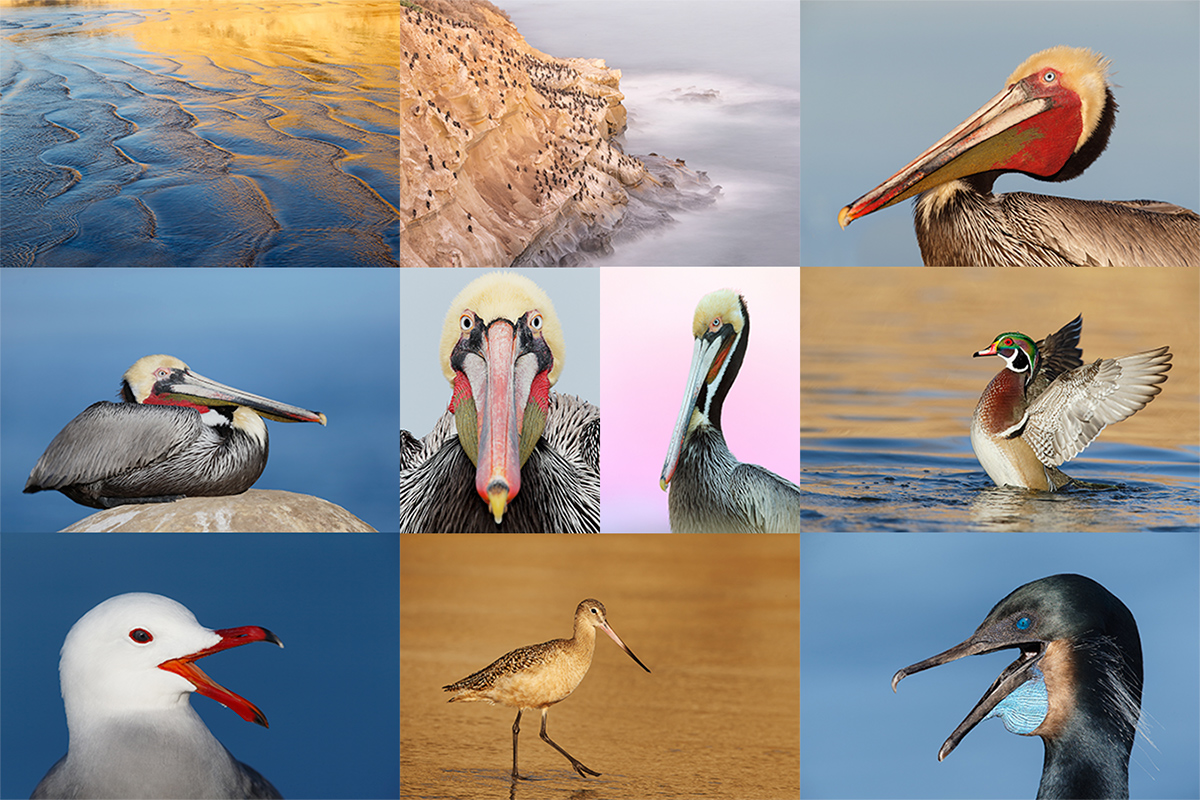
|
|
San Diego offers a wealth of very attractive natural history subjects. With annual visits spanning more than three decades I have lot of experience there….
|
With gorgeous subjects just sitting there waiting to have their pictures taken, photographing the pelicans on the cliffs is about as easy as nature photography gets. With the winds from the east almost every morning there, is usually some excellent flight photography. And the pelicans are almost always doing something interesting: preening, scratching, bill pouch cleaning, or squabbling. And then there are those crazy head throws that are thought to be a form of intra-flock communication. You can do most of your photography with an 80- or 100-400 lens …
Did I mention that there are wealth of great birds and natural history subjects in San Diego in winter?
|
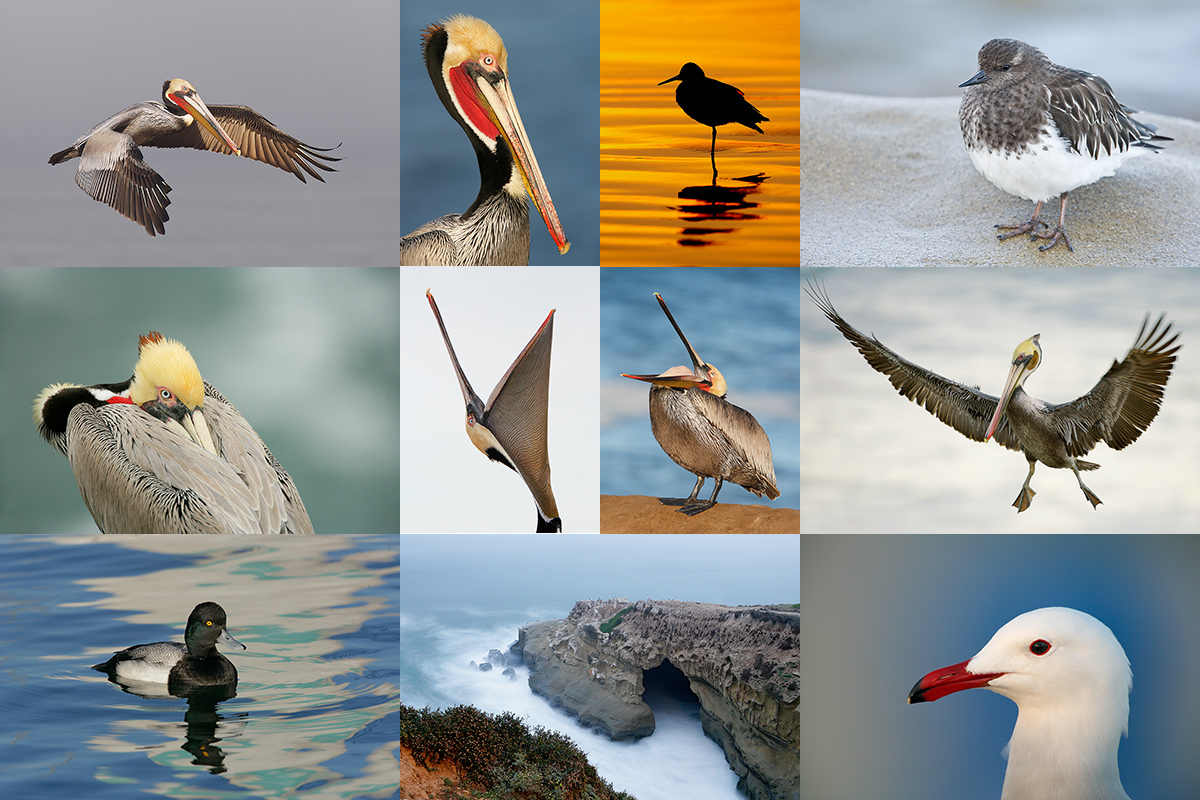
|
|
Though the pelicans will be the stars of the show on this IPT there will be many other handsome and captivating subjects in wonderful settings.
|
The San Diego Details
This IPT will include four 3 1/2 hour morning photo sessions, three 2 1/2 hour afternoon photo sessions, three lunches, and after-lunch image review and Photoshop sessions. To ensure early starts, breakfasts will be your responsibility. Dinners are on your own so that we can get some sleep.
A $599 non-refundable deposit is required to hold your slot for this IPT. You can send a check (made out to “Arthur Morris) to us at BIRDS AS ART, PO Box 7245, Indian Lake Estates, FL, 33855. Or call Jim or Jennifer at the office with a credit card at 863-692-0906. Your balance is payable only by check. Please print, complete, and sign the form that is linked to here and shoot it to us along with your deposit check. If you register by phone, please print, complete and sign the form as noted above and either mail it to us or e-mail the scan. If you have any questions, please feel free to contact me via e-mail.
Support the Blog
Please help support my (stupendous) efforts here on the blog by remembering to click on the logo link above each time that you shop Amazon. That would be greatly appreciated. with love, artie
If In Doubt …
If in doubt about using the BAA B&H affiliate link correctly, you can always start your search by clicking here. Please note that the tracking is invisible. Web orders only. Please, however, remember to shoot me your receipt via e-mail.




Please Remember to use my Affiliate Links and to Visit the New BAA Online Store 🙂
To show your appreciation for my continuing efforts here, we ask, as always, that you get in the habit of using my B&H affiliate links on the right side of the blog for all of your photo and electronics purchases. Please check the availability of all photographic accessories in the New BIRDS AS ART Online Store, especially the Mongoose M3.6 tripod head, Wimberley lens plates, Delkin flash cards and accessories, and LensCoat stuff.
As always, we sell only what I have used, have tested, and can depend on. We will not sell you junk. We know what you need to make creating great images easy and fun. And please remember that I am always glad to answer your gear questions via e-mail.
I would of course appreciate your using our B&H affiliate links for all of your major gear, video, and electronic purchases. For the photographic stuff mentioned in the paragraph above, and for everything else in the new store, we, meaning BAA, would of course greatly appreciate your business. Here is a huge thank you to the many who have been using our links on a regular basis and those who will be visiting the New BIRDS AS ART Online Store as well.
Facebook
Be sure to like and follow BAA on Facebook by clicking on the logo link upper right. Tanks a stack.
Typos
In all blog posts and Bulletins, feel free to e-mail or to leave a comment regarding any typos or errors. Just be right :).
December 25th, 2017 Stuff
It was cloudy/foggy in the early am so I kept working on the 5D IV Guide but at 8:15 I looked out the window and saw that it was sunny. I ran down to the lake and wound up taking a mile plus walk with my 400 DO II, the 1.4X III, and a 1DX II. That is not a typo: a 1DX II. I will share lots more on my new 1DX II with you here soon. For most of the rest of the day I was an NFL couch potato. I did however, take a slow half-mile plus (48 lengths) swim late in the afternoon. As the sunset was a big fizzle, I decided to stay on the couch and watch more football on TIVO.
Right now it is looking as if the 5D Mark IV User’s Guide will be in the BAA Online Store available for purchase sometime on Tuesday, December 26, 2017. I have lots more to do on the guide today as I received several new reviews from folks who got their free copies. Thanks to all the help that I have gotten it will be much improved from my original drafts.
Though sales have been going very well, there is still lots of great stuff available at just the right prices on the BAA Used Photo Gear page here.
Enjoy the holiday and don’t eat too, too much. 🙂
Important Note
More than a few folks over the past few days have sent requests for their free copy of the 5D Mark IV Guide along with their B&H receipts. When I searched my account by their order number, there was no record of the transaction. When I asked them about it, it turned out that either they made a phone order and never mentioned BIRDS AS ART (please remember, web orders only), or that they simply had not used a BAA affiliate link. Please remember to make all of your B&H purchases by starting with the generic Photo Gear and More B&H logo link on the top right of each blog page, or to use a product-specific or to e-mail for one and then click on that. Using these links won’t cost you one penny more and are the best way to thank me for the work that I put into the blog and the time I spend answering your queries via e-mail. Using my Amazon links helps too. All of your efforts are appreciated.
Click on the logo-link above for great holiday savings!
$300 off on the Canon 100-400 II!
The Streak
Today makes one hundred forty-nine days in a row with a new educational blog post! This blog post took about two hours to prepare. With all of my upcoming free time (or not …), the plan right now is to break the current record streak of 480 … Good health and good internet connections and my continuing insanity willing.
Click here for Amazing 5D Mark IV Bundles and Deals
Here is the best news: those who have used a BAA B&H affiliate link to purchase a 5D Mark IV (or other items totaling $3200 or more) are invited to send us a copy of their B&H receipt via e-mail and receive a free copy of the guide. If you would like to review the document before it is published, please send your receipt now. This offer is also valid for future purchases.
Booking.Com
Booking.Com came through for me twice again recently with both the DeSoto Fall IPT and next July’s UK Puffins, Gannets, and Bempton Pre-trip room reservations. And all the rates were great. If you’d like to give Booking.Com a shot, click here and you will earn a $25 reward. Thanks to the many who have already tried and used this great service.
Gear Questions and Advice
Too many folks attending BAA IPTs and dozens of folks whom I see in the field, and on BPN, are–out of ignorance–using the wrong gear especially when it comes to tripods and more especially, tripod heads… Please know that I am always glad to answer your gear questions via e-mail. Those questions might deal with systems, camera bodies, accessories, and/or lens choices and decisions.
Your Critique Needed
In the The Elusive Head Throw. And What Makes a Good Critique? blog post here, I wrote, with regards to the photo above, Please let me know what you think of today’s featured image, the good, the bad, and the ugly. You most honest response is appreciated.
Lot of folks offered critiques, mostly all positive. Warren H came closest to how I felt about the image when he posted, This isn’t my favorite image of yours.
My Honest Critique #1
The image does show the habitat (cliff by the ocean) well. It is relatively sharp. And it shows interesting behavior. I do not mind the abstract nature of the photograph. When I began working on the image I thought that I could make the image pop. I failed. The image is very flat with no contrast and boring color. The image quality is poor, feather and bill pouch detail are lacking, and with the relatively short focal length, the background detail — the ocean chop — has been brought up much too much. The framing is OK but in retrospect, taking some off the left side of the image while centering the bird in a tall skinny pano might have improved what I consider a pretty poor image overall. Some typical San Diego sun with a bright Pacific blue background would have really helped.
My Honest Critique #2
I ran the image above in yesterday’s “Dime a Dozen Part IV: It’s Just a Boat-tailed Grackle. And some really tough exposure questions …” blog post here and asked, What do you think of this image?
For me this is an outstanding image. It is sharp and the difficult exposure is perfect. The image pops and is dramatic. With the singing grackle set against the large disc of a somewhat muted sun, it is very different. If I had my druthers I might have liked it a bit better had I moved the tripod on inch to my right to get the bird’s tail away from the red rim of the sunset and had gotten an inch higher to move the bird slightly down in the frame. Why didn’t I do that? I was working in about a foot of soft organic muck and positioning the tripod was a big challenge. Right near sunset the sun is moving down like a bomb; I had to change the framing every 15 seconds or so. All in all I absolutely love this image.
Big Time Exposure Lesson Available …
I also wrote, Knowing that the ISO was 200 and that I was in Av mode, what do you think the exposure compensation was? What do you think the shutter speed was? And what do you think the aperture was?. Jake, the last to comment, was getting closer to the correct exposure and exposure compensation but his thinking proved to be somewhat convoluted when he wrote, “As there was no cloud obscuring the sun and you may have been trying to keep your shutter speed fast in case the bird took flight (hence the use of ISO 200), I reckon your shutter speed was around 1/1000 or 1/1250.” My question to him would be why would I lower the ISO if I wanted a faster shutter speed? ISO 200 is a clue that might lead folks closer to understanding the situation and getting closer still to the correct exposure and exposure compensation. But in truth, it is not the correct answer that is important here. What is important here is how I managed to come up with the winning exposure and EC.
All are welcome to take another crack at those two by revisiting yesterday’s post. I will share all here soon.
|
|
2017 in San Diego was a very good year ….
|
2018 San Diego 3 1/2-DAY BIRDS AS ART IPT #2: Sunday, JAN 28 thru and including the morning session on Wednesday, JAN 31, 2018 and a free morning session on Saturday, JAN 27: 3 1/2 days (+1/2 free day!): $1699. Limit: 8: Openings: 3.
Meet and Greet at 6:30pm on the evening before the IPT begins; Saturday, Jan 27, 2018.
San Diego IPT #2: Shorter and Less Expensive!
Join me in San Diego near the end of January to photograph the spectacular breeding plumage Brown Pelicans with their fire-engine red and olive green bill pouches; Brandt’s (usually nesting and displaying) and Double-crested Cormorants; breeding plumage Ring-necked Duck; other duck species possible including Lesser Scaup, Redhead, Wood Duck and Surf Scoter; a variety of gulls including Western, California, and the gorgeous Heerman’s, all in full breeding plumage; shorebirds including Marbled Godwit, Whimbrel, Willet, Sanderling and Black-bellied Plover; many others possible including Least, Western, and Spotted Sandpiper, Black and Ruddy Turnstone, Semipalmated Plover, and Surfbird; Harbor Seal (depending on the current regulations) and California Sea Lion; and Bird of Paradise flowers. And as you can see by studying the two IPT cards there are some nice bird-scape and landscape opportunities as well. Please note: formerly dependable, both Wood Duck and Marbled Godwit have been declining at their usual locations for the past two years …
|

|
|
San Diego offers a wealth of very attractive natural history subjects. With annual visits spanning more than three decades I have lot of experience there….
|
With gorgeous subjects just sitting there waiting to have their pictures taken, photographing the pelicans on the cliffs is about as easy as nature photography gets. With the winds from the east almost every morning there, is usually some excellent flight photography. And the pelicans are almost always doing something interesting: preening, scratching, bill pouch cleaning, or squabbling. And then there are those crazy head throws that are thought to be a form of intra-flock communication. You can do most of your photography with an 80- or 100-400 lens …
Did I mention that there are wealth of great birds and natural history subjects in San Diego in winter?
|

|
|
Though the pelicans will be the stars of the show on this IPT there will be many other handsome and captivating subjects in wonderful settings.
|
The San Diego Details
This IPT will include four 3 1/2 hour morning photo sessions, three 2 1/2 hour afternoon photo sessions, three lunches, and after-lunch image review and Photoshop sessions. To ensure early starts, breakfasts will be your responsibility. Dinners are on your own so that we can get some sleep.
A $599 non-refundable deposit is required to hold your slot for this IPT. You can send a check (made out to “Arthur Morris) to us at BIRDS AS ART, PO Box 7245, Indian Lake Estates, FL, 33855. Or call Jim or Jennifer at the office with a credit card at 863-692-0906. Your balance is payable only by check. Please print, complete, and sign the form that is linked to here and shoot it to us along with your deposit check. If you register by phone, please print, complete and sign the form as noted above and either mail it to us or e-mail the scan. If you have any questions, please feel free to contact me via e-mail.
Support the Blog
Please help support my (stupendous) efforts here on the blog by remembering to click on the logo link above each time that you shop Amazon. That would be greatly appreciated. with love, artie
If In Doubt …
If in doubt about using the BAA B&H affiliate link correctly, you can always start your search by clicking here. Please note that the tracking is invisible. Web orders only. Please, however, remember to shoot me your receipt via e-mail.




Please Remember to use my Affiliate Links and to Visit the New BAA Online Store 🙂
To show your appreciation for my continuing efforts here, we ask, as always, that you get in the habit of using my B&H affiliate links on the right side of the blog for all of your photo and electronics purchases. Please check the availability of all photographic accessories in the New BIRDS AS ART Online Store, especially the Mongoose M3.6 tripod head, Wimberley lens plates, Delkin flash cards and accessories, and LensCoat stuff.
As always, we sell only what I have used, have tested, and can depend on. We will not sell you junk. We know what you need to make creating great images easy and fun. And please remember that I am always glad to answer your gear questions via e-mail.
I would of course appreciate your using our B&H affiliate links for all of your major gear, video, and electronic purchases. For the photographic stuff mentioned in the paragraph above, and for everything else in the new store, we, meaning BAA, would of course greatly appreciate your business. Here is a huge thank you to the many who have been using our links on a regular basis and those who will be visiting the New BIRDS AS ART Online Store as well.
Facebook
Be sure to like and follow BAA on Facebook by clicking on the logo link upper right. Tanks a stack.
Typos
In all blog posts and Bulletins, feel free to e-mail or to leave a comment regarding any typos or errors. Just be right :).
December 24th, 2017 Stuff
I woke early on Saturday and met photographer/friend Clemens van der Werf at lake Blue Cypress to try out his new boat. It was great for two photographers. Though the sunrise colors were not great and though we were a bit late getting started, it turned out to be a perfect day for lake-scape photography: lots of big dramatic clouds and with zero wind all morning long, the mirror-like reflections of the clouds made perfect settings for the Cypress trees. I used every lens form the 8-15mm circle lens through my 100-400 for the tree- and sky-scapes. There were a few Osprey around and we had some decent opportunities to photograph them.
We called it quits at about 10:30am and before noon we were sitting around the lunch table on my pool deck enjoying barbecued halibut and brussels sprouts with fresh, ice cold lemonade. Then Clemens went to work with his chain saw and I with the loppers continuing the Hurricane Irma clean-up of my yard. Clemens headed back to Lake Blue Cypress for a sunset session. After my lazy 3/4 mile swim I headed down to the lake for yet another very lovely red sunset.
Right now it is looking as if the 5D Mark IV User’s Guide will be in the BAA Online Store available for purchase on Tuesday, December 26, 2017. I will be doing all the mopping up today. Mitch Haimov and several others have been sending reviews of the guide but Mitch’s efforts have been stellar! Thanks to all it will be much improved from my original drafts.
I was glad to learn that Marvin Falk is coming down from Alaska to join San Diego IPT #2; that leaves only three slots with several others interested.
I was glad to learn that the sale of Mike Rust’s Canon 600mm f/4L IS II ISM lens in near-mint condition for $9396.00 and the sale of his Canon EF 24-105mm f/4L IS II USM lens in like-new condition for $699.00 were both finalized. I learned also that the sale of Joel Williams’ Fujifilm X-T2 body with two grips, his Fujifilm XF 16mm f/1.4 R WR lens with the LH-XF 16 lens hood, his Fujifilm XF 23 f/2 R WR lens, and his Fujifilm XF 35 f/2 R WR lens with the LH-XF 35-2 lens hood, all to a single buyer, is nearly complete. Joel generously put together a discounted package price. There is still lot of great stuff available at just the right prices on the BAA Used Photo Gear page here.
Important Note
More than a few folks over the past few days have sent requests for their free copy of the 5D Mark IV Guide along with their B&H receipts. When I searched my account by their order number, there was no record of the transaction. When I asked them about it, it turned out that either they made a phone order and never mentioned BIRDS AS ART (please remember, web orders only), or that they simply had not used a BAA affiliate link. Please remember to make all of your B&H purchases by starting with the generic Photo Gear and More B&H logo link on the top right of each blog page, or to use a product-specific or to e-mail for one and then click on that. Using these links won’t cost you one penny more and are the best way to thank me for the work that I put into the blog and the time I spend answering your queries via e-mail. Using my Amazon links helps too. All of your efforts are appreciated.
Click on the logo-link above for great holiday savings!
$300 off on the Canon 100-400 II!
Facebook
If you have sent me a FB friends request that has gone unrequited, it is because I am up to the 5,000 limit on my personal FB page. You are invited to click here and then Like and Follow the identical content. 🙂
The Streak
Today makes one hundred forty-eight days in a row with a new educational blog post! This blog post took about two hours to prepare. With all of my upcoming free time (or not …), the plan right now is to break the current record streak of 480 … Good health and good internet connections and my continuing insanity willing.
Click here for Amazing 5D Mark IV Bundles and Deals
Here is the best news: those who have used a BAA B&H affiliate link to purchase a 5D Mark IV (or other items totaling $3200 or more) are invited to send us a copy of their B&H receipt via e-mail and receive a free copy of the guide. If you would like to review the document before it is published, please send your receipt now. This offer is also valid for future purchases.
Booking.Com
Booking.Com came through for me twice again recently with both the DeSoto Fall IPT and next July’s UK Puffins, Gannets, and Bempton Pre-trip room reservations. And all the rates were great. If you’d like to give Booking.Com a shot, click here and you will earn a $25 reward. Thanks to the many who have already tried and used this great service.
Gear Questions and Advice
Too many folks attending BAA IPTs and dozens of folks whom I see in the field, and on BPN, are–out of ignorance–using the wrong gear especially when it comes to tripods and more especially, tripod heads… Please know that I am always glad to answer your gear questions via e-mail. Those questions might deal with systems, camera bodies, accessories, and/or lens choices and decisions.
Why Manual Focus?
Most photographers know that acquiring focus can be difficult in extreme low contrast situations. Though few folks try to create photographs similar to today’s featured image, those who do will learn quickly that it can be equally difficult or even impossible to acquire focus in extreme high contrast situation. When I need to focus manually I far prefer to switch from shutter button AF to Rear button AF rather than turn the AF switch to M (for Manual focusing). Why? It is easier to forget the latter than it is to forget the former …
NEOS Adventurer Overshoes
Many of these sunset images of birds on the various perches down by the lake would bot be possible without my NEOS Adventurer Overshoes. When I see a bird on the perch at sunset I know that I will need to wade into the mucky shallow water. I reach into the rear driver’s-side seat well and grab my NEOS. Whether I am wearing my sneakers or my hiking boots, it takes about 30 seconds to get them on. Then I slosh around in the mud and muck, usually managing to stay shallower then knee-high 🙂 The Navigators come right up to below the bottom of my knee. Once I am done, removing the lightweight, completely waterproof overshoes takes less than ten seconds. And my regular footwear and the bottoms of my jeans are perfectly clean and dry.
Folks in cold-weather climes need to look at the NEOS Navigator Overshoes. They are perfect for getting through the wet snow and the Vibram Ninja Outsoles will prevent slipping on ice. They are conservatively estimated to good for -20 degrees Fahrenheit. Ace photographer-friend Brian Zwiebel swears that they are the warmest winter footwear on the planet despite their light weight. I own and use a pair of both.
Image Questions
How might this image have been improved if I had moved my tripod one inch to the right and had worked one inch taller?
What do you think of this image?
Exposure Questions
Knowing that the ISO was 200 and that I was in Av mode, what do you think the exposure compensation was? What do you think the shutter speed was? And what do you think the aperture was?
|
|
2017 in San Diego was a very good year ….
|
2018 San Diego 3 1/2-DAY BIRDS AS ART IPT #2: Sunday, JAN 28 thru and including the morning session on Wednesday, JAN 31, 2018 and a free morning session on Saturday, JAN 27: 3 1/2 days (+1/2 free day!): $1699. Limit: 8: Openings: 3.
Meet and Greet at 6:30pm on the evening before the IPT begins; Saturday, Jan 27, 2018.
San Diego IPT #2: Shorter and Less Expensive!
Join me in San Diego near the end of January to photograph the spectacular breeding plumage Brown Pelicans with their fire-engine red and olive green bill pouches; Brandt’s (usually nesting and displaying) and Double-crested Cormorants; breeding plumage Ring-necked Duck; other duck species possible including Lesser Scaup, Redhead, Wood Duck and Surf Scoter; a variety of gulls including Western, California, and the gorgeous Heerman’s, all in full breeding plumage; shorebirds including Marbled Godwit, Whimbrel, Willet, Sanderling and Black-bellied Plover; many others possible including Least, Western, and Spotted Sandpiper, Black and Ruddy Turnstone, Semipalmated Plover, and Surfbird; Harbor Seal (depending on the current regulations) and California Sea Lion; and Bird of Paradise flowers. And as you can see by studying the two IPT cards there are some nice bird-scape and landscape opportunities as well. Please note: formerly dependable, both Wood Duck and Marbled Godwit have been declining at their usual locations for the past two years …
|

|
|
San Diego offers a wealth of very attractive natural history subjects. With annual visits spanning more than three decades I have lot of experience there….
|
With gorgeous subjects just sitting there waiting to have their pictures taken, photographing the pelicans on the cliffs is about as easy as nature photography gets. With the winds from the east almost every morning there, is usually some excellent flight photography. And the pelicans are almost always doing something interesting: preening, scratching, bill pouch cleaning, or squabbling. And then there are those crazy head throws that are thought to be a form of intra-flock communication. You can do most of your photography with an 80- or 100-400 lens …
Did I mention that there are wealth of great birds and natural history subjects in San Diego in winter?
|

|
|
Though the pelicans will be the stars of the show on this IPT there will be many other handsome and captivating subjects in wonderful settings.
|
The San Diego Details
This IPT will include four 3 1/2 hour morning photo sessions, three 2 1/2 hour afternoon photo sessions, three lunches, and after-lunch image review and Photoshop sessions. To ensure early starts, breakfasts will be your responsibility. Dinners are on your own so that we can get some sleep.
A $599 non-refundable deposit is required to hold your slot for this IPT. You can send a check (made out to “Arthur Morris) to us at BIRDS AS ART, PO Box 7245, Indian Lake Estates, FL, 33855. Or call Jim or Jennifer at the office with a credit card at 863-692-0906. Your balance is payable only by check. Please print, complete, and sign the form that is linked to here and shoot it to us along with your deposit check. If you register by phone, please print, complete and sign the form as noted above and either mail it to us or e-mail the scan. If you have any questions, please feel free to contact me via e-mail.
Support the Blog
Please help support my (stupendous) efforts here on the blog by remembering to click on the logo link above each time that you shop Amazon. That would be greatly appreciated. with love, artie
If In Doubt …
If in doubt about using the BAA B&H affiliate link correctly, you can always start your search by clicking here. Please note that the tracking is invisible. Web orders only. Please, however, remember to shoot me your receipt via e-mail.




Please Remember to use my Affiliate Links and to Visit the New BAA Online Store 🙂
To show your appreciation for my continuing efforts here, we ask, as always, that you get in the habit of using my B&H affiliate links on the right side of the blog for all of your photo and electronics purchases. Please check the availability of all photographic accessories in the New BIRDS AS ART Online Store, especially the Mongoose M3.6 tripod head, Wimberley lens plates, Delkin flash cards and accessories, and LensCoat stuff.
As always, we sell only what I have used, have tested, and can depend on. We will not sell you junk. We know what you need to make creating great images easy and fun. And please remember that I am always glad to answer your gear questions via e-mail.
I would of course appreciate your using our B&H affiliate links for all of your major gear, video, and electronic purchases. For the photographic stuff mentioned in the paragraph above, and for everything else in the new store, we, meaning BAA, would of course greatly appreciate your business. Here is a huge thank you to the many who have been using our links on a regular basis and those who will be visiting the New BIRDS AS ART Online Store as well.
Facebook
Be sure to like and follow BAA on Facebook by clicking on the logo link upper right. Tanks a stack.
Typos
In all blog posts and Bulletins, feel free to e-mail or to leave a comment regarding any typos or errors. Just be right :).
December 23rd, 2017 Stuff
On Friday morning I went down to the lake in thick fog and wound up getting stuck in the mud … That was at about 9am. I was towed out by the AAA by 11:30. I actually loved every minute of it. Oh, I forget, because I was more than 50 feet off the road I got charged $150 for my free tow. And I loved that too. Honest. I have been feeling so good lately that I swam a slow mile — 88 lengths, in my quite comfortable pool in the late afternoon.
Right after my swim I headed down to the lake to get right back on the horse :). I did stay well back from the lakeshore. How was my luck? Totally amazing. I can hardly wait to share some totally new dime a dozen images. I wake early tomorrow to meet Clemens van der Werf to try out his new boat on Lake Blue Cypress.
Right now it is looking as if the 5D Mark IV User’s Guide will be in the BAA Online Store available for purchase on Tuesday, December 26, 2017.
Important Note
More than a few folks over the past few days have sent requests for their free copy of the 5D Mark IV Guide along with their B&H receipts. When I searched my account by their order number, there was no record of the transaction. When I asked them about it, it turned out that either they made a phone order and never mentioned BIRDS AS ART (please remember, web orders only), or that they simply had not used a BAA affiliate link. Please remember to make all of your B&H purchases by starting with the generic Photo Gear and More B&H logo link on the top right of each blog page, or to use a product-specific or to e-mail for one and then click on that. Using these links won’t cost you one penny more and are the best way to thank me for the work that I put into the blog and the time I spend answering your queries via e-mail. Using my Amazon links helps too. All of your efforts are appreciated.
Click on the logo-link above for great holiday savings!
$300 off on the Canon 100-400 II!
Facebook
If you have sent me a FB friends request that has gone unrequited, it is because I am up to the 5,000 limit on my personal FB page. You are invited to click here and then Like and Follow the identical content. 🙂
The Streak
Today makes one hundred forty-seven days in a row with a new educational blog post! With all the new used gear — how’s that for an oxymoron? — this blog post took about five hours to prepare. With all of my upcoming free time (or not …), the plan right now is to break the current record streak of 480 … Good health and good internet connections willing.
Click here for Amazing 5D Mark IV Bundles and Deals
Here is the best news: those who have used a BAA B&H affiliate link to purchase a 5D Mark IV (or other items totaling $3200 or more) are invited to send us a copy of their B&H receipt via e-mail and receive a free copy of the guide. If you would like to review the document before it is published, please send your receipt now. This offer is also valid for future purchases.
Booking.Com
Booking.Com came through for me twice again recently with both the DeSoto Fall IPT and next July’s UK Puffins, Gannets, and Bempton Pre-trip room reservations. And all the rates were great. If you’d like to give Booking.Com a shot, click here and you will earn a $25 reward. Thanks to the many who have already tried and used this great service.
Gear Questions and Advice
Too many folks attending BAA IPTs and dozens of folks whom I see in the field, and on BPN, are–out of ignorance–using the wrong gear especially when it comes to tripods and more especially, tripod heads… Please know that I am always glad to answer your gear questions via e-mail. Those questions might deal with systems, camera bodies, accessories, and/or lens choices and decisions.
|
|
This is the DPP 4 Screen Capture for today’s featured image
|
The DPP 4 Screen Capture for today’s featured image
There are two things to note:
1-Even though I was +2 2/3 stops as framed and even though I added 1/3 stop of light during the RAW conversion in DPP 4 the image was still a bit underexposed: note that there is room to the right after the histogram data ends.
2-I framed the image as a vertical with the bird in the center in case the bird took flight; I did not want to cut the raised wings if the Osprey took flight.
Two Questions
#1: Would you have even tried to make an image in the dense fog?
#2: If your RAW file looked like the one in the screen capture above would you waste any time trying to optimize it? Why or why not?
The Image Optimization
Once I got the TIF into Photoshop I tried every trick in the book. First I did the obvious Levels adjustment. That helped a bit. Next I tried Dehaze with the ACR filter (Filter > Camera RAW Filter > Dehaze. That helped a bit. Next I tried a Curves color balance adjustment. That did not help. I applied a 30% layer of Auto Contrast. That helped a bit. The big problem was that the color noise was horrific. I ran fast and dirty NeatImage noise reduction on the whole image and that got rid of all the remaining luminance noise and 80% of the color noise. But the color noise that remained was U-G–Y ugly! I went to Selective Color and moved some of the sliders with the BLACKs. That did not help. I went to Hue Saturation and desaturated the GREENs and the REDs. When that did not help I simply saved the image.
But then I had a thought. Maybe the RED color noise was not RED. And maybe the GREEN color noise was not Green. I opened the image in Photoshop again and went back to Hue/Saturation. I tried MAGENTA and moved the slider to the right to 100%. All of the REC color noise lit up so I moved the slider to the left until the RED color noise disappeared. Then I did the same thing with CYAN. Voila! The image was so improved that I applied a layer of my NIK 35/35 recipe. Looking good.I was so inspired the improvement that I did some really nice eye doctor work on both the pupil and the iris.
While I will not be making any big prints of this image it is certainly decent enough for web presentation and slide programs. And, I learned a ton to boot. And on Friday morning I had another foggy Osprey and did a few things differently. Before I got stuck in the mud :). Story and images will follow at some point.
|
|
|
The BIRDS AS ART Current Workflow e-Guide (Digital Basics II) will teach you an efficient Mac or PC/Photo Mechanic/Photoshop workflow that will make it easy for you to make your images better in Photoshop (rather than worse). That true whether you convert your images in DPP 4 or ACR. See the blog post here to learn lots more and to read a free excerpt.
You can order your copy from the BAA Online Store here, by sending a Paypal for $40 here, or by calling Jim or Jennifer weekdays at 863-692-0906 with your credit card in hand.
|
The BIRDS AS ART Current Workflow e-Guide (Digital Basics II)
Your guessed it, everything mentioned above (and tons more) are covered in detail in the BIRDS AS ART Current Workflow e-Guide (Digital Basics II), an instructional PDF that is sent via e-mail. Learn more and check out the free excerpt in the blog post here. The new e-Guide reflects my Macbook Pro/Photo Mechanic/DPP 4/Photoshop workflow. Do note that you will find the RGB Curves Adjustment Color Balancing tutorial only in the new e-guide. Note: folks working on a PC and/or those who do not want to miss anything Photoshop may wish to purchase the original Digital Basics along with DB II while saving $15 by clicking here to buy the DB Bundle.
The two most recent and many of the older MP4 Photoshop Tutorial videos releases go hand and hand with the information in DB II):
- The Wingtip Repairs MP4 Video here.
- The MP4 Crow Cleanup Video here.
Folks who learn well by following along rather than by reading can check out the complete collection of MP 4 Photoshop Tutorial Videos by clicking here.
You can learn how and why I and other discerning Canon shooters convert nearly all of their Canon digital RAW files in DPP 4 using Canon Digital Photo Professional in the DPP 4 RAW conversion Guide here. And you can learn advanced Quick Masking and advanced Layer Masking techniques in APTATS I & II. You can save $15 by purchasing the pair. Folks can learn sophisticated sharpening and (NeatImage) Noise Reduction techniques in the The Professional Post Processing Guide by Arash Hazeghi and yours truly.
Support the Blog
Please help support my (stupendous) efforts here on the blog by remembering to click on the logo link above each time that you shop Amazon. That would be greatly appreciated. with love, artie
If In Doubt …
If in doubt about using the BAA B&H affiliate link correctly, you can always start your search by clicking here. Please note that the tracking is invisible. Web orders only. Please, however, remember to shoot me your receipt via e-mail.




Please Remember to use my Affiliate Links and to Visit the New BAA Online Store 🙂
To show your appreciation for my continuing efforts here, we ask, as always, that you get in the habit of using my B&H affiliate links on the right side of the blog for all of your photo and electronics purchases. Please check the availability of all photographic accessories in the New BIRDS AS ART Online Store, especially the Mongoose M3.6 tripod head, Wimberley lens plates, Delkin flash cards and accessories, and LensCoat stuff.
As always, we sell only what I have used, have tested, and can depend on. We will not sell you junk. We know what you need to make creating great images easy and fun. And please remember that I am always glad to answer your gear questions via e-mail.
I would of course appreciate your using our B&H affiliate links for all of your major gear, video, and electronic purchases. For the photographic stuff mentioned in the paragraph above, and for everything else in the new store, we, meaning BAA, would of course greatly appreciate your business. Here is a huge thank you to the many who have been using our links on a regular basis and those who will be visiting the New BIRDS AS ART Online Store as well.
Facebook
Be sure to like and follow BAA on Facebook by clicking on the logo link upper right. Tanks a stack.
Typos
In all blog posts and Bulletins, feel free to e-mail or to leave a comment regarding any typos or errors. Just be right :).
December 22nd, 2017 Stuff
Thursday morning was so foggy that I never headed down to the lake. And the sunset was pretty much a fizzle. And so it goes. I swam my slow 3/4 mile in a positively toasty pool in the late afternoon. Another cold front is supposed to be on its way. 🙂
Right now it is looking as if the 5D Mark IV User’s Guide will be in the BAA Online Store available for purchase on Tuesday, December 26, 2017. Merry Christmas.
I was glad to learn on Thursday that the sales of Mike Rust’s great Canon stuff in the blog post here are either completed or pending. All that is left are the two 2X III TCs. Most of the items were spoken for within a day of the listing. I learned also that Pradip Thachile’s old 400 DO sold on December 21st. See more on the Used Photo Gear page below.
Important Note
More than a few folks yesterday sent requests for their free copy of the 5D Mark IV Guide along with a B&H receipt. When I searched my account by their order number, there was no record of the transaction. When I asked them about it, it turned out that either they made a phone order and never mentioned BIRDS AS ART (please remember, web orders only), or that they simply had not used a BAA affiliate link. Please remember to make all of your B&H purchases by starting with the generic Photo Gear and More B&H logo link on the top right of each blog page, or to use a product-specific or to e-mail for one and then click on that. Using these links won’t cost you one penny more and are the best way to thank me for the work that I put into the blog and the time I spend answering your queries via e-mail. Using my Amazon links helps too. All of your efforts are appreciated.
Click on the logo-link above for great holiday savings!
$300 off on the Canon 100-400 II!
Facebook
If you have sent me a FB friends request that has gone unrequited, it is because I am up to the 5,000 limit on my personal FB page. You are invited to click here and then Like and Follow the identical content. 🙂
The Streak
Today makes one hundred forty-seven days in a row with a new educational blog post! With all the new used gear — how’s that for an oxymoron? — this blog post took about five hours to prepare. With all of my upcoming free time (or not …), the plan right now is to break the current record streak of 480 … Good health and good internet connections willing.
Click here for Amazing 5D Mark IV Bundles and Deals
Here is the best news: those who have used a BAA B&H affiliate link to purchase a 5D Mark IV (or other items totaling $3200 or more) are invited to send us a copy of their B&H receipt via e-mail and receive a free copy of the guide. If you would like to review the document before it is published, please send your receipt now. This offer is also valid for future purchases.
Booking.Com
Booking.Com came through for me twice again recently with both the DeSoto Fall IPT and next July’s UK Puffins, Gannets, and Bempton Pre-trip room reservations. And all the rates were great. If you’d like to give Booking.Com a shot, click here and you will earn a $25 reward. Thanks to the many who have already tried and used this great service.
Gear Questions and Advice
Too many folks attending BAA IPTs and dozens of folks whom I see in the field, and on BPN, are–out of ignorance–using the wrong gear especially when it comes to tripods and more especially, tripod heads… Please know that I am always glad to answer your gear questions via e-mail. Those questions might deal with systems, camera bodies, accessories, and/or lens choices and decisions.
Used Gear on Fire!
Sales of new stuff on the Used Gear page recently have been brisk. The sales of Mike Rust’s great Canon stuff in the blog post here are either completed or pending. All that is left are the two 2X III TCs. Most of the items were spoken for within a day of the listing.
From the past two months alone:
- Mike Rust sold his Canon 600mm f/4L IS II ISM lens in near-mint condition for $9396.00 and his Canon EF 24-105mm f/4L IS II USM lens in like-new condition for $699.00. Both on the first day of listing.
- Pradip Thachile sold his Canon EF 400mm f/4 IS DO lens (the original version) in excellent condition for the BAA record low price of $2097.00 in late December.
- Joel Williams sold his Fujifilm XF 100-400mm f/4.5-5.6 R LM OIS WR lens in like-new condition for $1199 right after it was listed in mid-December.
- Mike Newman sold his Canon EF 100mm f2.8/L IS USM macro lens in like-new condition for only $599 in mid-December, right after it was listed.
- Joel Williams sold a Fujifilm XF 1.4x TC WR teleconverter in like-new condition for $299 in mid-December, 2017.
- IPT veteran Carolyn Peterson sold her Canon EOS 5D Mark III camera body in excellent condition for $1399 in mid-December.
- Mike Newman sold a Canon EF 600 F4/L USM IS II USA lens in like-new condition for the record-low BAA price of 9,398.00 within two days of listing it in early December.
- Steve Cashell sold his Canon EF 800mm f/5.6L IS USM lens in near-mint condition for a very low $7898 in mid-November.
- In late November Mansoor Assadi sold his Canon EOS-1DX Mark II professional digital camera body in like-new condition for a BAA record-low $3998 and his Canon EOS-1D Mark IV professional digital camera body in excellent condition for a very low and fair $999.
- Mansoor Assadi sold his Canon EOS 5D Mark III digital camera body in excellent condition for a very low $1299 in early November.
- Robert Blanke sold his Canon EOS-1DX Mark II professional digital camera body in like-new condition for the BAA record low/shock the world price of $3999 an hour after it was listed.
- IPT veteran Duncan Douglas sold his Canon EF 500mm f/4L IS USM Super Telephoto Lens (the “old five”) in early November for #3699.
- Chesley Swann sold a Canon EF 100-400 f/4.5-5.6L IS Zoom Lens (the original 1-4) in excellent condition for the very low price of $529 in mid-November.
- Mike Lawie sold his Canon EOS 7D Mark II body in near-mint condition for the BAA record-low price of $923 and his Canon EF 24-105mm f/4L IS USM zoom lens in excellent condition also for a BAA record low price: $448. Both in mid-November.
- Gary Wade sold his Canon EF 400mm f/2.8L IS II USM Lens in near-mint condition for the record-low BAA price of $7449 in mid-November.
- Multiple IPT veteran Shelly Goldstein sold his Canon EF 500mm f/4L IS USM Super Telephoto Lens (the “old five”) in excellent condition for the $3899 a week after it was listed.
- Peter Noyes sold his Nikon D-810 Digital SLR Camera Body in excellent condition for $1499 two hours after it was listed.
- Multiple IPT veteran Shelly Goldstein sold his Canon EF 600mm f/4L IS II USM Super Telephoto lens in like-new condition for $9,399 in early November before it was even listed …
Brand New Used Gear Listings!
Sony Alpha a7R Mirrorless Digital Camera
Top pro Jim Zuckerman is offering a Sony Alpha a7R Mirrorless Digital camera in excellent condition for $1399. The sale includes two batteries, the original box, the charger, a ProTama Lens Mount Adapter (for Canon EF/EF-S Lenses to Sony E-mount camera), and insured ground shipping via major courier to US addresses only. Your item will not ship until your check clears unless other arrangements are made.
Please contact Jim via e-mail or by phone at 1-615-414-7644 (Central time).
The Alpha a7R Mirrorless Digital Camera from Sony incorporates a full-frame Exmor CMOS sensor into an E-mount body thus providing the light gathering capability and detail-rich imaging of a full-frame sensor with a compact, lightweight and versatile mirrorless interchangeable lens camera system. Differing from the full-frame Sony Alpha a7, the Alpha a7R omits the low-pass filter from its 36.4MP sensor, thus optimizing its high resolution, detail-rich imaging capability. In addition, the sensor features a new gapless lens design to increase corner-to-corner light collecting efficiency.The standard ISO sensitivity range of 100-25600 provides rich saturation in bright light and clear, low-noise images in low-light situations. This camera sells new for $1898. B&H
PocketWizard MultiMax Transceiver
Top pro Jim Zuckerman is also offering the original PocketWizard MultiMax Transceiver in near-mint condition for $60. The sale includes insured ground shipping via major courier to US addresses only. Your item will not ship until your check clears unless other arrangements are made.
Please contact Jim via e-mail or by phone at 1-615-414-7644 (Central time).
Sometimes simple triggering just isn’t going to cut it, in those cases you can find salvation in the MultiMAX Transceiver from the always reliable PocketWizard. Operating on the FCC-approved 340-354 MHz frequency range, the MultiMAX II can easily be added to existing kits as it works with many existing PocketWizard radios. Also, this unit is exceptionally powerful with a range of 1600′ that can be boosted to 3200′ in a Long Range Mode. A key to the MultiMAX II’s success is its reliability, which is bolstered by the ability to select between 32 standard channels with four zones in Selective Quad-Triggering or 20 ControlTL channels with three zones. B&H
Canon EOS 5D Mark III
Hisham A. is offering a Canon EOS 5D Mark III in very good condition (in perfect working order) for the BAA record low price of $999. The sale includes an extra Watson battery, the front lens cap, and all the stuff that came in the box as well as insured ground shipping to US addresses via major courier. Your item will not ship until your check clears unless other arrangements are made. Photos are available upon request.
Please contact Hisham via e-mail or by phone at 720 771 2693 (Eastern time).
I used my 5D Mark III to produce high quality image files for all of my landscape, flower, and Urbex photography. And I used it often for bird photography with my f/4 super-telephoto lenses with both the 1.4X and the 2X TCs. As long as you have firmware version 1.2.1 or higher you will have AF at f/8 with the center AF point (along with the four assist points). artie
Canon EF 70-200mm f/2.8L IS USM Lens
Hisham A. is also offering a Canon 70-200mm f/2.8L IS USM lens very good condition (with perfect glass and in perfect working order) for the BAA record low price of $999. The sale includes the rear lens cap, the lens hood, the tripod ring (collar), the original box and insured ground shipping to US addresses via major courier. Your item will not ship until your check clears unless other arrangements are made. Photos are available upon request.
Please contact Hisham via e-mail or by phone at 720 771 2693 (Eastern time).
The 70-200mm f/2.8L IS II lens is amazingly versatile. I still own one and have made zillions of great images with it. It works well with both the 1.4X III and the 2X III TCs, even with the 7D II! It is easily hand holdable. It is great for tame birds, landscapes, urbex, indoor stuff likes concerts and recitals, and just about anything you want to photograph. A new 70-200 II currently sells for $1,949 so you can save a cool $350 by buying Les’s mint copy asap. artie
Canon Extender EF 1.4X III (teleconverter)
Hisham A. is offering a Canon Extender EF 1.4X III (teleconverter)in like-new good condition for the $329. The sale includes the TC pouch, the front and rear lens caps, the original box, and insured ground shipping to US addresses via major courier. Your item will not ship until your check clears unless other arrangements are made. Photos are available upon request.
Please contact Hisham via e-mail or by phone at 720 771 2693 (Eastern time).
As regular readers know, I use my teleconverters more than any other photographer. They are so important to what I do that I on big trips I travel with two 2X III TCs and three 1.X III TCs. artie
Canon EF 24-105mm f/4L IS USM Lens
Hisham A. is also offering the original Canon 24-105mm f/4L IS USM lens like-new condition for a very low $449. The sale includes the rear lens cap, the lens hood, the original box and insured ground shipping to US addresses via major courier. Your item will not ship until your check clears unless other arrangements are made. Photos are available upon request.
Please contact Hisham via e-mail or by phone at 720 771 2693 (Eastern time).
I rarely make a trip or head out to the beach without my 24-105 with me. Whenever I leave this versatile B-roll lens behind, I wind up regretting it. I use it for bird-scapes, photographer-scapes, landscapes, mini macro scenes like bird feathers, dead birds, and nests with eggs — the latter only when and if the nest can be photographed without jeopardizing it, and just about anything else that catches my eye. While I am nowhere near as good as Denise Ippolito with this lens, I have made lots of good and saleable images with mine. artie
Canon EF 400mm f/5.6 L USM Lens
Hisham A. is also offering a Canon EF 400mm f/5.6 L USM lens in very good condition (with perfect glass and in perfect working order) for the BAA record low by far price of $549. The sale includes the rear lens cap, the original box and insured ground shipping to US addresses via major courier. Your item will not ship until your check clears unless other arrangements are made. Photos are available upon request.
Please contact Hisham via e-mail or by phone at 720 771 2693 (Eastern time).
I put my beloved Toy Lens” on the map before the turn of the century when I began using it with film and the Canon A2 camera body to photograph birds in flight. Today it remains a great flight lens and in addition, makes a great bird photography starter lens. It couples quite well with the 7D Mark II and will autofocus with a 1.4X TC with that camera and most of the newer Canon bodies as well. artie
|
|
|
This image was created at Indian Lake Estates on the evening of December 19, 2017 with the hand held Canon EF 100-400mm f/4.5-5.6L IS II USM lens (at 214mm) and my favorite B-roll photography camera body, the Canon EOS 5D Mark IV. ISO 400. Evaluative metering at zero: 1/400 sec. at f/6.3 in Manual mode. AWB. 5:34pm right at sunset.
LensAlign/FocusTune micro-adjustment: extrapolated to -3.
Upper Large Zone AI/Servo/Shutter Button AF was active at the moment of exposure.
Cabbage Palm sunset silhouette with Black Vulture fly-by
|
Dime a Dozen/Part III: I Saw It Coming So I Pushed the Shutter Button. Well, Almost …
There was not a lot going on late in the day on Tuesday and I was about to head home when I remembered a single isolated cabbage palm at the end of the peninsula to the left of the pier so I drove south to check it out. It looked nice so I made a few images at zero EC. The sun was toasted (well over-exposed) so I waited an extra minute knowing that zero EC would be perfect when the sun was just a sliver on the horizon. As I raised the lens to re-frame the shot, I noticed a Black Vulture flying to roost just over the water, coming from the north. As soon as it entered the frame I pushed and held the shutter button down for two quick frames. As expected, I was too late for the first frame; the bird was hidden behind the tree. In the second frame the bird was to our left of the tree heading out of the frame …
After converting the image straight up in DPP 4 I brought it into Photoshop and leveled it. I filled in the four skinny triangles using John Heado Content Aware Fill. The I cropped it back to 2X3. Since the bird was heading out of the frame rather than into it and because the sun and the bird were to our left of the tree, I decided to move the vulture to the right side of the tree to improve the flow of the image and the compositional balance. I painted a Quick Mask of the bird and a bit of sky, put that on its own layer, moved the bird to the other side of the frame, and refined the layer with a Curves adjustment and a Regular Layer mask. Now I had two birds. The one to the left of the tree was removed quickly and easily with Content Aware Fill (after selecting it with the Patch Tool).
|
|
|
The BIRDS AS ART Current Workflow e-Guide (Digital Basics II) will teach you an efficient Mac or PC/Photo Mechanic/Photoshop workflow that will make it easy for you to make your images better in Photoshop (rather than worse). That true whether you convert your images in DPP 4 or ACR. See the blog post here to learn lots more and to read a free excerpt.
You can order your copy from the BAA Online Store here, by sending a Paypal for $40 here, or by calling Jim or Jennifer weekdays at 863-692-0906 with your credit card in hand.
|
The BIRDS AS ART Current Workflow e-Guide (Digital Basics II)
Your guessed it, everything mentioned above (and tons more) are covered in detail in the BIRDS AS ART Current Workflow e-Guide (Digital Basics II), an instructional PDF that is sent via e-mail. Learn more and check out the free excerpt in the blog post here. The new e-Guide reflects my Macbook Pro/Photo Mechanic/DPP 4/Photoshop workflow. Do note that you will find the RGB Curves Adjustment Color Balancing tutorial only in the new e-guide. Note: folks working on a PC and/or those who do not want to miss anything Photoshop may wish to purchase the original Digital Basics along with DB II while saving $15 by clicking here to buy the DB Bundle.
The two most recent and many of the older MP4 Photoshop Tutorial videos releases go hand and hand with the information in DB II):
- The Wingtip Repairs MP4 Video here.
- The MP4 Crow Cleanup Video here.
Folks who learn well by following along rather than by reading can check out the complete collection of MP 4 Photoshop Tutorial Videos by clicking here.
You can learn how and why I and other discerning Canon shooters convert nearly all of their Canon digital RAW files in DPP 4 using Canon Digital Photo Professional in the DPP 4 RAW conversion Guide here. And you can learn advanced Quick Masking and advanced Layer Masking techniques in APTATS I & II. You can save $15 by purchasing the pair. Folks can learn sophisticated sharpening and (NeatImage) Noise Reduction techniques in the The Professional Post Processing Guide by Arash Hazeghi and yours truly.
Support the Blog
Please help support my (stupendous) efforts here on the blog by remembering to click on the logo link above each time that you shop Amazon. That would be greatly appreciated. with love, artie
If In Doubt …
If in doubt about using the BAA B&H affiliate link correctly, you can always start your search by clicking here. Please note that the tracking is invisible. Web orders only. Please, however, remember to shoot me your receipt via e-mail.




Please Remember to use my Affiliate Links and to Visit the New BAA Online Store 🙂
To show your appreciation for my continuing efforts here, we ask, as always, that you get in the habit of using my B&H affiliate links on the right side of the blog for all of your photo and electronics purchases. Please check the availability of all photographic accessories in the New BIRDS AS ART Online Store, especially the Mongoose M3.6 tripod head, Wimberley lens plates, Delkin flash cards and accessories, and LensCoat stuff.
As always, we sell only what I have used, have tested, and can depend on. We will not sell you junk. We know what you need to make creating great images easy and fun. And please remember that I am always glad to answer your gear questions via e-mail.
I would of course appreciate your using our B&H affiliate links for all of your major gear, video, and electronic purchases. For the photographic stuff mentioned in the paragraph above, and for everything else in the new store, we, meaning BAA, would of course greatly appreciate your business. Here is a huge thank you to the many who have been using our links on a regular basis and those who will be visiting the New BIRDS AS ART Online Store as well.
Facebook
Be sure to like and follow BAA on Facebook by clicking on the logo link upper right. Tanks a stack.
Typos
In all blog posts and Bulletins, feel free to e-mail or to leave a comment regarding any typos or errors. Just be right :).
December 21st, 2017 Stuff
Wednesday morning down by the lake was not bad. Best of all was a Red-shouldered Hawk on the tall skinny perch that we put up about 60 yards north of The Perch. And I did some neat video of a preening, displaying Boat-tailed Grackle. The evening was a total bust — the western sky was clear as a bell. The wind was from the west, great for most bird photography with your shadow pointed at the birds but terrible for silhouettes as the birds are facing directly away from you …
I swam my slow 3/4 mile in a positively toasty pool: just over 80 degrees. Another cold front is on its way. 🙂
Right now it is looking as if the 5D Mark IV User’s Guide will be in the BAA Online Store available for purchase on Tuesday, December 26, 2017. Merry Christmas.
Click on the logo-link above for great holiday savings!
$300 off on the Canon 100-400 II!
Facebook
If you have sent me a FB friends request that has gone unrequited, it is because I am up to the 5,000 limit on my personal FB page. You are invited to click here and then Like and Follow the identical content. 🙂
The Streak
Today makes one hundred forty-six days in a row with a new educational blog post! This seemingly simple blog post took one hour twenty-eight minutes to prepare. With all of my upcoming free time (or not …), the plan right now is to break the current record streak of 480 … Good health and good internet connections willing.
Click here for Amazing 5D Mark IV Bundles and Deals
Here is the best news: those who have used a BAA B&H affiliate link to purchase a 5D Mark IV (or other items totaling $3200 or more) are invited to send us a copy of their B&H receipt via e-mail and receive a free copy of the guide. If you would like to review the document before it is published, please send your receipt now. This offer is also valid for future purchases.
Booking.Com
Booking.Com came through for me twice again recently with both the DeSoto Fall IPT and next July’s UK Puffins, Gannets, and Bempton Pre-trip room reservations. And all the rates were great. If you’d like to give Booking.Com a shot, click here and you will earn a $25 reward. Thanks to the many who have already tried and used this great service.
Gear Questions and Advice
Too many folks attending BAA IPTs and dozens of folks whom I see in the field, and on BPN, are–out of ignorance–using the wrong gear especially when it comes to tripods and more especially, tripod heads… Please know that I am always glad to answer your gear questions via e-mail. Those questions might deal with systems, camera bodies, accessories, and/or lens choices and decisions.
|
|
|
This image was created down by the lake near my home at Indian Lake Estates, FL at sunset on Sunday, December 7, 2017. I used the hand held Canon EF 100-400mm f/4.5-5.6L IS II USM lens with the Canon Extender EF 1.4X III (at 560mm) and my favorite silhouette photography camera body, the Canon EOS 5D Mark IV. ISO 400. Evaluative metering +1/3 stop: 1/500 sec. at f/8 in Av mode. WB = K8000. At 5:24pm.
LensAlign/FocusTune micro-adjustment: -2.
Right Large Zone AF. Click on the image to enjoy a larger version.
Sandhill Crane yawning
|
Dime a Dozen Part II: Perspective Choice. And Understanding the Sun/Subject/Photographer on a Straight Line Concept.
The key to the success of this image was bending my knees and stooping down a bit to place the bird’s head in the YELLOW, pretty much perfectly framed by the RED above and below. The white-hot edge of the sun was actually on the left edge of this frame; it was eliminated with a small crop. For nearly all of my bird photography, my subject, the sun, and me are on a straight line. The order looks like this: sun behind me, me, and the subject. When I am creating silhouettes, everything is on a straight line but the order is different: the sun is in front of me and the subject is in front of me and in front of the sun, like this: sun, subject, me. All on a straight line. In this manner, the silhouette effect and the colors are at their most intense.
ILE Master Classes
I will be announcing a series of three-day weekend BIRDS AS ART Master ClasseS based here in Indian Lake Estates in March and April. The Master Class sessions will include small group photography of Sandhill Cranes and their chicks and colts, dime a dozen sunset silhouette photography sessions, and hours of guided image review and image optimization. You will live photography with me for three days.
NeatImage Noise Reduction
Again I applied a fast and dirty layer of NeatImage noise reduction to completely eliminate the remaining luminance noise in the darkest REDs. By “fast and dirty” I mean that I applied the noise reduction in one step to the bird and the background (as opposed to selecting the bird, applying less noise reduction, and applying more noise reduction to the background). I opted to do it in one step because the dark tones on the bird were noisier than the background. You can learn more about NeatImage in the blog post here and in the BIRDS AS ART Current Workflow e-Guide (Digital Basics II), an instructional PDF that is sent via e-mail. The highly advanced NeatImage techniques are covered in detail in the The Professional Post Processing Guide by Arash Hazeghi and yours truly.
|
|
2017 in San Diego was a very good year ….
|
2018 San Diego 3 1/2-DAY BIRDS AS ART IPT #2: Sunday, JAN 28 thru and including the morning session on Wednesday, JAN 31, 2018 and a free morning session on Saturday, JAN 27: 3 1/2 days (+1/2 free day!): $1699. Limit: 8: Openings: 4.
Meet and Greet at 6:30pm on the evening before the IPT begins; Saturday, Jan 27, 2018.
San Diego IPT #2: Shorter and Less Expensive!
Join me in San Diego near the end of January to photograph the spectacular breeding plumage Brown Pelicans with their fire-engine red and olive green bill pouches; Brandt’s (usually nesting and displaying) and Double-crested Cormorants; breeding plumage Ring-necked Duck; other duck species possible including Lesser Scaup, Redhead, Wood Duck and Surf Scoter; a variety of gulls including Western, California, and the gorgeous Heerman’s, all in full breeding plumage; shorebirds including Marbled Godwit, Whimbrel, Willet, Sanderling and Black-bellied Plover; many others possible including Least, Western, and Spotted Sandpiper, Black and Ruddy Turnstone, Semipalmated Plover, and Surfbird; Harbor Seal (depending on the current regulations) and California Sea Lion; and Bird of Paradise flowers. And as you can see by studying the two IPT cards there are some nice bird-scape and landscape opportunities as well. Please note: formerly dependable, both Wood Duck and Marbled Godwit have been declining at their usual locations for the past two years …
|

|
|
San Diego offers a wealth of very attractive natural history subjects. With annual visits spanning more than three decades I have lot of experience there….
|
With gorgeous subjects just sitting there waiting to have their pictures taken, photographing the pelicans on the cliffs is about as easy as nature photography gets. With the winds from the east almost every morning there, is usually some excellent flight photography. And the pelicans are almost always doing something interesting: preening, scratching, bill pouch cleaning, or squabbling. And then there are those crazy head throws that are thought to be a form of intra-flock communication. You can do most of your photography with an 80- or 100-400 lens …
Did I mention that there are wealth of great birds and natural history subjects in San Diego in winter?
|

|
|
Though the pelicans will be the stars of the show on this IPT there will be many other handsome and captivating subjects in wonderful settings.
|
The San Diego Details
This IPT will include four 3 1/2 hour morning photo sessions, three 2 1/2 hour afternoon photo sessions, three lunches, and after-lunch image review and Photoshop sessions. To ensure early starts, breakfasts will be your responsibility. Dinners are on your own so that we can get some sleep.
A $599 non-refundable deposit is required to hold your slot for this IPT. You can send a check (made out to “Arthur Morris) to us at BIRDS AS ART, PO Box 7245, Indian Lake Estates, FL, 33855. Or call Jim or Jennifer at the office with a credit card at 863-692-0906. Your balance is payable only by check. Please print, complete, and sign the form that is linked to here and shoot it to us along with your deposit check. If you register by phone, please print, complete and sign the form as noted above and either mail it to us or e-mail the scan. If you have any questions, please feel free to contact me via e-mail.
Support the Blog
Please help support my (stupendous) efforts here on the blog by remembering to click on the logo link above each time that you shop Amazon. That would be greatly appreciated. with love, artie
If In Doubt …
If in doubt about using the BAA B&H affiliate link correctly, you can always start your search by clicking here. Please note that the tracking is invisible. Web orders only. Please, however, remember to shoot me your receipt via e-mail.




Please Remember to use my Affiliate Links and to Visit the New BAA Online Store 🙂
To show your appreciation for my continuing efforts here, we ask, as always, that you get in the habit of using my B&H affiliate links on the right side of the blog for all of your photo and electronics purchases. Please check the availability of all photographic accessories in the New BIRDS AS ART Online Store, especially the Mongoose M3.6 tripod head, Wimberley lens plates, Delkin flash cards and accessories, and LensCoat stuff.
As always, we sell only what I have used, have tested, and can depend on. We will not sell you junk. We know what you need to make creating great images easy and fun. And please remember that I am always glad to answer your gear questions via e-mail.
I would of course appreciate your using our B&H affiliate links for all of your major gear, video, and electronic purchases. For the photographic stuff mentioned in the paragraph above, and for everything else in the new store, we, meaning BAA, would of course greatly appreciate your business. Here is a huge thank you to the many who have been using our links on a regular basis and those who will be visiting the New BIRDS AS ART Online Store as well.
Facebook
Be sure to like and follow BAA on Facebook by clicking on the logo link upper right. Tanks a stack.
Typos
In all blog posts and Bulletins, feel free to e-mail or to leave a comment regarding any typos or errors. Just be right :).
December 20th, 2017 Stuff
The 5D Mark IV User’s Guide is pretty much complete. I still have two sticky issues to deal with, and I need to review several edits. If you are entitled to a free copy and would like to review the 12/19 draft, please see the free 5D Mark IV User’s Guide offer below the 5D IV banner.
It has gotten so warm here that the past few mornings have been mega-foggy. On Tuesday an Osprey landed like an apparition out of the fog on a very tall skinny perch that had previously harbored only grackles. I photographed that bird and little else. Last night featured another lovely sunset but no birds were on any of the perches.
At 12:30, I swam my slow 3/4 mile in a positively toasty pool: 78 degrees. After lunch Jim drove me up to Winter Haven for my second SynVisc injection. It was much less painful than the first one. One more to go. They seem to be helping.
Click on the logo-link above for great holiday savings!
$300 off on the Canon 100-400 II!
Facebook
If you have sent me a FB friends request that has gone unrequited, it is because I am up to the 5,000 limit on my personal FB page. You are invited to click here and then Like and Follow the identical content. 🙂
The Streak
Today makes one hundred forty-five days in a row with a new educational blog post! This one took about two hours to prepare. With all of my upcoming free time (or not …), the plan right now is to break the current record streak of 480 … Good health and good internet connections willing.
Click here for Amazing 5D Mark IV Bundles and Deals
Here is the best news: those who have used a BAA B&H affiliate link to purchase a 5D Mark IV (or other items totaling $3200 or more) are invited to send us a copy of their B&H receipt via e-mail and receive a free copy of the guide. If you would like to review the document before it is published, please send your receipt now. This offer is also valid for future purchases.
Booking.Com
Booking.Com came through for me twice again recently with both the DeSoto Fall IPT and next July’s UK Puffins, Gannets, and Bempton Pre-trip room reservations. And all the rates were great. If you’d like to give Booking.Com a shot, click here and you will earn a $25 reward. Thanks to the many who have already tried and used this great service.
Gear Questions and Advice
Too many folks attending BAA IPTs and dozens of folks whom I see in the field, and on BPN, are–out of ignorance–using the wrong gear especially when it comes to tripods and more especially, tripod heads… Please know that I am always glad to answer your gear questions via e-mail. Those questions might deal with systems, camera bodies, accessories, and/or lens choices and decisions.
|
|
|
This image was created down by the lake near my home at Indian Lake Estates, FL on the morning of Sunday, December 17, 2017. I used the BLUBB-supported Canon EF 600mm f/4L IS II USM lens, the Canon Extender EF 2X III, and my favorite vulture photography camera body, the Canon EOS 5D Mark IV. ISO 1600. Evaluative metering plus about one stop as framed: 1/60 sec. at f/10 in Manual mode. AWB. 7:54am on a foggy morning.
LensAlign/FocusTune micro-adjustment: -10.
One row up from the center AF point/AI Servo/Expand/Shutter Button AF was active at the moment of exposure. The selected AF point was placed on the gape just below and in front of (but on the same plane as) the vulture’s eye. Click on the image to enjoy a larger version.
Black Vulture laughing
|
The Situation
It was a very foggy morning, perfect for working on getting the right exposure and perfect for working with some higher ISOs. Shooting so much lately from my Sequoia recently, I have been working on refining my techniques with the BLUBB in an effort to create consistently sharp images. What I have discovered recently is that it is possible to increase your percentage of very sharp images even when working at very slow shutter speeds even with long effective focal lengths: how does “sharp at 1/60 sec. at 1200mm” sound to you? So what’s the trick? It is not enough to simply pound a curve into the top of my large, custom-designed by me beanbag, then place the lens atop the BLUBB, put some pressure on the lens barrel or the hood (usually from above), and start making images. If I think that the bird might fly, I will often do just that and make three or four quick images in succession. With a bit of luck, I might get one or two acceptably sharp ones.
If the subject, however, is very much at peace with your presence, you can try this: when you look through the viewfinder and adjust the framing, move the lens on the BLUBB move the beanbag slightly and snuggle it down a bit, striving to achieve perfect balance along with perfect framing. In other words, if you take both hands off the lens, the image should stay perfectly framed. If you are able to achieve perfect balance along with the perfect framing, it is a simple matter of grabbing the camera body with your right index finger on the shutter button and using your left hand to steady the lens as you usually would. Where I put my left hand depends is largely a matter of what feels right and on how high (if at all) the window has been raised. Sometimes I hold gently onto the small knob that tightens the lens hood and sometimes I hold gently onto the lens barrel behind the focusing ring. I use the word “gently” here because your left hand is simply damping any potential vibration; if you have done things perfectly the subject will remain properly framed when you let go with both hand, just as if you were on a tripod. You always want AI Servo AF to be active at the moment of exposure when using this technique.
This technique seems so simple and so intuitive and makes so much sense that I marvel at how I never thought of it before. I have always done something similar, but in a much sloppier fashion. With the new technique, I am getting a much higher percentage of very sharp images in similar difficult situations. With its unique design, the BLUBB is the only large beanbag that will work with Balance and Frame technique. Beware of cheaper inferior solutions. 🙂
For Don M.
In a comment on the blog post here, Don M. asked a question about subject movement and shutter speeds. Many folks think that if the subject is moving at all you need a fairly high shutter speed, something like 1/500 sec. at a very minimum. But folks fail to realize that when a bird is moving, yawning for example, like the bird in today’s featured image, or preening, like the bird in the RBGU Tight Preening Head Shots post that Don was referring too, that there are times when the subjects are either holding still or moving very, very slowly. Slow enough so that a sharp image is possible even at very slow shutter speeds. Just as in today’s featured image. As I said to Don in my reply, I’d rather gamble a bit than go to two stops more ISO …
What was I thinking when the bird yawned? Push the shutter button; it ain’t gonna cost you anything. Maybe I am finally learning.
|
|
The EXIF for today’s featured image
Click on the screen capture above to read the fine print.
|
No Kidding?
No kidding. Many who know me know that I am prone to exaggerate at times. But 1/60 sec. at 1200mm is — as you can see by checking the EXIF above — an absolute fact. As I have stated here for years folks with excellent sharpness techniques should be able to create consistently sharp images at 1000 and 1200mm at shutter speeds as slow as 1/60 sec. Once I drop below that threshold I am dead in the water.
So what’s the best way to improve your sharpness techniques? Sign up for an IPT asap. 🙂
NeatImage Noise Reduction
I applied a fast and dirty layer of NeatImage noise reduction to completely eliminate the remaining luminance noise. By “fast and dirty” I mean that I applied the noise reduction in one step to the bird and the background (as opposed to selecting the bird, applying less noise reduction, and applying more noise reduction to the background). I opted to do it in one step because the dark tones on the bird were noisier than the background. For starters, you can learn more about NeatImage in the blog post here and in the BIRDS AS ART Current Workflow e-Guide (Digital Basics II), an instructional PDF that is sent via e-mail. The highly advanced NeatImage techniques are covered in detail in the The Professional Post Processing Guide by Arash Hazeghi and yours truly.
|
|
2017 in San Diego was a very good year ….
|
2018 San Diego 3 1/2-DAY BIRDS AS ART IPT #2: Sunday, JAN 28 thru and including the morning session on Wednesday, JAN 31, 2018 and a free morning session on Saturday, JAN 27: 3 1/2 days (+1/2 free day!): $1699. Limit: 8: Openings: 4.
Meet and Greet at 6:30pm on the evening before the IPT begins; Saturday, Jan 27, 2018.
San Diego IPT #2: Shorter and Less Expensive!
Join me in San Diego near the end of January to photograph the spectacular breeding plumage Brown Pelicans with their fire-engine red and olive green bill pouches; Brandt’s (usually nesting and displaying) and Double-crested Cormorants; breeding plumage Ring-necked Duck; other duck species possible including Lesser Scaup, Redhead, Wood Duck and Surf Scoter; a variety of gulls including Western, California, and the gorgeous Heerman’s, all in full breeding plumage; shorebirds including Marbled Godwit, Whimbrel, Willet, Sanderling and Black-bellied Plover; many others possible including Least, Western, and Spotted Sandpiper, Black and Ruddy Turnstone, Semipalmated Plover, and Surfbird; Harbor Seal (depending on the current regulations) and California Sea Lion; and Bird of Paradise flowers. And as you can see by studying the two IPT cards there are some nice bird-scape and landscape opportunities as well. Please note: formerly dependable, both Wood Duck and Marbled Godwit have been declining at their usual locations for the past two years …
|

|
|
San Diego offers a wealth of very attractive natural history subjects. With annual visits spanning more than three decades I have lot of experience there….
|
With gorgeous subjects just sitting there waiting to have their pictures taken, photographing the pelicans on the cliffs is about as easy as nature photography gets. With the winds from the east almost every morning there, is usually some excellent flight photography. And the pelicans are almost always doing something interesting: preening, scratching, bill pouch cleaning, or squabbling. And then there are those crazy head throws that are thought to be a form of intra-flock communication. You can do most of your photography with an 80- or 100-400 lens …
Did I mention that there are wealth of great birds and natural history subjects in San Diego in winter?
|

|
|
Though the pelicans will be the stars of the show on this IPT there will be many other handsome and captivating subjects in wonderful settings.
|
The San Diego Details
This IPT will include four 3 1/2 hour morning photo sessions, three 2 1/2 hour afternoon photo sessions, three lunches, and after-lunch image review and Photoshop sessions. To ensure early starts, breakfasts will be your responsibility. Dinners are on your own so that we can get some sleep.
A $599 non-refundable deposit is required to hold your slot for this IPT. You can send a check (made out to “Arthur Morris) to us at BIRDS AS ART, PO Box 7245, Indian Lake Estates, FL, 33855. Or call Jim or Jennifer at the office with a credit card at 863-692-0906. Your balance is payable only by check. Please print, complete, and sign the form that is linked to here and shoot it to us along with your deposit check. If you register by phone, please print, complete and sign the form as noted above and either mail it to us or e-mail the scan. If you have any questions, please feel free to contact me via e-mail.
Support the Blog
Please help support my (stupendous) efforts here on the blog by remembering to click on the logo link above each time that you shop Amazon. That would be greatly appreciated. with love, artie
If In Doubt …
If in doubt about using the BAA B&H affiliate link correctly, you can always start your search by clicking here. Please note that the tracking is invisible. Web orders only. Please, however, remember to shoot me your receipt via e-mail.




Please Remember to use my Affiliate Links and to Visit the New BAA Online Store 🙂
To show your appreciation for my continuing efforts here, we ask, as always, that you get in the habit of using my B&H affiliate links on the right side of the blog for all of your photo and electronics purchases. Please check the availability of all photographic accessories in the New BIRDS AS ART Online Store, especially the Mongoose M3.6 tripod head, Wimberley lens plates, Delkin flash cards and accessories, and LensCoat stuff.
As always, we sell only what I have used, have tested, and can depend on. We will not sell you junk. We know what you need to make creating great images easy and fun. And please remember that I am always glad to answer your gear questions via e-mail.
I would of course appreciate your using our B&H affiliate links for all of your major gear, video, and electronic purchases. For the photographic stuff mentioned in the paragraph above, and for everything else in the new store, we, meaning BAA, would of course greatly appreciate your business. Here is a huge thank you to the many who have been using our links on a regular basis and those who will be visiting the New BIRDS AS ART Online Store as well.
Facebook
Be sure to like and follow BAA on Facebook by clicking on the logo link upper right. Tanks a stack.
Typos
In all blog posts and Bulletins, feel free to e-mail or to leave a comment regarding any typos or errors. Just be right :).
December 19th, 2017 Stuff
As is becoming a habit I went down to the lake twice on Monday. In the morning I created some nice foggy tree images, some (lousy) too-slow-a-shutter-speed Black Vulture flight images, and, once the sun came out, some pretty bad Turkey Vulture atop a too-tall dead cabbage palm stump images. In the afternoon I had my teeth cleaned by the wonderful Dee Dee at Dr. Reddick’s office. Mazel tov to her as she just celebrated 25 years there. I go every three months so that she never has too much work to do!
The 5D Mark IV guide is nearly complete. I finished the internal page references and have nearly finished the gallery. Several folks who purchased their 5D Mark IV bodies received their unfinished drafts and are sending me their revisions. I will be finishing the gallery and working on correcting typos and un-clarities today and for the next few days as well.
I was glad to learn that the sale of Joel William’s Fujifilm XF 56 f/1.2 R lens in like-new condition for $549 is pending, as is the sale of IPT veteran Carolyn Peterson’s Canon EOS 5D Mark III camera body in excellent condition for $1399. Joel’s Fujifilm XT-2 is still available at a great price; see the Used Gear page here and scroll down for that and lots of other great Fujifilm lenses.
I was thrilled to learn that first-timers Bart and Ditty Deamer signed up for San Diego #2. They make four with several others interested.
Today I head up to Winter Haven for the second of the series of three SynVisc injections in my bone-on-bone left knee. It got up to 80 degrees late on Monday and the pool was up to almost 77 degrees when I swam my slow half-mile plus at 1pm.
Click on the logo-link above for great holiday savings!
$300 off on the Canon 100-400 II!
Facebook
If you have sent me a FB friends request that has gone unrequited, it is because I am up to the 5,000 limit on my personal FB page. You are invited to click here and then Like and Follow the identical content. 🙂
The Streak
Today makes one hundred forty-four days in a row with a new educational blog post! This one took about two hours to prepare. With all of my upcoming free time (or not …), the plan right now is to break the current record streak of 480 … Good health and good internet connections willing.
Click here for Amazing 5D Mark IV Bundles and Deals
Here is the best news: those who have used a BAA B&H affiliate link to purchase a 5D Mark IV (or other items totaling $3200 or more) are invited to send us a copy of their B&H receipt via e-mail and received a free copy of the guide. If you would like to review the document before it is published, please send your receipt now. This offer is valid for future purchases.
Booking.Com
Booking.Com came through for me twice again recently with both the DeSoto Fall IPT and next July’s UK Puffins, Gannets, and Bempton Pre-trip room reservations. And all the rates were great. If you’d like to give Booking.Com a shot, click here and you will earn a $25 reward. Thanks to the many who have already tried and used this great service.
Gear Questions and Advice
Too many folks attending BAA IPTs and dozens of folks whom I see in the field, and on BPN, are–out of ignorance–using the wrong gear especially when it comes to tripods and more especially, tripod heads… Please know that I am always glad to answer your gear questions via e-mail. Those questions might deal with systems, camera bodies, accessories, and/or lens choices and decisions.
|
|
The DPP 4 Screen Capture right (out of camera …)
|
The DPP 4 Screen Capture (right out of camera …)
The DPP 4 screen capture for today’s featured image shows the significant underexposure. By “right out of camera,” I mean before loading my 5D Mark recipe and before making any adjustments to the Brightness or the Shadow slider. Because the big underexposure increases noise, I used my 5D IV IS0 1600 recipe rather than my ISO 800. recipe. See below to learn how and why I screwed up not only the exposure but lots more … Note that there is no visible data anywhere near the fifth histogram box.
|
|
|
This image was created down by the lake near my home at Indian Lake Estates, FL on the morning of December 4, 2017. I used the Induro GIT304L Grand Series 3 Stealth Carbon Fiber Tripod/Mongoose M3.6-mounted Canon EF 600mm f/4L IS II USM lens, the Canon Extender EF 2X III, and my favorite Osprey photography camera body, the Canon EOS 5D Mark IV. ISO 800. I was in a hurry and guessed at the exposure: 1/1600 sec. at f/10 in Manual mode was not a very good guess. 🙂 AWB. 7:53am on a clear morning.
LensAlign/FocusTune micro-adjustment: -10.
Three AF points to the left and one row up from the center AF point/AI Servo/Expand/Shutter Button AF was active at the moment of exposure. The selected AF point was placed squarely and correctly on the Osprey’s eye.
Image #1: Osprey take-off, the full frame optimized version
|
The Situation
When I drove down to the lake I saw an Osprey on the perch from a good ways off. And got excited. I parked on the edge of the big field behind some decent-sized bushes on the edge of the lake so as not to disturb the bird. I set up my tripod and grabbed the 600 II with the 2X III TC in place. While still pretty much out of sight I pointed my lens at the sky and set the exposure manually to about +1 off the sky. With the soft, warm, early morning light I should have gone with +2 off the sky … That was mistake #1.
The first Osprey that I had on the perch had been a relatively tame bird. We easily made our way along a path through the bushes to get closer to the bird which had stayed put and been comfortable with our presence. I assumed that the bird was the same one that I had photographed right after we had set up The Perch — see here and here. That was mistake #2.
Because of my incorrect assumption, I was much too aggressive when approaching the bird. I acted pretty much as if I were walking down the aisle of the supermarket in somewhat of a hurry. That was mistake #3. When I saw that the bird was nervous, I quickly planted my tripod and picked my AF point. He had been facing to my right. As there was literally no wind, I could not have known that the bird would fly off the perch to my left and wind up on the wrong side of the original frame (as seen in the screen capture that opened this blog post).
My fourth mistake was not setting up vertically; in the next frame at least 1/3 of the bird’s fully-raised wings were cut off by the upper frame-edge. The bird’s feet were still on the perch … Had I been set up for a vertical I would have created a very special (though still under-exposed) image.
Not the same bird!
The first clue that the Osprey on The Perch was not the same bird as I had photographed previously was the fact that it flew off so quickly. The proof was in (or actually not in) the bird’s left eye. The first Osprey that I photographed had two very distinctive black flecks in the iris of its left eye, one at 8 o’clock, one at 11 o’clock. The yellow iris of the bird in today’s featured image was completely clear …
The next time I will not assume anything and be a lot more careful.
|
|
Image #2: Osprey take-off, the optimized version cropped to a square (for presentation)
|
Dealing With the Underexposure
In DPP 4 I increased the Brightness by one full stop, moved the Highlight slider to -1, moved the Shadow slider to +2, and moved the Color fine-tune dot well away from RED to somewhat counteract the very rich, warm, early morning light. For Image #1 I used the techniques detailed in APTATS II to move the bird from one side of the frame to the other. After I had saved the optimized version in the original 3X2 proportion, I decided to create a perfectly square version — Image #2.
The Question of the Day
Do you prefer the 3X2 version (Image #1) or the 1:1 square version (Image #2)? Be sure to let us know why.
|
|
|
The BIRDS AS ART Current Workflow e-Guide (Digital Basics II) will teach you an efficient Mac or PC/Photo Mechanic/Photoshop workflow that will make it easy for you to make your images better in Photoshop (rather than worse). That true whether you convert your images in DPP 4 or ACR. See the blog post here to learn lots more and to read a free excerpt.
You can order your copy from the BAA Online Store here, by sending a Paypal for $40 here, or by calling Jim or Jennifer weekdays at 863-692-0906 with your credit card in hand.
|
The BIRDS AS ART Current Workflow e-Guide (Digital Basics II)
The few things mentioned above (and tons more) are covered in detail in the BIRDS AS ART Current Workflow e-Guide (Digital Basics II), an instructional PDF that is sent via e-mail. Learn more and check out the free excerpt in the blog post here. The new e-Guide reflects my Macbook Pro/Photo Mechanic/DPP 4/Photoshop workflow. Do note that you will find the RGB Curves Adjustment Color Balancing tutorial only in the new e-guide. Note: folks working on a PC and/or those who do not want to miss anything Photoshop may wish to purchase the original Digital Basics along with DB II while saving $15 by clicking here to buy the DB Bundle.
The two most recent and many of the older MP4 Photoshop Tutorial videos releases go hand and hand with the information in DB II):
- The Wingtip Repairs MP4 Video here.
- The MP4 Crow Cleanup Video here.
Folks who learn well by following along rather than by reading can check out the complete collection of MP 4 Photoshop Tutorial Videos by clicking here.
You can learn how and why I and other discerning Canon shooters convert nearly all of their Canon digital RAW files in DPP 4 using Canon Digital Photo Professional in the DPP 4 RAW conversion Guide here. And you can learn advanced Quick Masking and advanced Layer Masking techniques in APTATS I & II. You can save $15 by purchasing the pair. Folks can learn sophisticated sharpening and (NeatImage) Noise Reduction techniques in the The Professional Post Processing Guide by Arash Hazeghi and yours truly.
Support the Blog
Please help support my (stupendous) efforts here on the blog by remembering to click on the logo link above each time that you shop Amazon. That would be greatly appreciated. with love, artie
If In Doubt …
If in doubt about using the BAA B&H affiliate link correctly, you can always start your search by clicking here. Please note that the tracking is invisible. Web orders only. Please, however, remember to shoot me your receipt via e-mail.




Please Remember to use my Affiliate Links and to Visit the New BAA Online Store 🙂
To show your appreciation for my continuing efforts here, we ask, as always, that you get in the habit of using my B&H affiliate links on the right side of the blog for all of your photo and electronics purchases. Please check the availability of all photographic accessories in the New BIRDS AS ART Online Store, especially the Mongoose M3.6 tripod head, Wimberley lens plates, Delkin flash cards and accessories, and LensCoat stuff.
As always, we sell only what I have used, have tested, and can depend on. We will not sell you junk. We know what you need to make creating great images easy and fun. And please remember that I am always glad to answer your gear questions via e-mail.
I would of course appreciate your using our B&H affiliate links for all of your major gear, video, and electronic purchases. For the photographic stuff mentioned in the paragraph above, and for everything else in the new store, we, meaning BAA, would of course greatly appreciate your business. Here is a huge thank you to the many who have been using our links on a regular basis and those who will be visiting the New BIRDS AS ART Online Store as well.
Facebook
Be sure to like and follow BAA on Facebook by clicking on the logo link upper right. Tanks a stack.
Typos
In all blog posts and Bulletins, feel free to e-mail or to leave a comment regarding any typos or errors. Just be right :).
December 18th, 2017 Stuff
I’ve been having fun getting down to the lake in the morning for about an hour or so and then again just before sunset. Yesterday was the same. Just head portraits of Black Vultures in the am, and another smashing sunset in the evening, the fourth in a row. Unlike Saturday, I had some birds on the perches. I am hoping for a sunset silhouette Osprey on The Perch one of these days. With the warming trend continuing, the pool was up to 76 degrees; I am back to swimming my easy 3/4 mile (66 lengths) every day.
I am effectively finished with the 5D Mark IV Guide with just a bit of mopping up to do; I still need to finalize a very few the internal reference page numbers and add the gallery. On Sunday I started and finished the Cheat Sheet, a tight summary of all the important camera menu settings. See the info below the B&H 5D IV logo link to learn how to get a free copy.
I was glad to learn yesterday that the sale of Joel William’s Fujifilm XF 100-400mm f/4.5-5.6 R LM OIS WR lens in like-new condition for $1199 in nearly finalized. His XT-2 is still available; see the Used Gear page here and scroll down for that and lots of great Fujifilm lenses.
Right now two folks are signed up for San Diego #2 with three more interested; San Diego #1 has been sold out for some time. IPT #2 represents an amazing opportunity to enjoy some great bird photography with the spectacular breeding plumage Pacific race of Brown Pelican and to learn from possibly the finest bird photography teacher to ever walk on the planet (he said with all modesty …) This IPT is the first to offer a free morning session the day before the IPT starts. I hope that you can join me.
Click on the logo-link above for great holiday savings!
$300 off on the Canon 100-400 II!
Facebook
If you have sent me a FB friends request that has gone unrequited, it is because I am up to the 5,000 limit on my personal FB page. You are invited to click here and then Like and Follow the identical content. 🙂
The Streak
Today makes one hundred forty-three days in a row with a new educational blog post! With Mike Rust’s extensive Used Canon gear listings, this one took about six hours to prepare. With all of my upcoming free time (or not …), the plan right now is to break the current record streak of 480 … Good health and good internet connections willing.
Click on the logo-link above
for Amazing 5D Mark IV Bundles and Deals
Here is the best news: those who have used a BAA B&H affiliate link to purchase a 5D Mark IV (or other items totaling $3200 or more) are invited to send us a copy of their B&H receipt via e-mail and received a free copy of the guide. If you would like to review the document before it is published, please send your receipt now. This offer is valid for future purchases.
Recent Used Gear Sales!
After a two month lull, the Used Photo Gear page has been on fire for the past two months.
- Joel Williams sold a Fujifilm XF 1.4x TC WR teleconverter in like-new condition for $299 in mid-December, 2017.
- Mike Newman sold a Canon EF 600 F4/L USM IS II USA lens in like-new condition for the record-low BAA price of 9,398.00 within two days of listing it in early December.
- Steve Cashell sold his Canon EF 800mm f/5.6L IS USM lens in near-mint condition for a very low $7898 in mid-November.
- In late November Mansoor Assadi sold his Canon EOS-1DX Mark II professional digital camera body in like-new condition for a BAA record-low $3998 and his Canon EOS-1D Mark IV professional digital camera body in excellent condition for a very low and fair $999.
- Mansoor Assadi sold his Canon EOS 5D Mark III digital camera body in excellent condition for a very low $1299 in early November.
- Robert Blanke sold his Canon EOS-1DX Mark II professional digital camera body in like-new condition for the BAA record-low/shock the world price of $3999 an hour after it was listed.
- IPT veteran Duncan Douglas sold his Canon EF 500mm f/4L IS USM Super Telephoto Lens (the “old five”) in early November for #3699.
- Chesley Swann sold a Canon EF 100-400 f/4.5-5.6L IS Zoom Lens (the original 1-4) in excellent condition for the very low price of $529 in mid-November.
- Mike Lawie sold his Canon EOS 7D Mark II body in near-mint condition for the BAA record-low price of $923 and his Canon EF 24-105mm f/4L IS USM zoom lens in excellent condition also for a BAA record-low price: $448. Both in mid-November.
- Gary Wade sold his Canon EF 400mm f/2.8L IS II USM Lens in near-mint condition for the record-low BAA price of $7449 in mid-November.
-
Multiple IPT veteran Shelly Goldstein sold his Canon EF 500mm f/4L IS USM Super Telephoto Lens (the “old five”) in excellent condition for the $3899 a week after it was listed.
- Peter Noyes sold his Nikon D-810 Digital SLR Camera Body in excellent condition for $1499 two hours after it was listed.
- Multiple IPT veteran Shelly Goldstein sold his Canon EF 600mm f/4L IS II USM Super Telephoto lens in like-new condition for $9,399 in early November before it was even listed …
Canon EOS-1DX Mark II
BAA Record-Low, Shock-the-world priced
Sale possibly pending
Mike Rust is offering a Canon EOS-1DX Mark II professional digital camera body in like-new condition for a BAA record-low, shock-the-world price of $3997.00. The sale includes the front body cap, the strap, the manuals & CDs, a SanDisk Extreme Pro C-Fast 2.0 card 64 gb, a SanDisk Extreme ProCompactFlash 32gb card, the CFAST reader that came with the body, and insured ground shipping via major courier. Your item will not ship until your check clears unless other arrangements are made.
Please contact Mike via e-mail or by phone at 1-360-420-1274 (Pacific time).
The 1DX Mark II is Canon’s rugged, blazingly fast professional digital camera body. It features an amazing AF system and high quality image files with great dynamic range. It is the choice of Arash Hazeghi, one of the world’s premier birds in flight photographers. artie
Canon 600mm f/4L IS II USM Lens
BAA Record-Low, Shock-the-world priced
Mike Rust is also offering a Canon 600mm f/4L IS II ISM lens in near-mint condition with two tiny nicks on the lens hood for a BAA record-low, shock-the-world price of $9396.00 The sale includes the the lens trunk, the lens strap, the padded fabric front lens cover, the rear lens cap, a Camo Lens Coat (an $89.99 value), a Wimberley P-50 plate (a $55 value), and insured ground shipping via major courier to US addresses only. Your item will not ship until your check clears unless other arrangements are made.
Please contact Mike via e-mail or by phone at 1-360-420-1274 (Pacific time).
Sale pending
The 600 II is the state of the art super-telephoto for birds, nature, wildlife, and sports. If I can get it to a location, it is my go-to weapon. It is fast and sharp and deadly alone or with either TC. With a new one going for $11,499, you can save a cool $xxxx by grabbing Mike’s lens right now. artie
Canon 400mm f/4 IS II DO USM Lens
Sale possibly pending
Mike Rust is also offering a Canon 400mm f/4 IS II DO USM lens in like-new condition for the amazing low price of $5999.00. The sale includes the the lens trunk, the lens strap, the padded fabric front lens cover, the rear lens cap, and insured ground shipping via major courier to US addresses only. Your item will not ship until your check clears unless other arrangements are made.
Please contact Mike via e-mail or by phone at 1-360-420-1274 (Pacific time).
I own the 400 DO II and find a way to take it on most trips. I take it to Scotland and Nickerson Beach and San Diego. It has served as my big gun in the Galapagos and on Southern Ocean (the Falklands and South Georgia) trips. It is a killer for flight with or without the 1.4X III TC. And really skilled folks have had amazing success hand holding it with the 2X III TC for flight and for action. With this lens in high demand and new ones selling for $6899, MIke’s lens is a great buy that will save you a smooth 900 bucks!. artie artie
Canon EF 24-105mm f/4L IS II USM Lens
First-ever BAA listing for this item!
Sale pending
Mike Rust is also offering a Canon EF 24-105mm f/4L IS II USM lens in like-new condition for the very fair, very low price of $699.00. The sale includes the lens hood, the suede lens pouch, the front and rear lens caps, the original box, and insured ground shipping via major courier to US addresses only. Your item will not ship until your check clears unless other arrangements are made.
Please contact Mike via e-mail or by phone at 1-360-420-1274 (Pacific time).
I rarely make a trip or head out to the beach without my 24-105 in my Xtra-hand vest. Whenever I leave this versatile B-roll lens behind, I wind up regretting it. I use it for bird-scapes, photographer-scapes, landscapes, mini macro scenes like bird feathers, dead birds, and nests with eggs — the latter only when and if the nest can be photographed without jeopardizing it, and just about anything else that catches my eye. While I am nowhere near as good as Denise Ippolito with this lens, I have made lots of good and saleable images with mine, the older version. Mike’s lens, the newer version, sells new for $1,099.00 artie
Canon EF 11-24mm f/4L USM Lens
Sale pending
Mike Rust is also offering a Canon EF 11-24mm f/4L USM lens in like-new condition for $1799.00. The sale includes the lens hood, the suede lens pouch, the front and rear lens caps, the original box, and insured ground shipping via major courier to US addresses only. Your item will not ship until your check clears unless other arrangements are made.
Please contact Mike via e-mail or by phone at 1-360-420-1274 (Pacific time).
I own and use this truly versatile, astoundingly sharp super wide angle zoom; it is perfect for scenic, landscape, and architectural photography. The 11-24 currently sells new for $2,699.00; save a cool $900.00 by grabbing Mike’s copy. artie
Canon Series III Teleconverters
1.4X sold
Mike Rust is also offering two Canon Extender EF 2X III (teleconverters) and one Canon Extender EF 1.4X III (teleconverter) for $349.00 each. Each TC is in like-new condition. Each sale includes the front and rear caps, the suede pouches and insured ground shipping via major courier to US addresses only. Your item will not ship until your check clears unless other arrangements are made.
Please contact Mike via e-mail or by phone at 1-360-420-1274 (Pacific time).
As regular readers know I use my teleconverters more than any other photographer. They are so important to what I do that I on big trips I travel with two 2X TCs and three 1.4s. artie
Wimberley V2 Tripod Head with extras
Sale pending
Mike Rust is also offering a Wimberley V2 Tripod Head in excellent condition with extras for $399. The sale includes a LensCoat Camo Head Cover, a neoprene LensCoat Gimbal Pouch (a $25 value), and insured ground shipping via major courier to US addresses only. Your item will not ship until your check clears unless other arrangements are made.
Please contact Mike via e-mail or by phone at 1-360-420-1274 (Pacific time).
Many folks choose and use the Wimberley V2 Tripod Head for their super-telephoto lenses. I use mine for ultimate stability when micro-adjusting. artie
Booking.Com
Booking.Com came through for me twice again recently with both the DeSoto Fall IPT and next July’s UK Puffins, Gannets, and Bempton Pre-trip room reservations. And all the rates were great. If you’d like to give Booking.Com a shot, click here and you will earn a $25 reward. Thanks to the many who have already tried and used this great service.
Gear Questions and Advice
Too many folks attending BAA IPTs and dozens of folks whom I see in the field, and on BPN, are–out of ignorance–using the wrong gear especially when it comes to tripods and more especially, tripod heads… Please know that I am always glad to answer your gear questions via e-mail. Those might include system, camera body, accessory, and lens choices and decisions.
|
|
|
This image was created at Fort DeSoto on December 4, 2017 with the hand held Canon EF 100-400mm f/4.5-5.6L IS II USM lens, the Canon Extender EF 1.4X III (at 560mm), and my favorite tern photography camera body, the Canon EOS 5D Mark IV. ISO 800. Evaluative metering +2 1/3 stops off the gray sky worked out to about +1 2/3 stops as framed: 1/1000 sec. at f/9 in Manual mode. AWB. 11:20am on a cloudy bright day.
LensAlign/FocusTune micro-adjustment: -2.
Upper Large Zone/AI Servo/Shutter button AF was active at the moment of exposure. The system selected two AF points that fell on the very back of the tern’s neck.
Royal Tern, winter plumage — front end vertical portrait
|
Tern/Gull Pile Photography Tips/Part II: Tight and Static (and Fluffy)
About the Tern/Gull Pile Photography Tips/Part I: Flight blog post here, several folks said that it might have been the most educational BAA blog post ever. That is saying a lot. But I am not sure that I agree. 🙂 Today, I offer a bit more on photographing gulls and terns at the beach, especially at beaches in Florida where the birds are often silly-tame, and especially at Fort DeSoto (where I hope to be doing two IPTs this spring). The basic strategy for getting close to the tern/gull flock to create tight portraits is the same as for getting close for the purpose of flight photography so a good deal of advice from the first Tern/Gull pile blog post is adapted below for today’s blog post.
Tern/Gull Pile Photography Tips: Part II
1-Understand what a good situation is. On a sunny day that means that both the wind and the sun should be at your back. On a cloudy day the wind needs to be at your back, and if the light shows any direction at all, it should also be at your back (or close to it). Do understand that when conditions are bad that making a single good image will be much more difficult.
2-Hand holding when you wish to create clean, tight, and graphic portraits of gulls and terns at the beach with an intermediate telephoto lens allows more freedom of movement and choice of perspective as you look for the good slots, opening between the birds where you can enjoy a clean line-of-sight to your chosen subject. Learning to do that is half the battle; it usually means moving slowly from side to side while on your butt.
3-Approach the birds low and slow. At popular beaches like DeSoto the terns and gulls are often quite tame and thus quite approachable. Remember to keep the wind behind you to some degree so that the birds are facing you or square to your position (as in today’s featured image) or somewhat angled towards you.
4-When striving to create clean, tight, and graphic portraits of gulls and terns at the beach with an intermediate telephoto lens your 1.4X teleconverter belongs on your lens. More reach gives you more isolating power.
5-Get as close as you can without causing any of the birds to move away from you.
6-Understand that the folks walking on the beach and disturbing your flock of birds are the #1 reason that the birds are so tame. And if folks walk right along the shoreline and flush the whole flock that can actually be a huge plus if you are hoping to do flight photography. Why? Nine times out of ten the birds will return to the very spot that they just left giving you multiple chances to photograph the incoming birds. And the same is true if you are trying to create tight head portraits. One thing that I forgot to mention in the initial blog post on this subject is that if the flock re-lands elsewhere on the same beach you should do the same!
7-If you are trying to create images of birds at rest and you see an oblivious person or an oblivious couple walking right at your flock and you would like to try to deflect them, here is the best strategy: wave gently at them and call out, “Good morning.” If they slow down or stop and are looking at you, motion them around your position by pointing and asking, “Can you please walk around us?” This is a far better strategy than screaming “Stop you a-holes! You are gonna scare our birds.” Sometimes it works and sometimes it doesn’t. If it does not work and they scare the whole flock, practice loving what is and just say “Good morning.” And then get ready for some good flight photography.
8-For the loveliest backgrounds, get flat down on the beach with your lens. Support the lens barrel with your left hand and do your best to keep it out of the sand. As almost always, getting low moves the effective background farther from the subject and as with today’s featured image, your backgrounds will be very pleasingly out of focus. In addition the usually distracting effects of shells and pebbles on the beach are reduced.
Summing Up
Get low. Move slowly. Add your 1.4X TC. Find a clear slot to your subject. And then get down flat on the ground. That is exactly what I did to create today’s featured image.
Support the Blog
Please help support my (stupendous) efforts here on the blog by remembering to click on the logo link above each time that you shop Amazon. That would be greatly appreciated. with love, artie
|

|
|
San Diego offers a wealth of very attractive natural history subjects. With annual visits spanning more than three decades I have lot of experience there….
|
With gorgeous subjects just sitting there waiting to have their pictures taken, photographing the pelicans on the cliffs is about as easy as nature photography gets. With the winds from the east almost every morning there is usually some excellent flight photography. And the pelicans are almost always doing something interesting: preening, scratching, bill pouch cleaning, or squabbling. And then there are those crazy head throws that are thought to be a form of intra-flock communication. You can do most of your photography with an 80- or 100-400 lens …
Did I mention that there are wealth of great birds and natural history subjects in San Diego in winter?
|

|
|
Though the pelicans will be the stars of the show on this IPT there will be many other handsome and captivating subjects in wonderful settings.
|
The San Diego Details
This IPT will include four 3 1/2 hour morning photo sessions, three 2 1/2 hour afternoon photo sessions, three lunches, and after-lunch image review and Photoshop sessions. To ensure early starts, breakfasts will be your responsibility. Dinners are on your own so that we can get some sleep.
A $599 non-refundable deposit is required to hold your slot for this IPT. You can send a check (made out to “Arthur Morris) to us at BIRDS AS ART, PO Box 7245, Indian Lake Estates, FL, 33855. Or call Jim or Jennifer at the office with a credit card at 863-692-0906. Your balance is payable only by check. Please print, complete, and sign the form that is linked to here and shoot it to us along with your deposit check. If you register by phone, please print, complete and sign the form as noted above and either mail it to us or e-mail the scan. If you have any questions, please feel free to contact me via e-mail.
If In Doubt …
If in doubt about using the BAA B&H affiliate link correctly, you can always start your search by clicking here. Please note that the tracking is invisible. Web orders only. Please, however, remember to shoot me your receipt via e-mail.




Please Remember to use my Affiliate Links and to Visit the New BAA Online Store 🙂
To show your appreciation for my continuing efforts here, we ask, as always, that you get in the habit of using my B&H affiliate links on the right side of the blog for all of your photo and electronics purchases. Please check the availability of all photographic accessories in the New BIRDS AS ART Online Store, especially the Mongoose M3.6 tripod head, Wimberley lens plates, Delkin flash cards and accessories, and LensCoat stuff.
As always, we sell only what I have used, have tested, and can depend on. We will not sell you junk. We know what you need to make creating great images easy and fun. And please remember that I am always glad to answer your gear questions via e-mail.
I would of course appreciate your using our B&H affiliate links for all of your major gear, video, and electronic purchases. For the photographic stuff mentioned in the paragraph above, and for everything else in the new store, we, meaning BAA, would of course greatly appreciate your business. Here is a huge thank you to the many who have been using our links on a regular basis and those who will be visiting the New BIRDS AS ART Online Store as well.
Facebook
Be sure to like and follow BAA on Facebook by clicking on the logo link upper right. Tanks a stack.
Typos
In all blog posts and Bulletins, feel free to e-mail or to leave a comment regarding any typos or errors. Just be right :).
December 17th, 2017 Stuff
I had lots of action with the foraging Cattle Egrets and the almost alway present Black Vultures down by the lake in the morning. And there was another dime-a-dozen spectacular sunset on Saturday afternoon. Several times I had a great silhouette almost lined up perfectly when the bird flew. 🙂 The pool was up to 75 degree so I went back to my slow, 3/4 mile swim.
I did lots of work on the 5D Mark IV User’s Guide and am almost finished. Yesterday I inserted and captioned all of the images within the text. I need to finalize the internal reference page numbers, add a gallery, and add a cheat sheet — the latter a first for a BAA User’s Guide. Here is the best news: those who have used a BAA B&H affiliate link to purchase a 5D Mark IV (or other items totaling $3200 or more) are invited to send us a copy of their B&H receipt via e-mail and received a free copy of the guide. If you would like to review the document before it is published, please send your receipt now. This offer is valid for future purchases.
I was glad to learn that the sale of IPT veteran Carolyn Peterson’s Canon EOS 5D Mark III camera body in excellent condition for $1399 is pending.
Please consider getting in the habit of using the BAA Amazon link below or to the one to the right for your online shopping needs. If you click on one of the logo links and then log into your Prime account BAA will still get the credit. Many thanks. 🙂 ps: It will not cost you one penny more to get pretty much anything in short order.
Click on the logo-link above
Amazing 5D Mark IV Bundles and Deals
Purchase now and receive a free copy of the 5D Mark IV User’s Guide (to be published soon; see the details above).
The Streak
Today makes one hundred forty-two days in a row with a new educational blog post! This one took about an hour to prepare. With all of my upcoming free time (or not …), the plan right now is to break the current record streak of 480 … Good health and good internet connections willing.
Booking.Com
Booking.Com came through for me twice again recently with both the DeSoto Fall IPT and next July’s UK Puffins, Gannets, and Bempton Pre-trip room reservations. And all the rates were great. If you’d like to give Booking.Com a shot, click here and you will earn a $25 reward. Thanks to the many who have already tried and used this great service.
Gear Questions and Advice
Too many folks attending BAA IPTs and dozens of folks whom I see in the field, and on BPN, are–out of ignorance–using the wrong gear especially when it comes to tripods and more especially, tripod heads… Please know that I am always glad to answer your gear questions via e-mail. Those might include system, camera body, accessory, and lens choices and decisions.
|
|
|
This image was created on the late afternoon of Tuesday, November 17 at Heckscher State Park, Long Island, NY with the BLUBB-supported Canon EF 500mm f/4L IS II USM lens, the Canon Extender EF 2X III, and my favorite gull head shot camera body, the Canon EOS 5D Mark IV. ISO 800. Evaluative metering +2 stops as framed: 1/250 sec. at f/9 in Manual mode. AWB in cloudy conditions very late in the day.
LensAlign/FocusTune micro-adjustment: -5.
One AF point to the left and one row up from the center AF point/AI Servo/Expand/Shutter Button AF was active at the moment of exposure. The selected AF point was on the lower left corner of the bird’s eye. Be sure to click on the image to enjoy the larger version.
Image #1: Ring-billed Gull, preening neck
|
The Situation
When it rains, there is a decent-sized puddle in one corner of the Field 7 lot at Heckscher State Park, at least in the summer and fall. It attracts good numbers of shorebirds and gulls looking for a drink, a bath, or a place to rest. As it is an active bathing beach in the summer and there is lots of traffic, many of the birds are quite tame. On my November visit to Long Island, I worked from car using it as a very effective blind. (You can learn more about this technique in the original The Art of Bird Photography.) I keep an extra BLUBB in my younger daughter’s garage.
|
|
|
This image of the same bird was created on the late afternoon of Tuesday, November 17 at Heckscher State Park, Long Island, NY with the Canon EF 500mm f/4L IS II USM lens, the Canon Extender EF 2X III, and my favorite gull head shot camera body, the Canon EOS 5D Mark IV. ISO 800. Evaluative metering +2 stops as framed: 1/250 sec. at f/10 in Manual mode. AWB in cloudy conditions.
LensAlign/FocusTune micro-adjustment: -5.
One AF point to the left and one row up from the center AF point/AI Servo/Expand/Shutter Button AF was active at the moment of exposure. The selected AF point was on the bird’s forehead in front of and just below the eye. Click on the image to enjoy the larger version.
Image #2: Ring-billed Gull, preening neck
|
Your Call
Today’s two featured images were made 13 seconds apart. Though similar, they are distinctly different. One follows my stringent head angle guidelines. One does not. Please leave a comment comparing the two images. Let us know the strengths and weakness of each. Feel free to comment on the mood of each image. And let us know which of the two is your favorite. If you would delete either or both of these images, please let us know why.
Support the Blog
Please help support my (stupendous) efforts here on the blog by remembering to click on the logo link above each time that you shop Amazon. That would be greatly appreciated. with love, artie
If In Doubt …
If in doubt about using the BAA B&H affiliate link correctly, you can always start your search by clicking here. Please note that the tracking is invisible. Web orders only. Please, however, remember to shoot me your receipt via e-mail.




Please Remember to use my Affiliate Links and to Visit the New BAA Online Store 🙂
To show your appreciation for my continuing efforts here, we ask, as always, that you get in the habit of using my B&H affiliate links on the right side of the blog for all of your photo and electronics purchases. Please check the availability of all photographic accessories in the New BIRDS AS ART Online Store, especially the Mongoose M3.6 tripod head, Wimberley lens plates, Delkin flash cards and accessories, and LensCoat stuff.
As always, we sell only what I have used, have tested, and can depend on. We will not sell you junk. We know what you need to make creating great images easy and fun. And please remember that I am always glad to answer your gear questions via e-mail.
I would of course appreciate your using our B&H affiliate links for all of your major gear, video, and electronic purchases. For the photographic stuff mentioned in the paragraph above, and for everything else in the new store, we, meaning BAA, would of course greatly appreciate your business. Here is a huge thank you to the many who have been using our links on a regular basis and those who will be visiting the New BIRDS AS ART Online Store as well.
Facebook
Be sure to like and follow BAA on Facebook by clicking on the logo link upper right. Tanks a stack.
Typos
In all blog posts and Bulletins, feel free to e-mail or to leave a comment regarding any typos or errors. Just be right :).
December 16th, 2017 Stuff
It was cloudy all afternoon on Thursday. At 5:10pm I walked out on the pool deck, looked west, and saw a large bright opening below the clouds. “Hey Jim, I am gonna head down to the lake for a few; it looks as if something nice might develop. It did. Another dime-a-dozen evening was in store. Photos from that night will follow in this series.
Friday was a nice day and things are finally warming up. I had fun in the morning down by the lake mostly with foraging Cattle Egrets (after a slow start). I am about halfway through adding images to the 5D IV Guide so it should be ready for publication some time this coming week. I swam my slow 48 lengths, a bit more than a half mile, in the 73.7 degree water, up 3.2 degrees in one day. 🙂 There was another colorful sunset — with this one, I had fun with the Boat-tailed Grackles.
I was glad to learn on Thursday of the sale of Joel Williams’ Fujifilm XF 1.4x TC WR teleconverter in like-new condition for $299. The sale of several other of his items are pending.
Once again I ask that you use the BAA Amazon link below or to the right for all of your online shopping needs.
Right now two folks are signed up for San Diego #2 with two more interested; San Diego #1 has been sold out for some time. IPT #2 represents an amazing opportunity to enjoy some great bird photography with the spectacular breeding plumage Pacific race of Brown Pelican and to learn from possibly the finest bird photography teacher to ever walk on the planet (he said with all modesty …) This IPT is the first to offer a free morning session the day before the IPT starts. I hope that you can join me.
A Very Nice Facebook Message from Johnny Madrigal.a long-ago former student
Hi Mr. Morris, I don’t expect you to remember me but I can’t ever forget you. You were one of the most important teachers I ever had. I was a student of yours in P.S. 106; I had two consecutive years with you: 4th & 5th grade. At times when I look at a bird its you I think about. You definitely made a mark in my life. I learned a lot as kid with you as my teacher. I guess I’m just trying say thank you Mr. Morris for being a great teacher. I remember all the class the trips. An the lunch breaks when you selected a few of us to come up to the old gym room to play play floor hockey. Those were good times. Please feel free to contact me if you like.
Canon EF 70-200mm f/2.8L IS II USM Zoom Lens
Featured Item: Save $502!
Les Greenberg is offering a used Canon EF 70-200mm f/2.8L IS II USM zoom lens in mint condition for the record low BAA price of $1397 (was $1599). The sale includes a Kirkphoto LP-2 lens plate, the tripod collar, the lens case, the rear lens cap, the hood, the front lens cap, the original product box, and insured ground shipping to US addresses only. The lens was purchased new in 2010 and used less than a dozen times. Your item will not ship until your check clears unless other arrangements are made.
Please contact Les via e-mail or by phone at 1-216-571-3636 or 1-216-292-7510 after 6:00 PM (Eastern time).
The 70-200mm f/2.8L IS II lens is amazingly versatile. I still own one and have made zillions of great images with it. It works well with both the 1.4X III and the 2X III TCs, even with the 7D II! It is easily hand holdable. It is great for tame birds, landscapes, urbex, indoor stuff likes concerts and recitals, and just about anything you want to photograph. A new 70-200 II currently sells on sale for $1,899 so you can save a cool $502 by buying Les’s mint copy now. artie
Click on the logo-link above for great holiday savings!
$300 off on the Canon 100-400 II!
Facebook
If you have sent me a FB friends request that has gone unrequited, it is because I am up to the 5,000 limit on my personal FB page. You are invited to click here and then Like and Follow the identical content. 🙂
The Streak
Today makes one hundred forty-one days in a row with a new educational blog post! This one took about 90 minutes to prepare. With all of my upcoming free time (or not …), the plan right now is to break the current record streak of 480 … Good health and good internet connections willing.
Click on the logo-link above
Amazing 5D Mark IV Bundles and Deals
Booking.Com
Booking.Com came through for me twice again recently with both the DeSoto Fall IPT and next July’s UK Puffins, Gannets, and Bempton Pre-trip room reservations. And all the rates were great. If you’d like to give Booking.Com a shot, click here and you will earn a $25 reward. Thanks to the many who have already tried and used this great service.
Gear Questions and Advice
Too many folks attending BAA IPTs and dozens of folks whom I see in the field, and on BPN, are–out of ignorance–using the wrong gear especially when it comes to tripods and more especially, tripod heads… Please know that I am always glad to answer your gear questions via e-mail. Those might include system, camera body, accessory, and lens choices and decisions.
|
|
|
This image was created late in the day on December 13, 2017 with the hand held Canon EF 100-400mm f/4.5-5.6L IS II USM lens, the Canon Extender EF 1.4X III (at 420mm), and my favorite crane silhouette photography camera body, the Canon EOS 5D Mark IV. ISO 400. Evaluative metering +1/3 stop as framed: 1/320 sec. at f/11 in Av mode. WB = K7500.. Minutes after sunset at 5:33pm.
LensAlign/FocusTune micro-adjustment: extrapolated to -1.
Upper Large Zone/AI Servo/Shutter button AF was active at the moment of exposure and worked perfectly. The system selected a single AF point that was one to the right and five rows up from the center AF point. That point fell on the bill just forward of the nares (nostrils).
Sandhill Crane at sunset, with midges
|
Dime a Dozen I: Attack Squadron …
If you head down to Lake Walk-in-Water, three minutes from my home at Indian Lake Estates, it is usually a piece of cake to find a few cranes and, on all but totally overcast days, have some good opportunities to create some very fine silhouetted images. Even on clear evenings you will have some color in the sky as the sun gets close to setting. On Wednesday, there were a few light clouds on the horizon that made conditions a bit better than average.
My very favorite rig for these dime-a-dozen sessions is the hand held 100-400mm IS/, 1.4X III/5D IV combo. It is lightweight and for most folks easily hand holdable. Working without a tripod allows me to get into position quickly. At times I need to change my perspective by mere inches to improve the image design and the 1-4 allows me to do that easily. It offers a versatile focal length range of from 140 to 560mm, short enough to step back and include the whole bird in the frame and long enough to create tight horizontal head portraits of the completely tame and willing subjects. And since I am pointing the lens in the direction of the sunset I can usually work at ISOs between 400 and 800. And if I need to get a bit wider to do a sky-scape at 100mm, I simply remove the TC and put it into my fanny pack.
Though the little flying bugs look like mosquitoes, I am pretty sure that they are midges. The little buggers definitely like hanging around the heads of the cranes and the cranes seemed to find them somewhat annoying based on some vigorous head shaking by the big birds.
Midges
From Wikipedia here.
Midges are a group of insects that include many kinds of small flies. They are found (seasonally or otherwise) on practically every land area outside permanently arid deserts and the frigid zones. The term “midge” does not define any particular taxonomic group, but includes species in several families of Nematoceran Diptera. Some midges, such as many Phlebotominae (sand fly) and Simuliidae (black fly), are vectors of various diseases. Many others play useful roles as prey items for insectivores, such as various frogs and swallows. Others are important as detritivores, participating in various nutrient cycles. The habits of midges vary greatly from species to species, though within any particular family, midges commonly have similar ecological roles.
One type of midge ceratopogonid midges (a type of fly in the family Dipteran) is a major pollinator of Theobroma cacao (cocoa tree) because of its unique morphological and behavioral characteristics. Having natural pollinators has beneficial effects in both agricultural and biological production because it increases Theobroma cacao crop yield and also density of predators of the midges (still beneficial to all parties).[1]
Examples of families that include species of midges include:[2]
Blephariceridae, net-winged midges
Cecidomyiidae, gall midges
Ceratopogonidae, biting midges (also known as no-see-ums or punkies in North America, and sandflies in Australia)
Chaoboridae, phantom midges
Chironomidae, non-biting midges (also known as muffleheads in the Great Lakes region of North America)
Deuterophlebiidae, mountain midges
Dixidae, meniscus midges
Scatopsidae, dung midges
Theumaleidae, solitary midges
Various types of ILE midges hatch practically year-round. At times, they can cover every plant and building in sight. And the same is true with the much larger mayflies that hatch more commonly in spring and summer. Both midges and mayflies here are non-biting. At times they can be so thick that you breathe them in. Both midges and mayflies provide fodder for many species of birds including the cranes, Cattle Egrets, and Boat-tailed Grackles.
Support the Blog
Please help support my (stupendous) efforts here on the blog by remembering to click on the logo link above each time that you shop Amazon. That would be greatly appreciated. with love, artie
|

|
|
San Diego offers a wealth of very attractive natural history subjects. With annual visits spanning more than three decades I have lot of experience there….
|
With gorgeous subjects just sitting there waiting to have their pictures taken, photographing the pelicans on the cliffs is about as easy as nature photography gets. With the winds from the east almost every morning there is usually some excellent flight photography. And the pelicans are almost always doing something interesting: preening, scratching, bill pouch cleaning, or squabbling. And then there are those crazy head throws that are thought to be a form of intra-flock communication. You can do most of your photography with an 80- or 100-400 lens …
Did I mention that there are wealth of great birds and natural history subjects in San Diego in winter?
|

|
|
Though the pelicans will be the stars of the show on this IPT there will be many other handsome and captivating subjects in wonderful settings.
|
The San Diego Details
This IPT will include four 3 1/2 hour morning photo sessions, three 2 1/2 hour afternoon photo sessions, three lunches, and after-lunch image review and Photoshop sessions. To ensure early starts, breakfasts will be your responsibility. Dinners are on your own so that we can get some sleep.
A $599 non-refundable deposit is required to hold your slot for this IPT. You can send a check (made out to “Arthur Morris) to us at BIRDS AS ART, PO Box 7245, Indian Lake Estates, FL, 33855. Or call Jim or Jennifer at the office with a credit card at 863-692-0906. Your balance is payable only by check. Please print, complete, and sign the form that is linked to here and shoot it to us along with your deposit check. If you register by phone, please print, complete and sign the form as noted above and either mail it to us or e-mail the scan. If you have any questions, please feel free to contact me via e-mail.
If In Doubt …
If in doubt about using the BAA B&H affiliate link correctly, you can always start your search by clicking here. Please note that the tracking is invisible. Web orders only. Please, however, remember to shoot me your receipt via e-mail.




Please Remember to use my Affiliate Links and to Visit the New BAA Online Store 🙂
To show your appreciation for my continuing efforts here, we ask, as always, that you get in the habit of using my B&H affiliate links on the right side of the blog for all of your photo and electronics purchases. Please check the availability of all photographic accessories in the New BIRDS AS ART Online Store, especially the Mongoose M3.6 tripod head, Wimberley lens plates, Delkin flash cards and accessories, and LensCoat stuff.
As always, we sell only what I have used, have tested, and can depend on. We will not sell you junk. We know what you need to make creating great images easy and fun. And please remember that I am always glad to answer your gear questions via e-mail.
I would of course appreciate your using our B&H affiliate links for all of your major gear, video, and electronic purchases. For the photographic stuff mentioned in the paragraph above, and for everything else in the new store, we, meaning BAA, would of course greatly appreciate your business. Here is a huge thank you to the many who have been using our links on a regular basis and those who will be visiting the New BIRDS AS ART Online Store as well.
Facebook
Be sure to like and follow BAA on Facebook by clicking on the logo link upper right. Tanks a stack.
Typos
In all blog posts and Bulletins, feel free to e-mail or to leave a comment regarding any typos or errors. Just be right :).
|
|






